- Home
- Collections
- MILLER OA
- Gascoyne Story, The
Gascoyne Story, The
Sir Crisp Gascoyne 1700-1761 = Margaret Bamber daughter of Dr Bamber of Bifrons, Barking
Bamber Gascoyne I 1725-1791 = Mary Greene 1729-1799
Bamber Gascoyne II = Sarah Price
Frances Mary 1802-1839 = James Brownlow William Cecil
1791 – 1868 Viscount Cranborne, 2nd Marquess of Salisbury 1823 who upon his marriage assumed the additional surname of Gascoyne
General Isacc Gascoyne = Mary Williamson
3 Sons & 3 Daughters
2 daughters
Captain John Gascoyne = Charlotte de Coetlogon
John Gascoyne = Susan Golding
= Julia Cumberland
Bamber, Henry, Fred, Tom, Arthur, John, Julia, Laura, Annie
Caroline = Walter McNair Miller
Fred m Ngaire Malcolm
Marion m Derek Van Asch
Constance never married
Ruth m JJ Faulkner (dentist)
Henry killed WW2
Gascoyne (Jim) m Alison Luke
Catherine Helen
Kenneth Charles
Rosalind Ruth
Charles Gascoyne = Isabelle Campbell
Fred, Isabelle, Mary, Emily, Charles, Charlotte, Caroline
Henry Gascoyne = Emily Gascoyne (married his 1st cousin)
Benjamin Gascoyne
Note: Margaret Bamber, Sarah Price and Mary Green were all heiresses and Frances Mary inherited from them all. I have omitted details in order to avoid confusion.
Constance Miller 1992
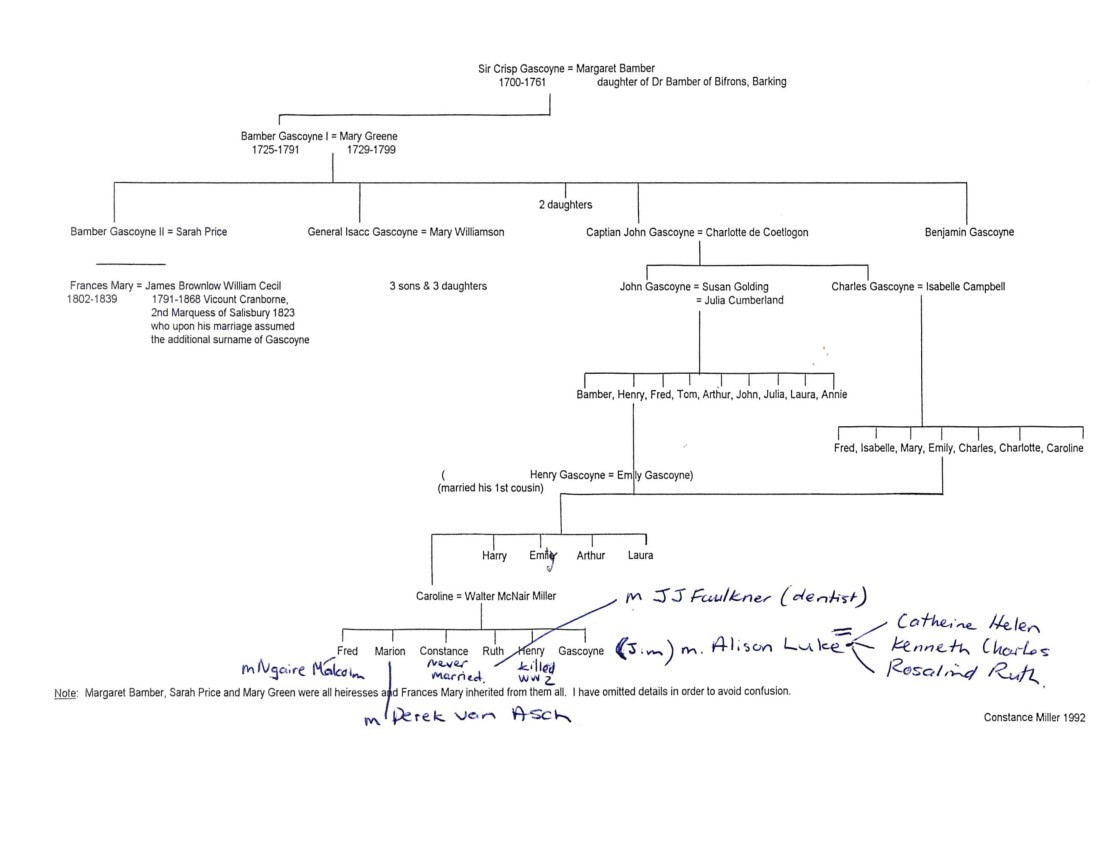
FORWARD
It was only after Isabelle Gascoyne’s memoirs had come into my hands that I decided to put together the scraps of information I had gleaned over the years on the different members of the family from which I had descended – their background and their life in New Zealand. I had always known the old story of how, in the days of Henry IV, the Lord Chief Justice of the King’s Bench, Sir William Gascoyne, had sentenced the young Prince Henry to a short term in prison for slapping his face during a court hearing, thereby establishing the authority of the law over sovereignty, an authority that Henry IV had acknowledged; and I was fascinated, while on a visit to London, to see that the scene was depicted in a large mural behind the throne in the House of Lords. I became curious about Judge Gascoyne’s descendants. However, I decided that I would have to skip a few generations before beginning my story. Isabelle Gascoyne’s memoirs cease with her arrival in Nelson, so from there on, I had to do a great deal of research, and there are still gaps which I have been unable to fill.
I wish to thank Margaret Black for her valuable assistance with research, and my brother F W G Miller for his advice and encouragement, and all those members of institutions in Australia and New Zealand, as well as individuals, who answered my letters requesting information.
Constance M M Miller M.A., DIP. E
Hastings
Hawkes Bay
New Zealand
1992
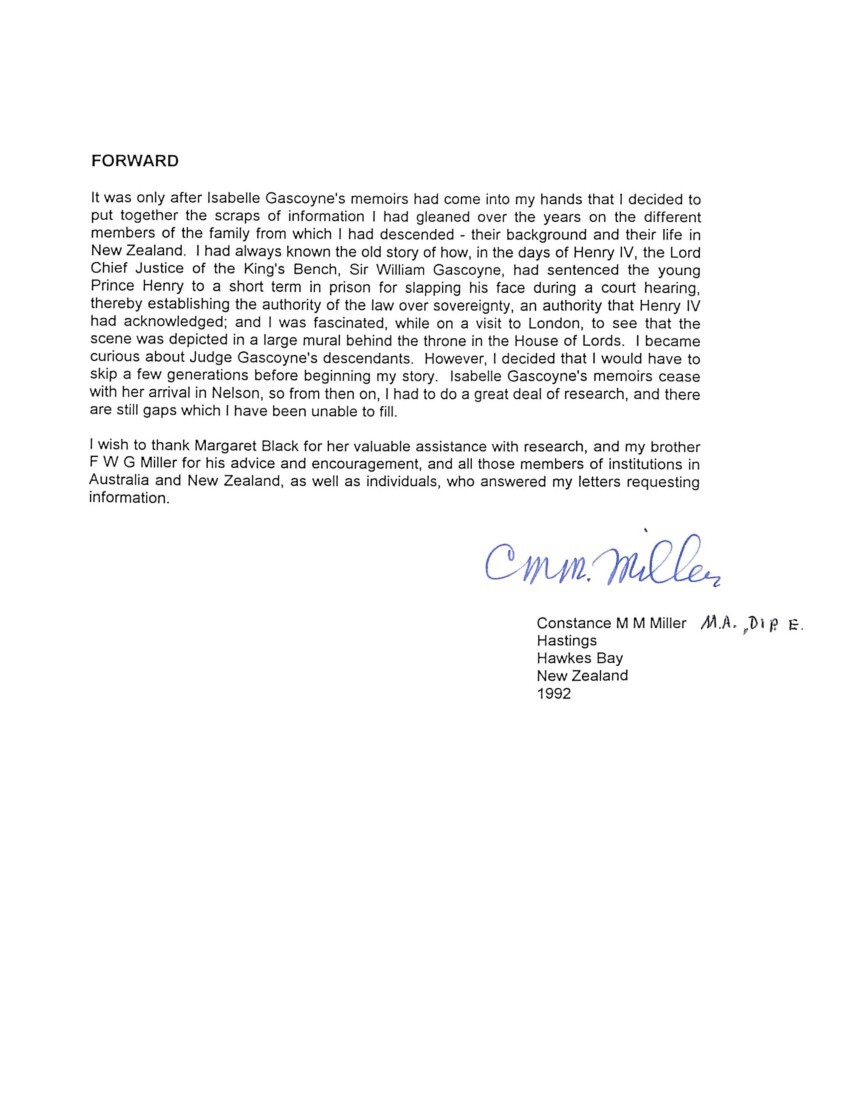
INTRODUCTION
Most pioneer families have a story to tell, but because the members are too fully occupied or lack the inclination, many of these stories are left untold. This is New Zealand’s loss, for they are a link with Britain and her colonial past, rich with the colour and culture of other lands, and are too, part of our early history.
As I began the story of the Gascoynes who emigrated to Australia and New Zealand in the middle of the 19th century, I realized that it would be necessary to delve into and describe their background in order to give my readers some idea of the tremendous adjustment they must have had to make in settling in an entirely new environment, so far removed in every way from what they had known. Indeed I doubt if that first generation and their children ever did completely make the adjustment.
No doubt my story will be patchy. There will be gaps, incomplete picture and some omissions; but as far as possible, it will be a record of true happenings and real people as I came to know them through my study of old papers, letters, diaries and memoirs, various records and biographies, and also from the live accounts of past happenings so frequently and vividly related to me by my mother, herself a Gascoyne on both the maternal and paternal side of the family.
My mother was an exceptional character, contented, sweet-tempered, unselfish. She loved her six children dearly without being ambitious for them. She died in her 94th year, never having been in hospital or suffered a serious illness, and outliving my father by a good 20 years. My father was much more reserved and quiet, a lover of the outdoor life. Owing to his having been seriously wounded in action in the battle of Bothasburg during the Boer War, when he was a very young man, he had to spend his life in secretarial work, rather than follow his natural inclination for an outdoor occupation. He enjoyed gardening, tramping and fishing, keeping up these interests as long as his health allowed. He was the eldest son of Walter Miller, an inspector of stock for New Zealand, and a grandson of a well-known Otago settler who owned the Teviot and Roxburgh Stations, and after whom Miller’s Flat was named. But I do not intend to tell the story here of this side of the family, other than to mention the fact that they had been Scottish borderers and had their origins in the town of Roxburgh in Scotland. On my mother’s side however, I have been able to trace my ancestry back to 1700, and there begins a tale that reads like a romantic novel.
From the time we were quite young, my brothers and we sisters would listen enthralled to the scraps of stories and information that my mother used to pour out to us, stories of the past that seemed to have little relevance to our daily lives, but which we never failed to find fascinating no matter how often they were repeated. I think now, that my mother withdrew into this world of strange happenings, almost a dream world, to escape for a little while from the daily routine tasks of her life. She had not been trained to cook and sew for a big family, and she knew absolutely nothing about budgeting. What could not be paid for was simply not bought. Things were certainly not easy for her (nor for my father) but she never complained, accepting her life as it was, and was very happy. Our wise family of recent years, once said to me, “Write down everything your mother tells you about the past,” but even though one may realise that the old have precious memories and that their time is short, it is difficult to do this. We tend to shut our minds to the thought that the inevitable death of someone we love is near at hand.
Later I was full of regret that I had neglected so important a task, and that I had to depend so much on my memory and that of my sisters and brothers, and that there would be many questions that would remain unanswered.
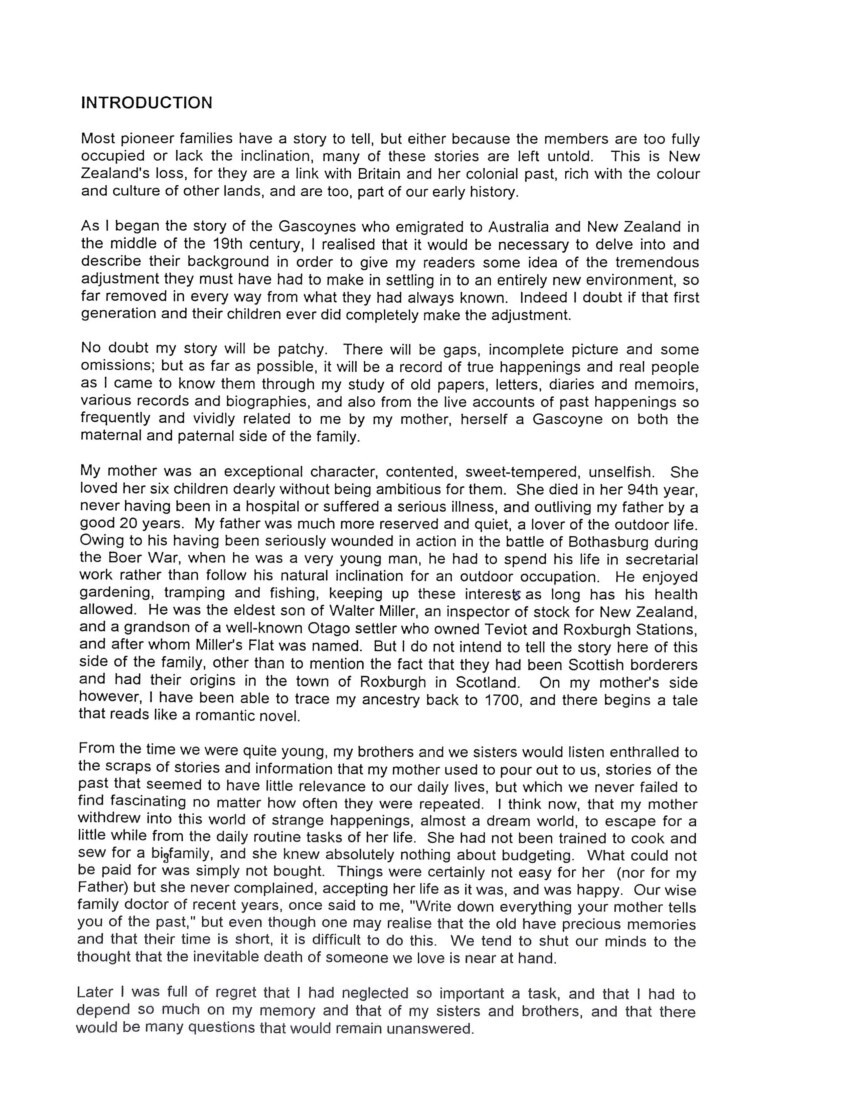
Page 2
Nevertheless there were many interesting papers and old letters – one especially helpful, which was written by my maternal great-grandmother, Isabelle Gascoyne, to her grandchildren to explain who exactly they were, and how they had come to be living in this country.
Isabelle Campbell had married Charles Gascoyne, and her letter written in 1888, when she was 78 years old, did not come into my mother’s hands till long after my own grandmother, Emily Gascoyne, was dead. We had difficulty in deciphering some of it, but as far as possible, I shall set it down just as it was.
AUTHOR’S NOTE: The name “Gascoyne” was originally spelt ‘Gascoigne’ and some branches of the family later adopted the old spelling again.
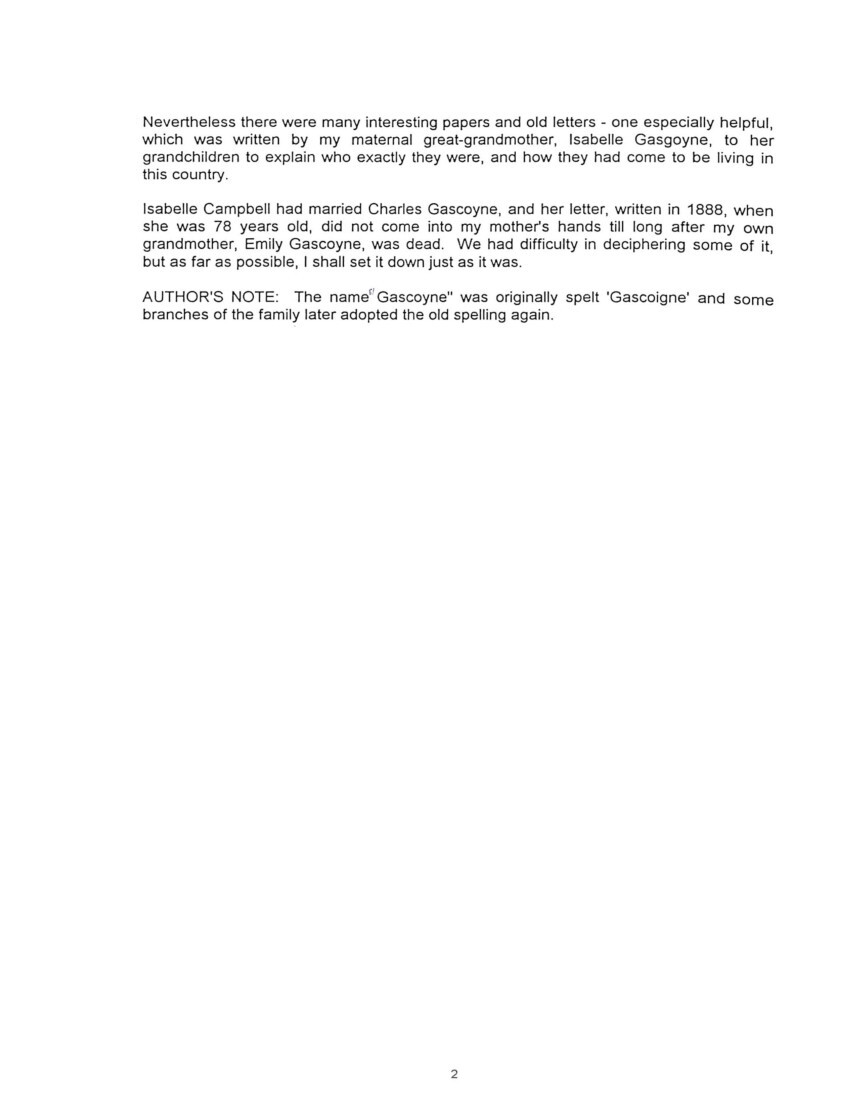
Page 3
CHAPTER 1
ISOBELLE [ISABELLE] GASCOYNE TELLS HER STORY
Letter written by Isabelle Augusta Eliza Gascoyne from Nelson, New Zealand, for her grandchildren.
“As my children and grandchildren, from being brought up in this colony, know little or nothing of their family history, I intend, God willing, putting down for their information whatever I know on the subject, together with any reminiscences of former days which may interest them. I shall deal with both sides of the family, my own family, and the Gascoyne connections by my marriage.
In 1751, Isaac Greene of Prescot and Childwall, Lansc., married Mary Aspinwall, heiress of Sir Gilbert Ireland of Hale and Hutt. They had two daughters, one of whom, Mary Greene, married Bamber Gascoyne, eldest son of Sir Crisp Gascoyne (1770-1761) at one time Lord Mayor of London, and Margaret Bamber, daughter of Dr John Bamber of Bifrons, Barking. Mary Greene became Lady of the Manors of Childwell, West Derby, Wavertree, Everton and Much and Little Woolton. Of her marriage with Bamber Gascoyne, four sons survived – Bamber II, Isaac and John and Benjamin. Bamber II, who inherited large estates, married an heiress, Sara Price, and their only daughter, Frances Mary, inherited all their wealth and lands. She was known as the Gascoyne heiress, and her story has been told elsewhere. Suffice to say, that on her marriage to James Brownlow William Cecil, Viscount Cranborne, later 2nd Marquess of Salisbury, her husband assumed the additional surname of Gascoyne, and since then the House of Cecil has been known as Gascoyne-Cecil. Frances Mary, my husband’s first cousin, died in 1839 at the age of 37, and the present Lord Salisbury is her son. But was not only an heiress; she was beautiful, witty and highly intelligent. Her education had been far beyond that of most cultured ladies of her day, and she brought much more than mere wealth to the illustrious family into which she married. Her keen interest in politics and her deep understanding of them, gave her the entrée to a society predominantly male.
Isaac Gascoyne, of Raby Hall, Liverpool, was a very rich man, and he too married an heiress. He was the second son of Bamber I, and as was customary for a younger son, took up a military career and rose to the rank of General. He was a member of Parliament for Liverpool for 28 years, and was offered a baronetcy, which he declined, saying that he was prouder of being Her Majesty’s oldest commoner than he could be of being her youngest baronet. His town house was in South Audley Street, and a very grand old house it was, with a large porch on pillars in front, and with magnificent marble mantle-pieces, statuary and old family portraits. I was introduced to the old General after my marriage to his nephew, and took the older children on one occasion to spend the day at 71S Audley Street. General Gascoyne had three sons, Frederick, Henry and Charles, all of whom became Generals. One son later bought an estate in Ireland, another settled in Argyllshire, and the third in Yorkshire. There were also three daughters.
I now come to John Gascoyne, my husband’s father. As a younger son, he was entitled to a third of his father’s personal property, (valued then at 50,000 pounds) but as it consisted principally of plate, pictures and a library, and John was then a bachelor, he gave it up to his brothers on receiving an annuity from then of some hundreds a year.
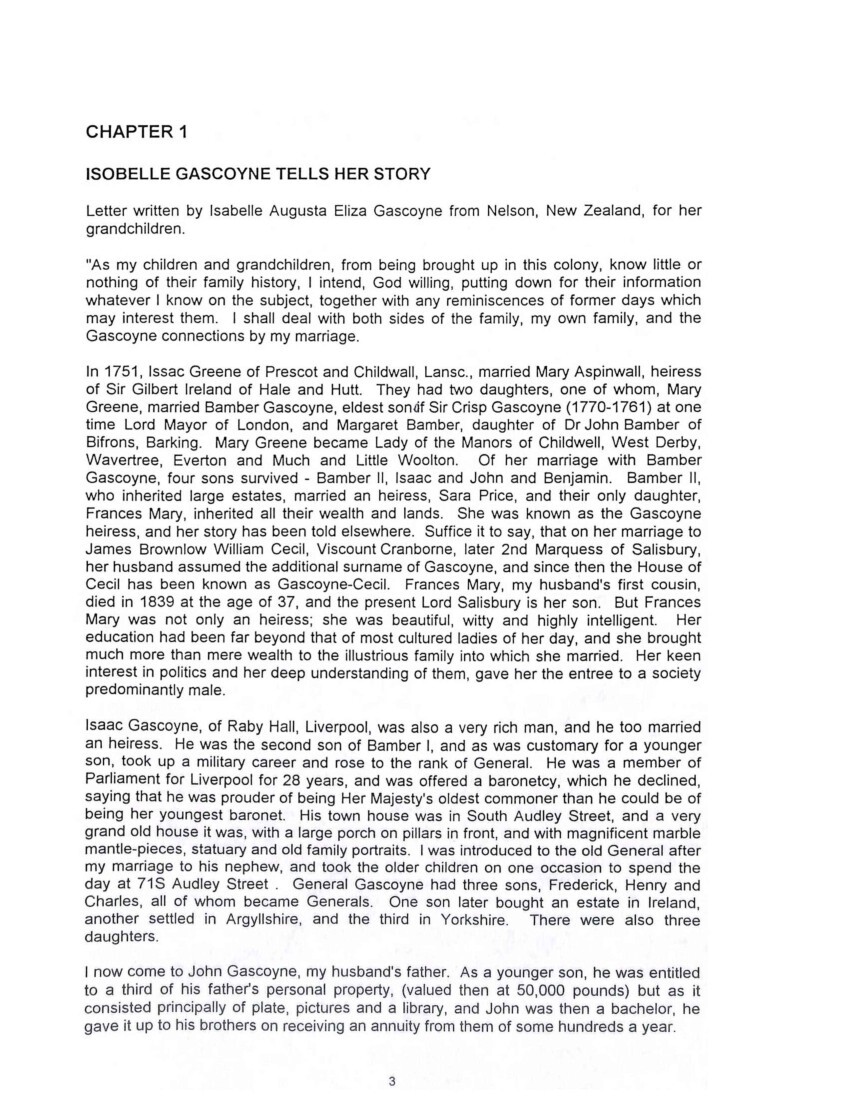
Page 4
He was at that time a Lieutenant in the Royal Navy. He afterwards married a Miss Charlotte de Coetlogon, only daughter of the Rev. Charles Edward de Coetlogan, of a noble French Huguenot family, who had been chaplain to one of the royal dukes and had fled from France with his wife and daughter at the time of the French Revolution. Mrs John Gascoyne, nee de Coetlogan, was the mother of two sons – John William and Charles Manners and four daughters. Of the latter, one died in infancy, the second at 18, the third, Mary, remained unmarried, and at her parent’s death, received a pension of 100 pounds a year from Lord Salisbury; the fourth daughter, Sophie Grosvenor, married beneath her social position, a Mr Williams, the son of an innkeeper at Bridgewater, and thereby offended her rich grandfather de Coetlogan so much that he made a new will, leaving a handsome house in London, plate, pictures and 30,000 pounds to a perfect stranger, a young lady whom he wished his grandson Charles Gascoyne to marry on his return from India, not knowing that he had already been married to me three months when he received his grandfather’s letter. Aunt Sophie had a large family. She was always her mother’s favourite, but I thought her selfish and cold-hearted and her children too. Her eldest son became a clergyman, but he was a confirmed drunkard and a disgrace to his profession. He came out to New Zealand not so long ago, and behaved so badly in Wellington that several gentlemen jointly subscribed and paid his passage back to England. Aunt Mary died some years ago, but Aunt Sophie, as I write this letter, is in her 80’s and living in London. (Author’s note: All people mentioned are long since deceased).
John Williams, my husband’s elder brother was married twice, first to an elderly widow lady, a Mrs Susan Golding, when he was only 18. She had a large fortune and a beautiful estate on the banks of the Thames. John has received from his Uncle Bamber an appointment in the War Office, but this he threw in, on his marriage, and became an idle, fashionable man-about-town, driving his carriage and four, and enjoying his new station in life. His wife died four years after their marriage, and it was then found alas, that she could only will half of her property to John, about 20,000 pounds, I believe, the rest going to her children by her first marriage. Your grandfather Charles, my husband, when a boy, paid a visit to his elder brother in his grand house in Devonshire. John was very kind to his old wife apparently, but very unwilling to let her spend any money in case she wasted it; and he used to beg her to sit well back in the carriage when they were out driving; otherwise her old face, instead of that of a young and pretty women, would spoil the whole turnout. All this however was said in joking good-humoured manner. John was the best tempered of the family, but loved money, becoming very mean and careful latterly when he had lost most of his fortune in railway speculations. But he had great charm, and a fine presence; and he married again, this time to a Miss Julia Cumberland, daughter of Admiral Cumberland. The admiral had three daughters, all good looking, but the youngest Julie, was considered a great beauty. She was called the ‘Star of Devon’ at balls, in Plymouth, where her father was in command and where your uncle met her. They married shortly afterwards and had seven sons and three daughters. The eldest son, Bamber, went to Australia and was in the Mounted Police in Melbourne and the Gold Coast. He came to New Zealand, while still a young man, because we were settled here, and very soon married. They had three children, but their young lives ended in tragedy. They were all barbarously murdered in the White Cliffs Massacre in Taranaki; and not only did the Government take no steps to punish the murderers, but about a year ago, actually pardoned the chief one and presented him with a medal for saving the life of a Maori comrade who was drowning.
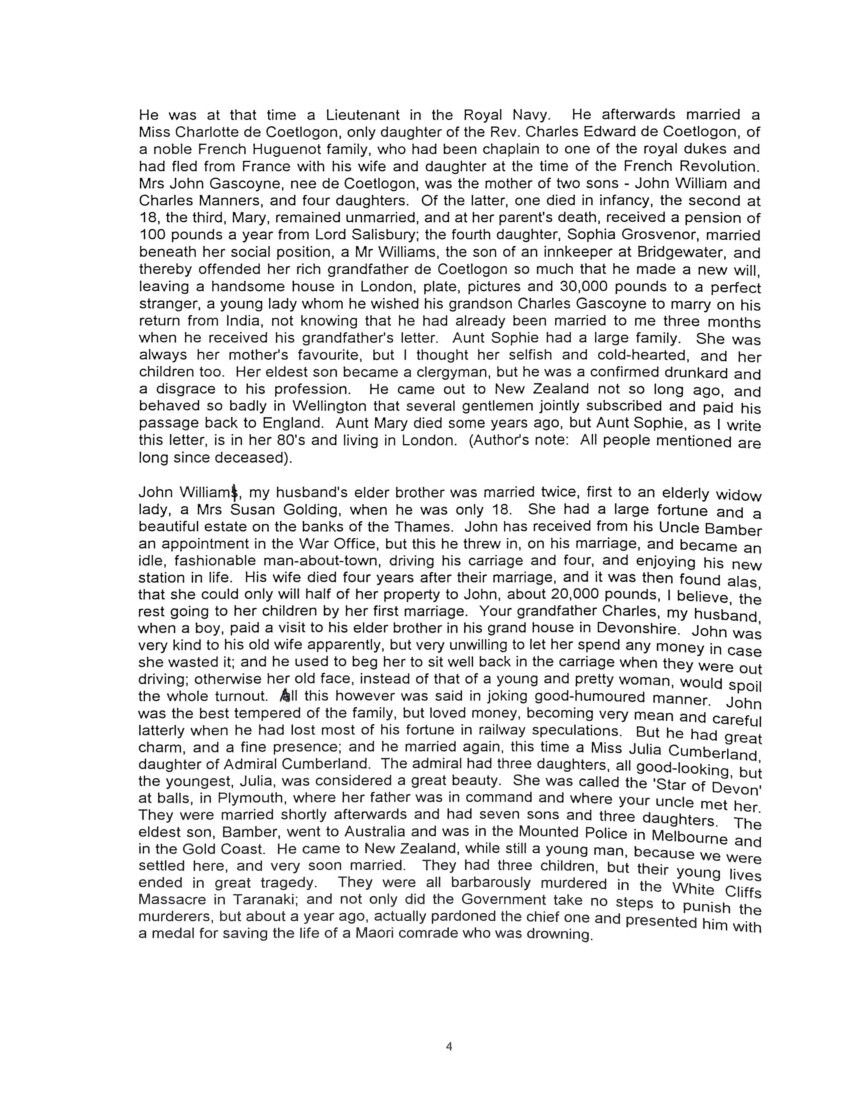
Page 5
Four other sons emigrated, Frederick to New Zealand, where he died in 1882, Charles to Melbourne, dying there in 1886, and Henry and Arthur to New Zealand. Henry married in New Zealand my daughter Emily, his first cousin, and they became your parents. Of John’s daughter, Julia the eldest died at 16, Laura is now Mrs Cumberland, and Annie is Mrs Hidow. Both live in England, and correspond with us.
I now come to my husband, Charles Manners – your grandfather Gascoyne. He received a commission in the East India Company Service, from Lord Salisbury who had married his cousin and left home. His parents at that time resided in Swansea, South Wales, his father, Captain John Gascoyne holding a Staff appointment in the Royal Navy. Charles was appointed to the 5th Regiment of Bengal Light Cavalry, to which regiment my brother, Archibald Campbell, who went out about the same time, was also appointed. They became devoted friends and remained so throughout life. My brother afterwards removed to the 1st Bengal Cavalry. Before your grandfather Charles left England, being then about 18 years old, he had become engaged, but after seven years, the young lady broke off the engagement not wishing to go out to India. In 1835, Charles and I met at Cawnpore. I was on my way to join my brother at Meerut, and was under the charge of the Honourable Mrs Ramsey, wife of General Ramsay, and sister-in-law of the then Governor-General of India, Lord Dalhousie. We had a large fleet of boats going up the Ganges and halted for three or four days at Cawnpore. While we were there, the officers, among whom was Lieutenant Charles Gascoyne, gave a great ball, at which Mrs Ramsey’s only daughter Anna, and I were present. The arrival of young ladies in those days caused quite a sensation, and we were made much of, each officer trying to outdo the other in engaging our attention.
We resumed our journey to Meerut shortly afterwards, the Ramsey’s by river; but I, at my brother’s expressed wish, had had a palanquin-dawk made, for by this means I should reach him more quickly. And with a guard of two sepoys on horseback, I started on my long overland journey alone, being well provided with every comfort, wine – I remember I had never tasted Constantia before – and various other good things all placed in my palanquin by Lieutenant Gascoyne, my brother’s most intimate friend, as we parted. At 7 o’clock in the evening, after about an hour of travel, I heard a horse galloping behind the plaque. The servants were in front, so I opened the door and looked out. There was Lieutenant Gascoyne. I felt frightened at first, but he assured me he had only galloped up to see that I was safe as far as the first stage, and in case I wanted anything. Six weeks from that date we were married.
And now I go back to my own early history. My mother’s father, Major Munro, who is mentioned in the American War of Independence, as having raised a company of soldiers at his own expense to fight for England, had an American wife. They had three sons and two daughters. The eldest daughter, Annie, married Mr Pasea, a very wealthy man who owned the greater part of the Island of Trinidad. The younger, Eliza, who later became my mother, being still a child when her parents died, was adopted by Lady Heneage Osborn, daughter of the Earl of Winchelsea, and wife of Sir George Osborn, a brother officer and inseparable friend of Major Munro. Lady Heneage and her sister, Lady Helen Finch, lived in a grand old house in London, to which I, when a child, used to be taken in a queer old carriage with a lame coachman, and a hump-back footman in gorgeous livery, in attendance.
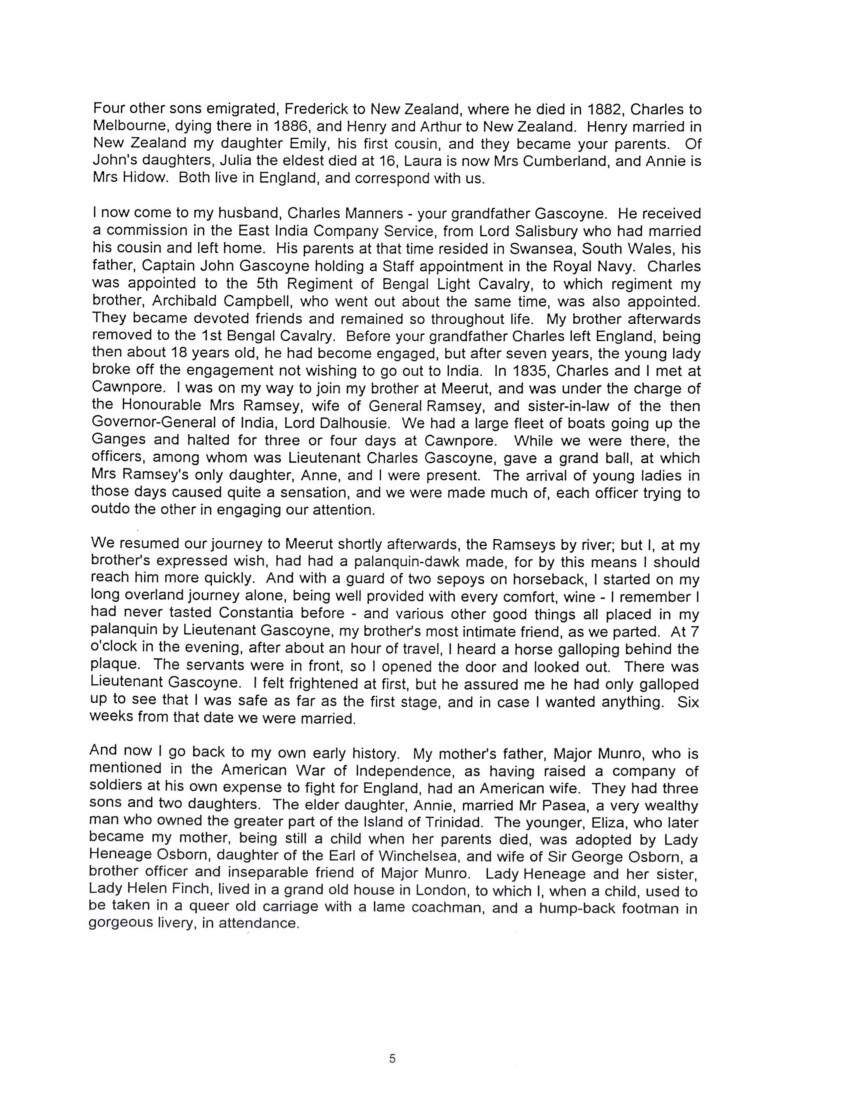
Page 6
Everything in the house looked strange to me, the drawing room full of tables and chairs with curious twisted legs and grinning monsters, and the sofas, curtains and hangings all of faded, thick blue satin damask. Lady Heneage was a dear kind old lady and very fond of me, but I thought Lady Helen stiff and cold. She always dressed in the style of Queen Anne, with her hair powdered, a gown with peaked bodice, elbow sleeves and lace ruffles, together with very high-heeled shoes. Lady Heneage dressed as a widow. They both outlived my poor mother who died in 1820, by several years. My mother received a very superior education. She became an accomplished musician, and sang Scottish songs especially well and with such expression that in India once, she fainted at the piano from the crowd that pressed round her. She spoke French fluently and also sketched well. On leaving school, she visited Scotland and there she met my father, Captain John Campbell, just before he sailed for India, and became engaged to him. The late Lord Glenely, Charles Grant, and his father Sir Robert Grant, afterwards Governors of Bombay, were related to my mother; and Lord Glenely, who was an East India Company Director, gave commissions or cadetships to my Uncle Archibald Campbell, my mother’s favourite brother-in-law, and to my father.
My mother followed my father to India about two years after her marriage, going out in the ‘Sovereign’ an East Indiaman, accompanied by her brother Archie, who would not allow her to go without his protection It was a long and rough passage in those days from Cromarty to London, and they were nearly taken prisoner by the French in 1806. My father, John Campbell of Dunstaffnage, was a medical officer, attached to the 7th Madras Cavalry, as was also my Uncle Archie. My mother remained five years in India, when her health failing she returned to England with her four children – Alexander, Archy, Osborne-Heneage and me – a baby in arms, with an Irish nurse named Bennett. She stayed in Scotland visiting Dunstaffnage and other places and finally Cromarty and Elgin. At the end of five years, in 1816, she resolved on joining my father again in India, and accordingly placed her boys under the care of a Dr and Mrs Brown at Cheltenham I was placed with a single lady at Bath, and for a child of only five years old, was very cruelly used, being forced to learn music and matters far beyond my powers or inclination. I remember when I would not or could not do my lessons she used to hold my head down in a basin of water until I was almost choked. She wished to have five more pupils but as none were forthcoming, she wrote to my guardian and took me up to London, were I was placed in a large boarding school in Cadogan Place. There I was dressed immediately in deep black and told that my father was dead.
While we were out walking one day – I was about six years old – a kind looking stout lady stopped us and asked the governess my name. Upon hearing it, she took me in her arms and embraced me many times begging that I might be sent to her house every Saturday till Monday, while I remained at school. She was a Mrs Skinner, the widow of General Skinner, and mother of three daughters. Her maiden name was McLean – she was a relative of Sir Douglas McLean, well known in New Zealand, and also a connection of the Campbells of Dunstaffnage.
After I had been at school for a year, more or less, I was roused one night from sleep, at about 9pm, taken up and dressed, and placed in a closed carriage with a footman inside, and driven a long way to Kensington, where we stopped at a well-lighted house. I was ushered into a room full of company, who kissed me and murmured, “Poor little thing”. In the morning, I was driven by my uncle to an hotel in a quiet part of London. We went upstairs to a drawing room which look very dark and dismal, for the curtains were drawn; and I saw at the far end of the room a lady in black lying full length on a sofa. In an instant I knew it was my dear mother whom I had never forgotten and had often tried to go to. She clasped me in her arms, and I would not be parted from her nor leave hold of her hand for a minute all day.

Page 7
I next recollect my brothers coming for a short time. It was then arranged that they go to a school at Putney, and my mother took part of a house, the drawing-room floor, in Lisson Grove, and sent me as a day scholar to a Miss Payton, who took pupils in a house a few doors away. My mother never recovered from the shock of my father’s death, which had occurred just as she had reached Madras. She had gone out in a ship commanded by a cousin of my father. In the “Madras Roads”, as the sea is there called, no vessel can approach the shore owing to the vast rollers, three waves in succession, which race in towards the beach. Therefore when a vessel is sighted, queer-looking natives with high conical caps of straw in which they place letters or papers, push off from the land on two logs tied together called “catamarans”. Upon the first one reaching our vessel, everyone crowded round to hear the news. Captain Campbell, not observing my mother among the crowd, read aloud, “John Campbell, Dunstaffnage, is dead. He died of Cholera after a few hours of illness caught while attending at the hospital”. My mother fainted and became afterwards very ill, for she and my father were most deeply attached to each other. Some of their beautiful letters are still in my possession.
My mother returned home and lingered for four years in Lisson Grove, where she died. She was attended by Sir Astley Cooper, Sir James Clark, Dr Abernethy and other famous doctors of the day, who would not receive fees, because she was the widow of a medical officer. I saw my mother in her coffin and never forgot her, grieving for months over her loss. After her death I became a boarder at Miss Payton’s and was very unhappy, so that when my guardian, Mr McKinloch, a great friend of my father and mother, came back to London from India, and saw me, he sent me to another school, at Clapham, kept by a Miss Montier, where I remained for two years. Two Grants were my school fellows, one the mother of the Rev. Mr Hutchinson of New Zealand, and the other became Mrs Thomason, wife of the Governor of Agra. Mrs Burn, the Bishop of Nelson’s mother, was also my school fellow, and Miss Kissling of Auckland. Lady Heneage died while I was at School at Clapham. She wished to leave me a legacy, but her sister would not allow it. I next went to school at Oxford House, kept by two old ladies, Miss Priscilla and Miss Susannah Brown. The elder always worn a turban, was very stately and dignified, and the whole school system was different from anything nowadays.
When out walking in the parks two by two, a governess at every fourth row, we were obliged to wear green veils and turn our eyes to the wall if any gentleman passed. Miss Priscilla always spoke of men as “odious creatures, necessary evils”, and advised her pupils not to marry. We had several masters who attended the Queen – Monsieur Riviere who took us for drawing, and a M Sacre and Mr Jenkins who taught dancing. There were about 60 pupils and we had a dear old French governess who could not speak English, so we just had to become proficient in the French language. Our manners, our walk, accent, how to eat and drink gracefully, how to sit down, how to converse – all these were strictly attended to along with many other graces – matters which nowadays seem to be totally neglected.
I used to spend my holidays at 47 Montague Square, the house of my guardian Mr McKinloch of the Mercantile House “Rickards, McKinloch and Co”, whose failure afterwards ruined many rich old Anglo-Indians. My guardian was supposed to have retired from India with a fortune of 30,000 pounds, and he certainly lived in great style. At his house I saw many of the great men of the day, and from the age of 15 to 17 I always attended his large dinner parties. As he was then a bachelor, he would invite some married lady and her daughters to stay during my holidays, so that I could be chaperoned. In 1827, I left school and went to Edinburgh where I had relatives. From there I went to Argyllshire where my father’s favourite brother, Captain Alexander Campbell, formerly of the East India Company Service, had purchased a lovely property called ‘Inniston’, not very far from Dunstaffnage. Here we were surrounded by family
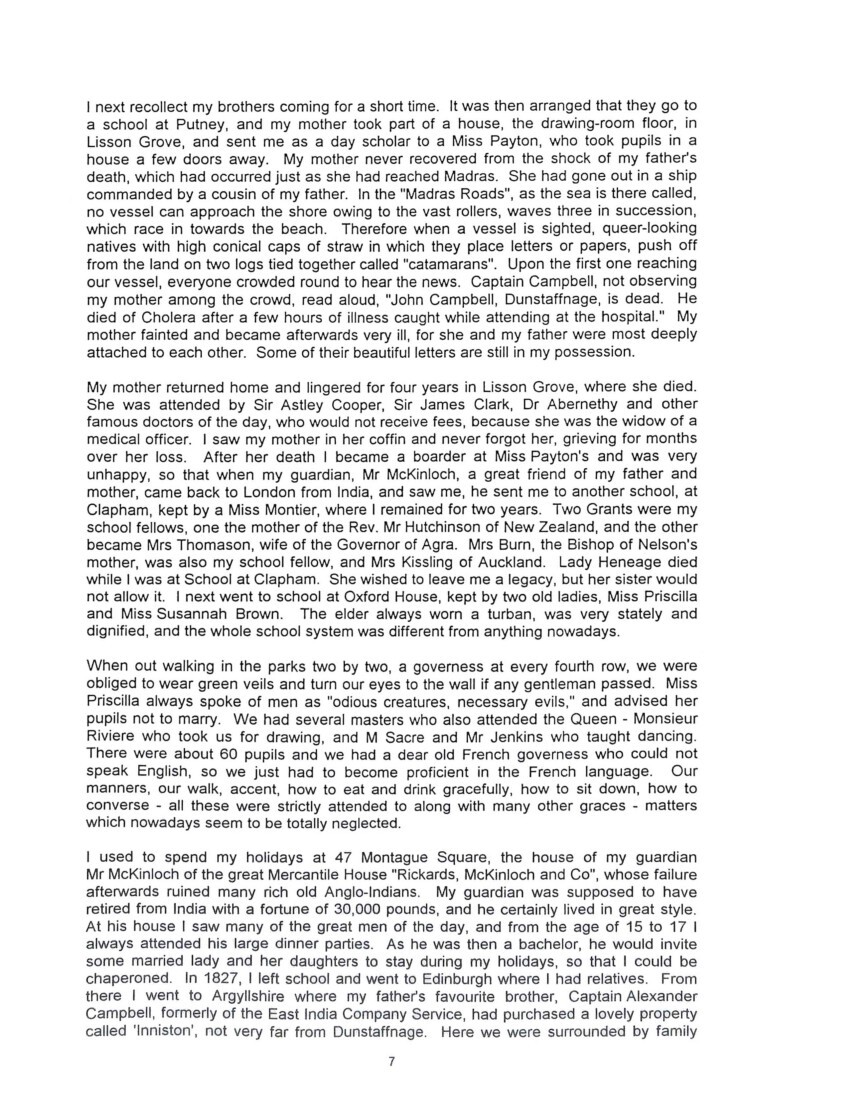
Page 8
connections, the Campbells of Lochnell, of Barcaldine, Sir John Campbell of Airds, and many others among all of whom I visited. I became acquainted with Dr Norman McLeod’s family. His father was the minister at Morven, a wild Highland parish beside one of the numerous lochs of fiords. The sisters were all talented and wrote poetry. The old Highland hospitality and customs, especially the loyalty and devoted attachment of the cottagers or dependants [dependents] on the estate, to the laird of chief, were still in evidence there. On one occasion, when my cousin Sr Donald called out a neighbouring laird named Stewart, for some slight quarrel, they met in a glen in Appin, where Mr Stewart’s property lay. After they had exchanged shots, they shook hands and were turning away when they saw a number of their relatives perched on the brow of two neighbouring hills. Upon being asked why they had gathered there, the retainers replied that had either of their lairds fallen, his followers meant to shoot the survivor.
I had received several letters from my mother’s friends in the north of Scotland begging me to pay them a visit. Accordingly I went to my godmother, Mrs McKenzie, at Cromarty, who with the dear old Captain, her husband, completely spoilt me. From that time I always considered their home as my real home, and Mrs McKenzie’s nieces, the Miss Forsyths, were like my own sisters, especially one who afterwards became blind through an unfortunate accident. She was a most accomplished musician and sang beautifully I also stayed some months in the Hebrides, visiting many places, including Iona and Mull where two of my cousins were ministers.
My brothers all received cadetships from an old friend of my father, a Mr Ravenshaw at whose house, 9 Lower Berkeley Street, I frequently stayed while in London; and about the year 1834, my brother Archy, who had always been the most affectionate, wrote urging me to come to him in India, as he had a good appointment, and could afford to send me ample means for my passage. I did not meet with any suitable opportunity however, until 1835, when the Honourable Mrs Ramsay, whose acquaintance I had made in Edinburgh, resolved to take out her family to join her husband, at that time the General in command at Meerut and the Upper Provinces. Mr McKinloch, my guardian, was written to, and he invited me to stay in his house in Montague Square while all preparations for the voyage were being made. I forgot to mention that the pension from the Madras Orphans’ Fund, 70 pound a year, had been stopped in my case when I was 16 years old, because it was assumed that my brothers had made over their share of my father’s property to me on going out to India, and that being in possession of more than 1,000 pounds, I was not entitled to the pension. This sum however, I never received from my Uncle, my joint guardian, he giving me only what was needed for my passage money and outfit, which in those days was very expensive, and which I must say lasted me for many years after my marriage.
We all embarked for India on board the “Broxbournebury”, a magnificent Old East Indiaman, commanded by Captain Alfred Chapman, one of the most delightful men I ever knew, a perfect gentleman who treated Miss Ramsay and me like his own daughters. Among our fellow passengers were several whose names were afterwards famous in the annals of Indian warfare; they were then cadets and young civilians. At the time those younger sons who entered the Military and Civil Service were far superior in birth and position to those who now compose Indian society, especially those in the Artillery and Engineer Departments. Our voyage lasted six months. We were one month at Madras, where we took in a passenger to Calcutta, the afterwards famous Lord Macaulay. I used to listen to his arguments and conversation on religious subjects in the cuddy after lunch, with Captain Chapman, and fascinating this was. On reaching Calcutta, I parted from the Ramsays for a few weeks, and was received by the Hon. Mrs Udney, who lived in the Union Bank, of which her son was manager. Her daughter,
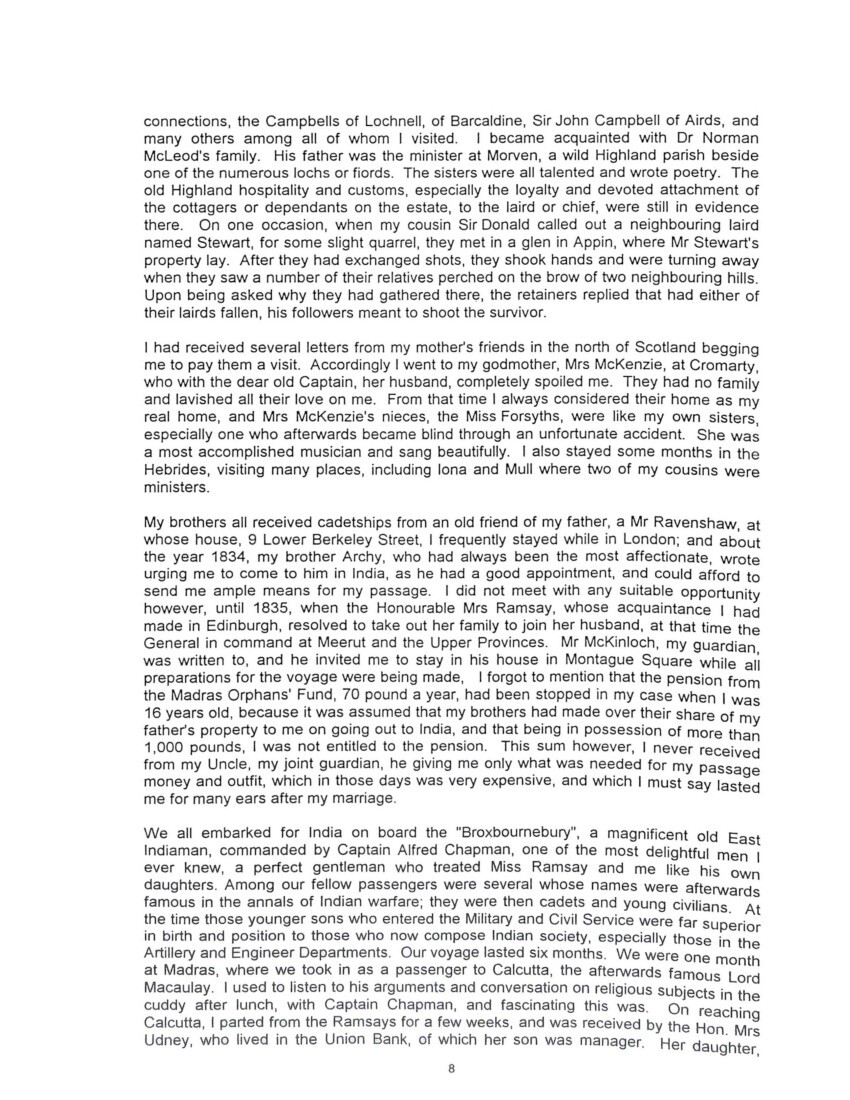
Page 9
Emily married a brother of Mrs Raikes whose family settled in Nelson While with Mrs Udney, I received numerous invitations to balls and parties, for the arrival of our party (the Ramsays) caused quite a stir in Calcutta society. I declined all these invitations, much to the annoyance of Mrs Udney who was anxious to introduce me into what she considered the best society. But I was not at the time interested in that sort of life; for I had been very much impressed by Captain Chapman’s religious opinions on worldly society, and I was besides, anxious about my youngest brother, who had been seriously ill, and whose whereabouts I had been unable so far to discover. His Regiment was the 43rd Battalion Infantry, but I did not know where it was stationed.
I spent many hours reading in the drawing room, an immense lofty room on the second floor, with many full length windows. A raised verandah outside, closed in with rattan, shut out the intense heat and glare. One day I was told that a gentleman wished to see me. Upon his entering the room I rose to greet him, whereupon he came forward, took my hand and said, “You do not know me, but I would know you as a Dunstaffnage anywhere. My name is McIntyre. My father and mother were cottagers on your father’s estate. My mother was foster-mother to your Uncle Alick, who brought me out to India. All I have I owe to him. I’m now a rich man. Can I serve you in any way?” I told him of my anxiety about my brother, and he promised to find him and let me know his whereabouts. A few days later he called again, and told me that Osbourne had been dangerously ill and sent up the River Ganges for a change. The doctor had ordered him a voyage to Europe, but he was so deeply in debt he could not leave the country. Mr McIntyre then added, “But I have seen his principal creditors, paid all his debts, booked a passage for him in the next ship that sails for England and given him money to meet all his expenses. I should be glad to do anything else I can for you”.
You can well imagine that I was overcome with gratitude and with many expressions of regard, we parted, I never saw him again. But numerous are the instances I could relate of the generous, warm hearted, noble conduct of old Anglo-Indians, giving assistance most liberally to brother officers in less fortunate circumstances and providing for their widows and orphans
In about six weeks or two months, Mrs Ramsay having hired a fleet of boats for our party, which consisted of herself, her two sons, aged 14 and 16, her daughter and me, together with about 30 servants, we started out on our long voyage by river for Meerut, at the rate of about 20 miles a day. There was one large budjerord, one smaller in which I was to sleep, a cooking boat and several boats for baggage and for accommodation for servants. When the wind was favourable we sailed up stream, but with a strong current against us, we generally had to be pulled along beside the bank by dandies or boatmen, who carried long ropes over their shoulders. At night we anchored or drew up as close to the bank as we could, a plank then being thrown across to enable us to get on shore. It was a picturesque sight, the innumerable small fires all around and the native servants, several of whom had their wives and families with them, squatting in groups, chatting, singing and smoking their hubble-bubbles (hookahs), or recounting the events of the day in Hindustani. This language I soon picked up, becoming very fond of Ayah, or lady’s maid, who taught me we were entertained at the different military stations through which we passed and this broke the tedium of the journey. On our reaching Cawnpore, an unfortunate accident occurred. My budjerord, while I was at dinner in Mrs Ramsay’s boat, struck on a sunken log and immediately began to fill. The other boats all stopped and the crews assisted my men to get my trunks and baggage on shore; they succeeded in saving everything. Fortunately arrangements had been made for me to proceed by dawk so it was not of so much consequence.
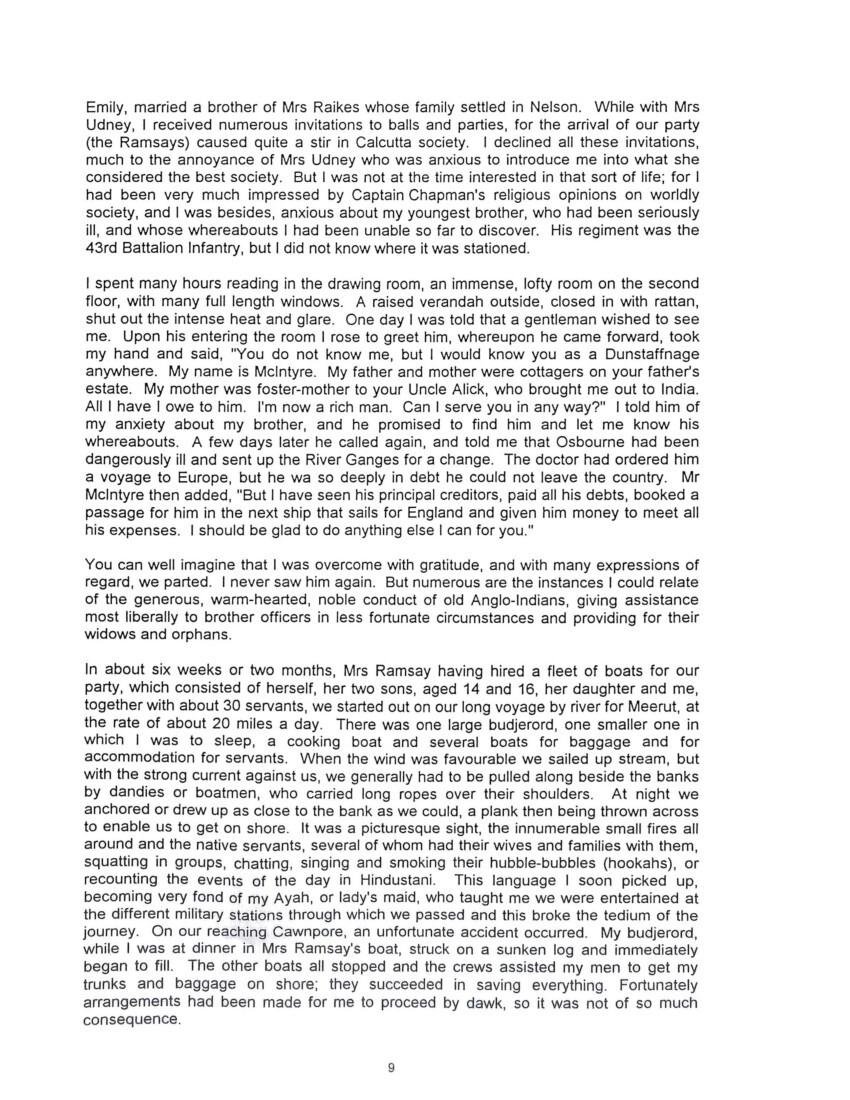
Page 10
I reached Meerut in about 43 hours, travelling night and day, and changing my 12 bearers every 12 miles. My dearest brother Archy rode out to meet us. We had been parted for 10 years. I found that the doctor attached to the 5th Cavalry was the son of a gentleman at Cromarty, and I had known his family the Davidsons, well. I was therefore soon quite at home with him and his wife. They were most kind people and their baby boy was a great pleasure to me. He is now Mr Edward Davidson of the ‘Spit’, near Collingwood, with a family of 10 sons and daughters. He married a Miss Mackey of ‘Drumduan’, Whakapuaka.
A fortnight after I had reached Meerut, the Ramsay party arrived, and my brother received a letter from his friend, Lieutenant Gascoyne, saying that he had asked for leave of absence for a month, and would be at Meerut almost as soon as his letter. As it was in the middle of the Parade, or cold season, he had to apply for leave “on urgent private affairs” as he put it. Otherwise he would never have got it, for he only wanted to get married, as he told me afterwards. We were married in February, 1835, before the end of the month, by special licence. I had only one bridesmaid, Anne Ramsay. Shortly afterwards, we left, and proceeded to Cawnpore, where my husband’s regiment, the 5th Cavalry, was stationed. The officers and their wives seemed to me like one family, with colonel and Mrs Kennedy as parents. The latter had two daughters married in the Regiment, Mrs Alexander and Mrs Blair. They, alas! Together with many more dear friends of ours, were murdered in the Mutiny of ’57.
While at Cawnpore, we were all invited to a party given for the military and civilians by the very same Nana Sahib who was the chief agent in the Cawnpore Massacre, and in the very same building we spent the evening, entertained by Nautch girls. A short time before 10 o’clock, I observed to my husband that the native servants were shutting all the doors and windows and becoming alarmed. I insisted on his taking me outside, where we found the flat roof of the building crowded with spectators, watching some magnificent fireworks which the natives were letting off. My husband laughed at my fears, for I had thought they were going to murder us, I felt sure they would do so sooner or later.
My health giving way, we went for a change to Calcutta, intending to go home if it did not improve. But I rapidly got better and shortly after our return to Cawnpore, my eldest child Isabella, was born. I must here mention that my dear brother had found himself so depressed and lonely after my marriage, that he applied for leave to visit Calcutta with a view to finding a wife, which he soon did. For seeing a young lady in the Cathedral on the first Sunday after his arrival, he made enquires as to her name, residence, and family, wrote to her father, an indigo planter up country, stating his name, position and so on and asked permission to pay his addresses. He always was of an impetuous, enthusiastic temperament, warm hearted and entirely unselfish. The young lady was exceedingly pretty, her age 16 – a Miss Emily Payter. Her mother was a native lady, who having separated from her husband, lived in her own house in Calcutta, where I afterwards visited her. Emily was an only child. She had been brought up and educated by some of her father’s friends in Calcutta. Archy and she spent some days with us at Cawnpore on their journey.
My brother was one of the very few to whom marriage made no difference to his love for his sister. While he lived he was the most devoted, loving relative I ever had. He was Adjutant to his Regiment, which doubled his pay, making it in those days about 1,000 pounds a year. They had four children. The eldest, a girl died young. Of the boys, Archibald Dunstaffnage Campbell and Charles Gascoyne Campbell, Archy entered the Indian Service and retired quite young as a Lieutenant-colonel, marrying the daughter of General Ironside, and residing at Princess Buildings, Hyde Park, London. Charles
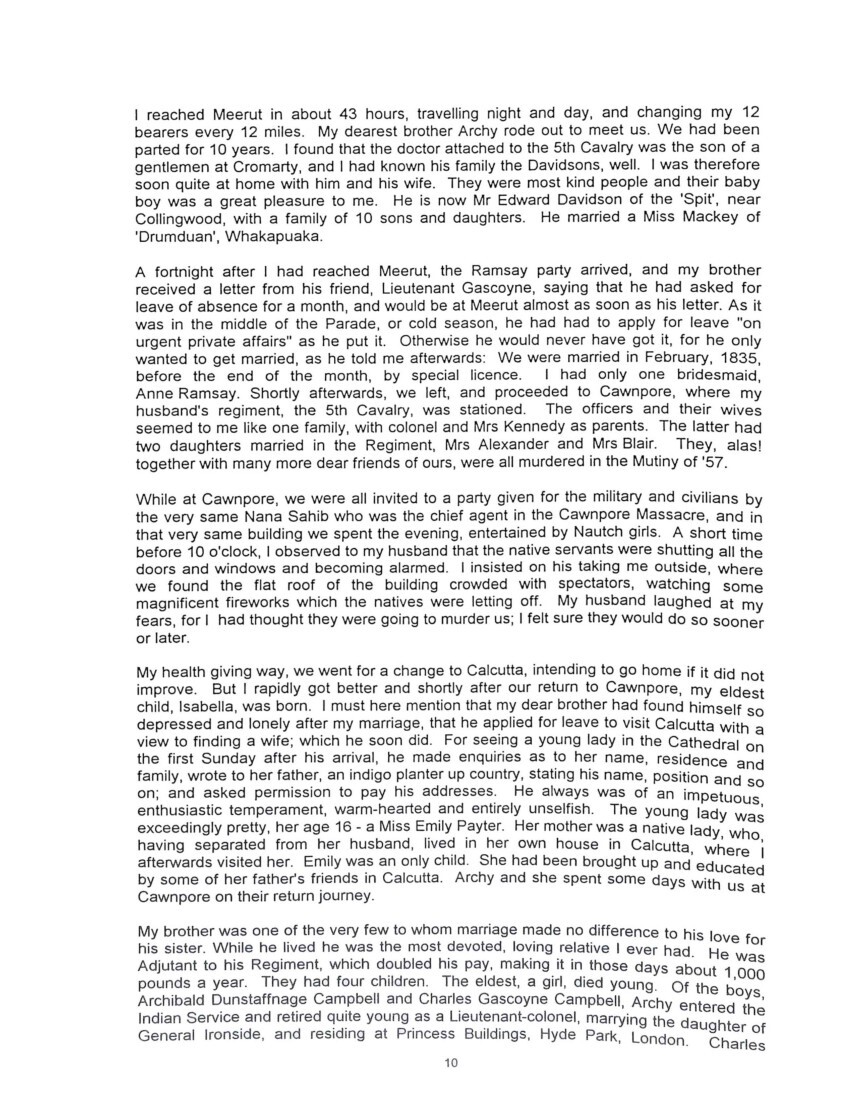
Page 11
managed what was left of his mother’s property in India. After his father’s death, his mother had married a young Lieutenant named Wyndham, of Lord Egremont’s family. He spent most of her money and was killed by falling from a balloon into a lake in Bengal; after which unfortunate happening, his widow went to England to reside near her son.
My brother Archy, in 1843, had had an attack of a liver complaint and was ordered a sea voyage. Accordingly, with his family, he started for England in 1844. They put in at the Cape, Archy being still very ill, as was also a fellow passenger named Connolly, a civilian, Dr Bickerstaff, the chief medical man, attended them both, and told them it would be madness to think of continuing the voyage until they were better. My brother replied that he must do so, for he had paid the passage money for his wife and family to London, and could not afford to lose it. Mr Connelly, who was present, entreated him to remain, as he himself intended doing adding, “Here is a cheque, my dear friend, for 1000 rupees, and draw upon me for as much more as you need”. In one month they lay side by side, in the Capetown burying ground.
My sister-in-law, with her three infant children was left a stranger without friends or means, as she thought, but the Almighty Friend of the widow and the fatherless, was faithful to His promise – “Leave thy fatherless children and I will preserve them alive, and let thy widows trust in me.” I may here mention that my father, Captain John Campbell, on his death-bed in Cuddalore, had put his bible into the hands of his trusty bearer and told him to take it to the “Mem Sahib” upon her landing, being unable to write himself, and to put it into her own hands. The leaf was turned down at that verse underlined as his last words. I have the Bible still. A Colonel Rutherford, father of the Rev. Mr Rutherford who was formerly one of the Wairau clergymen at the Cape, hearing of the sad circumstances of Mrs Campbell wrote asking if she would prefer going on in the next ship to England, or returning to Calcutta. She preferred the latter course.
He then wrote enclosing money for all expenses, having already paid her passage and associated expenses to Calcutta, thereby ensuring every comfort for herself and her children. Such were our kind and generous officers in the old East India Company Service.
In 1837, we were ordered to Muttra from Cawnpore, where my eldest son, Charles Cecil McKenzie was born. He was a lovely child with flaxen curls and large blue eyes, and with skin like snow, but at the age of 16 months on July 2 he died, just wasting away in my arms. On the morning of the 23rd, my dear son, Frederick John William, names [ named] after the General’s son and Uncle John, was born. Eighteen months after, Mary Catherine Helen was born, on the 1st January 1840; and when she was nine months old, we resolved on visiting England.
We had been on the Himalaya Hills on sick leave for six months, at Mussourie. Our house was in a lovely valley or cud and was called ‘The Hermitage’. Another bungalow just above, was ‘The Monastery’, and there Mrs Masters, a sister of Mrs Blundell and her family lived. Your dear grandfather’s health did not seem to improve very quickly, so once again all our possessions were sold and we started in janpan for Dehra Dun, a very pretty English looking village at the foot of the hills, then continued by palanquin dawk for Ictarapore and the Ganges, and hence by boats to Calcutta. I cannot give you any idea of the magnificence of the scenery of the hills with the cedar forests, the lovely valleys, full of rhododendron, walnut, cherry and many other flowering trees, and capped by the everlasting Snowy Range, the highest mountains in the world. The air, the sky and the earth are all exquisitely beautiful, and the thunder storms in the rainy season grand and awe-inspiring beyond all description.
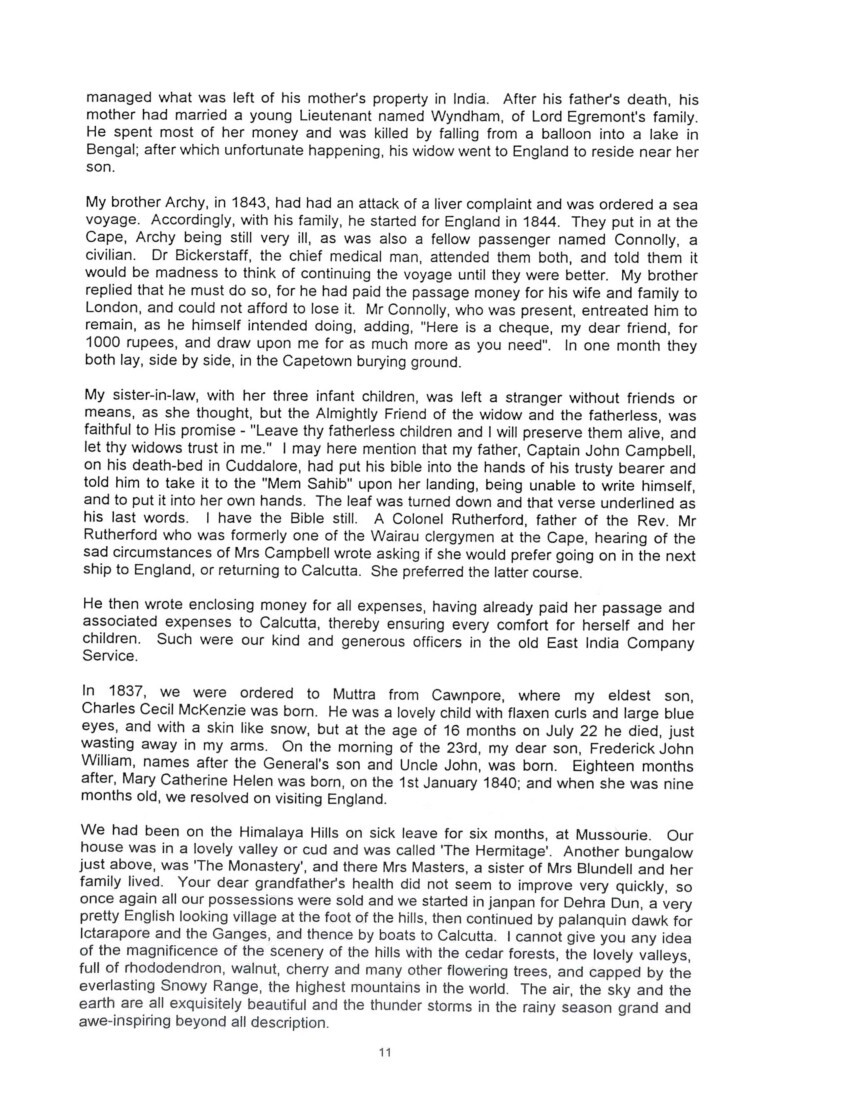
Page 12
Nothing eventful occurred on our voyage down the Ganges and we sailed for England in the ‘Carnatc’, commanded by Captain Voss. Captain Brine of her Majesty’s 19th Infantry, with part of the Regiment and the soldiers’ families were on board also. When we were about half way across the Atlantic, late in the evening, suddenly a cry of ‘Fire! Fire! was heard and smoke and flames were seen coming from the steward’s pantry which was full of wine, spirits, and other inflammable goods. The door was locked and some little time elapsed before it could forced open and the buckets ranged from the ship’s side and handed from one to another in a line, the women and children meantime shrieking with terror. It was an anxious time for everyone but the flames were soon brought under control and order was restored, by god’s mercy.
On our arrival in England, we went at once to Clifton where my husband’s family had resided for many years and were much esteemed, Mrs Gascoyne being well known for her charity and benevolence. She was an earnest Christian and a noble lady and I loved her dearly. Her daughters, Mary and Sophie did not resemble her in any way. Sophie had married her Mr Williams just before our marriage in 1835, and had at this time six children. They live in Frederick Place, a very short distance from Carlton Villa, your great-grandfather’s house.
My husband’s father was, or imagined himself to be a great invalid, and was the most considered by the whole family. Mrs Gascoyne attended to all his wants and fancies herself, always bringing him his breakfast in bed and his lunch in the drawing-room. Their income was about 600 pounds a year, but every luxury was provided for Captain Gascoyne. In short, he was a thoroughly selfish man, Mrs Gascoyne the very opposite. It is hoped that her qualities may predominate in her succeeding generations. The room that was occupied by my children was unfortunately over the drawing-room, and Captain Gascoyne soon complained that the noise of the little pattering feet annoyed him, so after much consultation with my husband, I resolved to send Fred and Mary to some dear kind cousins of mine in Argyllshire, the Rev. Dugald Campbell, who with his two sisters, Mrs Fraser and Miss Campbell, lived at the Manse some three miles from Dunstaffnage Castle. Here I knew my children would be more than welcome and thrive on Highland air and Highland fare, though I felt very much the hardship of being separated from my little ones. Isabelle, my eldest, was a very quiet, shy, reserved child and gave no trouble to anyone. She went to day school first and then a young lady teacher for two hours every day. We stayed at Clinton as far as I can remember for about 12 months, when my husband acceded to my request, (indeed in fulfilment of a promise made before our marriage) that we should visit my friends in Scotland.
On our way, we stayed for a week at Liverpool with the McAndrews, a family of rich merchants Mrs McAndrew was one of the Forsyths of Elgin, her Uncle the author of “Forsyth’s Italy”, and all of them were remarkably talented and charming. In Liverpool, my Husband was invited to dinner in the town hall, he being the nephew of the ‘old General, Isaac Gascoyne. A full length portrait of the General hung at one end of the room, recording what he had done for Liverpool during the 28 years he had represented it in the House of Commons. We took a furnished house in Elgin for a year and made various excursions in the neighbourhood, visiting many dear old friends at Nairn and Cromarty. My cousin, Mrs Fraser, also came to us for six months and here my daughter Emily Charlotte Annie Justina was born.
We left Elgin when Emily, or Amy as she was called, was about one month old, and again took up residence at Clifton. My husband, wishing to see his brother and family, who lived at Plymouth where John held the appointment of Secretary to the Royal Yacht Club, wrote enclosing a cheque for 70 pounds to pay the expenses of removing
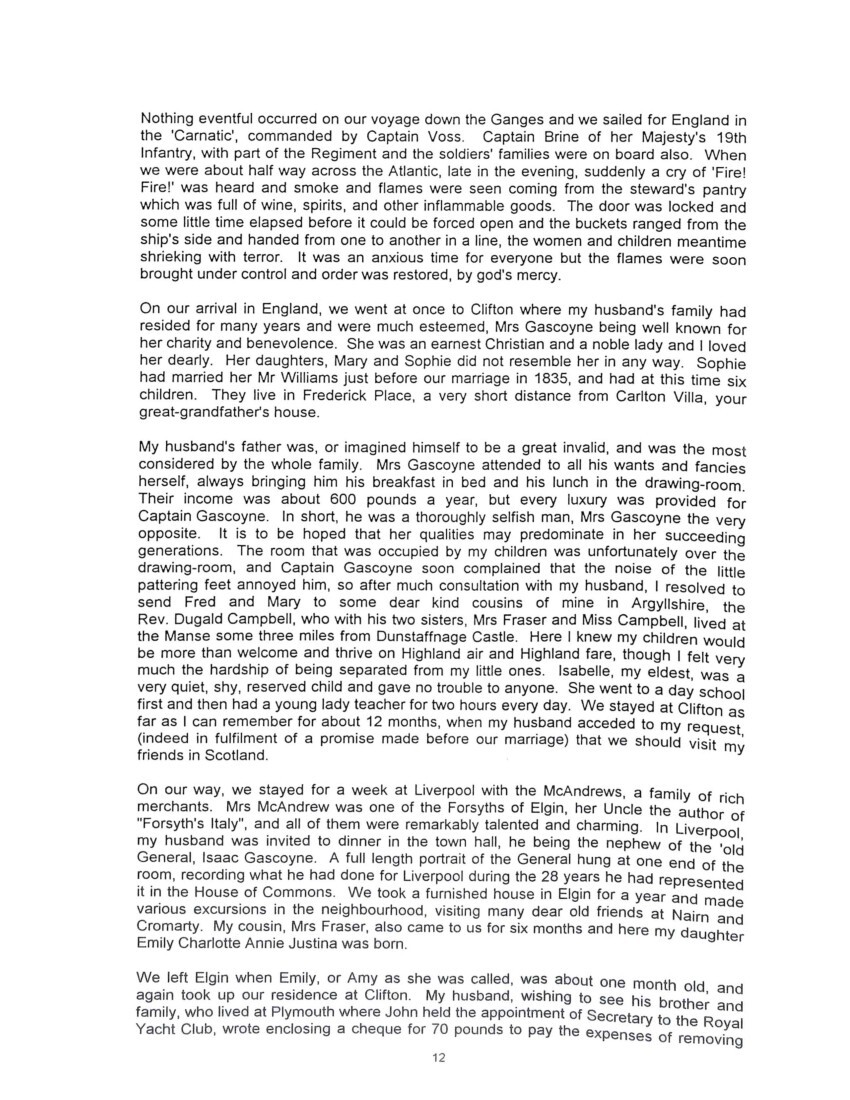
Page 13
the family to Clifton; and they accordingly arrived, Uncle John, Aunt Julia and the 10 children, and took a house Carlton Villa. Aunt Julia was considered to be a very handsome woman, but I did not admire her style and her dress was not to my taste, flamboyant and unladylike, I thought. Uncle John had a remarkably handsome figure and a very aristocratic manner and walk (as had your grandfather also.) Shortly before we returned to India, we were disappointed of some remittances. We had expected 300 pounds and knowing that Uncle John had just cleared 1000 pounds by some business transaction my husband frankly asked him if he could return the 70 pounds he had sent him on a former occasion. His reply was characteristic of the man; “My deaf fellow, how readily would I do so were this money (the 1000 pounds) a real gain, but the fact is, I can hardly call it so, having lost so much in years gone by”. He should have said not ‘lost’ but ‘squandered’. So much for Uncle John’s character. He loved money more than all else.
Not long afterwards we set sail for India, my husband’s health quite restored and much against the advice of friends we resolved on taking all our children back with us, instead of following the general plan of leaving them at school in England. I took a Scottish servant out with me, intending to send my children under her care to the hills during the hot season and thus avoid any ill consequence of the hot climate of the plains. In September 1843, just one week before landing at Calcutta, another dear little girl was born. She lived only for five months and died at Mattra. She was more like an angel spirit than an ordinary infant, never crying or showing temper and many people told me afterwards she did not look as if belonging to this world. She was so lovely and intelligent, I grieved terribly at her loss; but in later years I felt thankful she was taken from the evils to come, to be with her little brother Charles in heaven, where I shall receive them again.
On rejoining the Regiment at Kurnaul, we found it had been almost annihilated in the Cabul campaign. A large force consisting of Cavalry, Artillery and Infantry, had been sent to quell the disturbances at the time of Shah Shuja’s accession to the throne and we had taken possession of the country and citadel. After some months, Shah Jehan (I think that was his name) brought a large army and besieged the citadel and our troops were nearly starved. It was in the depths of winter and General Elphinstone a very old and infirm officer, had resolved to give up the citadel on the promise of safe convoy. But the enemy broke faith and the moment the gates were opened, the ladies were all taken prisoner and the troops harassed on every side, were refused supplies. Thousands fell in the Passes, blocked up with ice and snow, only one officer, a Dr Byron of the Calvalry, escaped to Jellahabad. The rest all perished. Lady Sale with about a dozen other ladies, was kept prisoner for some weeks, but they were finally rescued. She was a remarkable woman and on one occasion proposed that they should stand around a barrel of gunpowder, to which she would apply the match and thus end matters. She was afraid the Sikhs might torture or insult them. Fortunately her proposal was not accepted.
We were ordered to Muttra, then to Kernaul. The Governor-General, Sir Henry Hardinge, resolved on making a tour of inspection in the Upper Provinces and my husband was ordered to attend him with his troop of cavalry. As we had never once been separated since our marriage, I of course made preparations to accompany him, sending all my children except the baby Charles, to the Hills, under the charge of a Scottish servant whom I had brought out with me. We had a pleasant march.
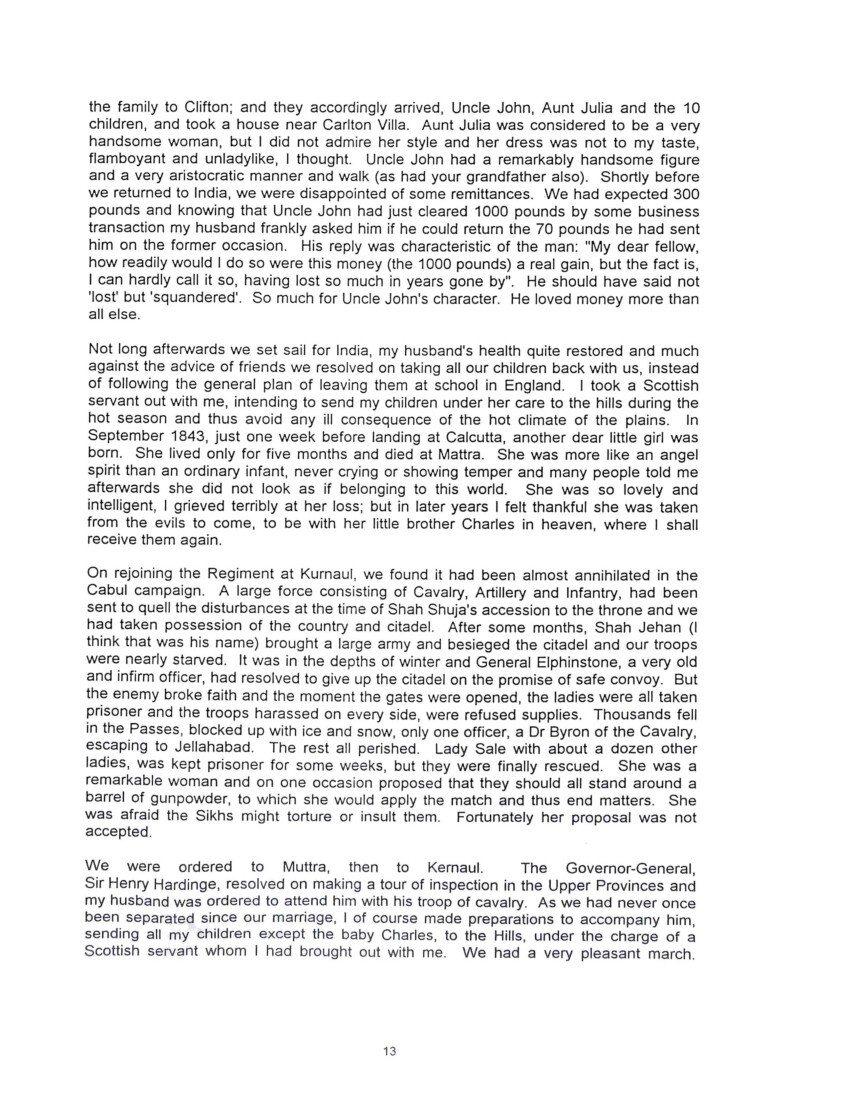
Page 14
The camp was a large one, consisting of the Governor-General, Staff, with elephants, camels and a large number of tents and camp followers. Sometimes I travelled in my Palanquin, but more often I sent the baby and the ayah in that and Dr Spencer the doctor of the Regiment, who was with us, drove me in his buggy. My husband rode on his charger at the head of the troop. When we were within one march of Ferogepore and about a mile from camp, a young officer came galloping towards us shouting out, “Have you heard the news? Thirty thousand Sikhs have crossed the Sutlej; an engagement is expected and every lady is ordered out of camp today before noon”.
I felt paralysed. On reaching our tent, I saw an elephant with a howdah and trappings which my husband told me Sir Henry had sent to take me to Kurnaul. The other four ladies each had an elephant also.
It was a sad cavalcade. About half way back we met an officer on horseback with dispatches, and as he had ridden in haste to reach the camp as soon as possible, he requested us ladies to give up one of our elephants to him, his horse being spent, and two of us to ride together. I gave up mine. That night he reached camp just as the Battle of Moodkee was fought, and was killed. I had only thought to do him a favour, poor fellow.
Three of the ladies who accompanied me on that march back to Kurnaul were made widows, their husbands dying on the field of Moodkee One was the Honourable Mrs Somerset; whose husband was aide-de-camp to the Governor-General. Very many brave soldiers, my husband told me later, mounted their charges joking and saying what capital fun to have a brush with the Sikhs, little realizing the strength and trained skill of the enemy, who had French officers among their leaders, and who fought with determination. Many of these brave fellows were left dead or wounded on the field all night. The attack was so unexpected and no necessary precautions had been taken or defences made.
My husband had been ordered on escort only, and was stationed about three miles from camp, with orders to keep a good look out for the enemy; and just as he had taken off his sword and was preparing to make himself comfortable for a hours rest, his subahdar had galloped up, saying that there was a cloud of dust at some distance, which could indicate a body of cavalry. My husband immediately saw through his telescope, which he carried always slung over his shoulder, what it was and giving orders to his men, galloped back to camp and gave the alarm. In a short time, almost before they had time to form the Regiment into line of battle, the Sikhs had opened fire and the Battle of Moodkee was fought and won by the British, but with terrible losses on our side. That same night, my husband and several other officers found themselves at about 10 or 11 o’clock, at the edge of a clump of trees. They had got separated from their Regiments, having only a few of their men with them after following the retreating enemy. It was bitterly cold – the 19th December, if I remember rightly and Major Gough, a nephew of the Commander-in-Chief, proposed that they should try and find their way back to camp; but all professed utter ignorance as to where they were and in what direction the camp lay. When my husband offered to lead them, feeling sure he could do so, they hesitated, but at last made up their minds to follow him. And he piloted them safely to the mess tents of the Cavalry, where they were welcomed as from the dead, having been reckoned among the missing ones. All hope had been given up of their being alive.
My husband used to say he had a sort of sixth sense of locality, always being able to retrace his steps and find his way where others were at a loss. I received letters daily from my husband until the Sikhs cut off communication by Dacok, but he kept a daily journal and forwarded it to me from time to time. It was a dreadful time of anxiety for the

Page 15
wives and families left behind at Kurnaul, and many an affecting incident occurred. Some rumour would reach us that such and such an officer was wounded or killed and I remember sitting up with one poor lady whose husband, Colonel Mair, was among the list of those killed, but who afterwards recovered from his wounds.
She, poor thing, was in violent hysterics all night and quite delirious. We could by putting our heads close to the ground, hear the thud, thud, of the artillery guns and the reverberation along the foot of the hills, although we were 60 miles away.
One night we had a terrible fright. A native rode into the station saying he had passed 400 Sikhs on their way to burn and destroy the cantonment of Kurnaul. What could we do? The soldiers’ wives and others in the area were all ordered into a sort of barricaded place. Most of the ladies who had carriages got them in readiness to start in the dark for Saharanpore, a small station near the Hills. I got the children out of bed, dressed them in warm labodes, tied a bag of rupees and other valuable round my waist, put the children into the palque gharri, a small kind of omnibus, and extinguished all lights while waiting for further tidings. However it proved a false alarm. The 400 Sikhs, more or less, turned out to be some religious devotees about to bury a great chief at some holy spot beyond Kurnaul The next day however, several ladies resolved to move to Saharanpore, as a safer place and Lady Gilbert, whose husband, General Sir Walter Raleigh Gilbert was in command with the army, kindly offered to take my two elder children in her carriage. The rest went in palanquin. We reached Saharanpore in safety and were lent government tents while we remained.
In the meantime two more severe battles were fought. That of Ferozeshah was very nearly a defeat, but owing to the ‘merciful’ deliverance by ‘Almighty god’ to use the words of the Governor-General, we gained the day. For twenty-four hours the Sikhs artillery guns had played upon our troops and at last our guns were silenced. Our ammunition had come to an end. Sir Henry called a council of war and said, “Gentlemen the day is lost, I die here. Order the Cavalry and the infantry to defile into the fort, protected by the Artillery as long as possible”. He then turned to some German prince who had been in camp and requested him to take charge of his dispatches etc…and leave at once for Calcutta, ordering him a strong guard. At this juncture, the Sikhs guns having ceased the fire suddenly, they were seen to be abandoned and the men rushing pell-mell towards the bridge of boats by which they had crossed the Sutlej. They were panic stricken, imagining when they saw the Cavalry and Infantry leaving their positions, that they were going to cut off their retreat to the river and get in the rear. On seeing this, Lord Gough, the Commander-in- Chief, called out in his strong Irish accent, “Try them with the cold stale, my boys!’ and the Infantry pursuing them with their bayonets, drove thousands of them into the river. My husband said it reminded him of the defeat of the Assyrians in the Scripture. Before leaving the field, Sir Henry called his generals together once more to return thanks to God for their signal deliverance and victory.
The Battles of Aliwai and Sobraon, in both of which your grandfather was also engaged, took place shortly after, Ferozeshah, and ended the Sikh campaign. Owing to Colonel Alexanders being wounded, your Grandfather commanded the 5th Cavalry at Sobraon. He wrote to me, “I have seen war and am horrified, and hope that no son of mine may follow his father’s profession”. He was, I was told, the coolest and bravest officer in the Regiment. He said he did not know what fear meant; and a brother officer told me that when the bullets were falling like a shower around them, at night where they stood unmounted beside their horses waiting for the order to charge, my husband was as calm and spoke as quietly, as if he had been in his tent. The officer had remarked in this to my husband, who replied that he felt perfectly calm and added jokingly, “But there,
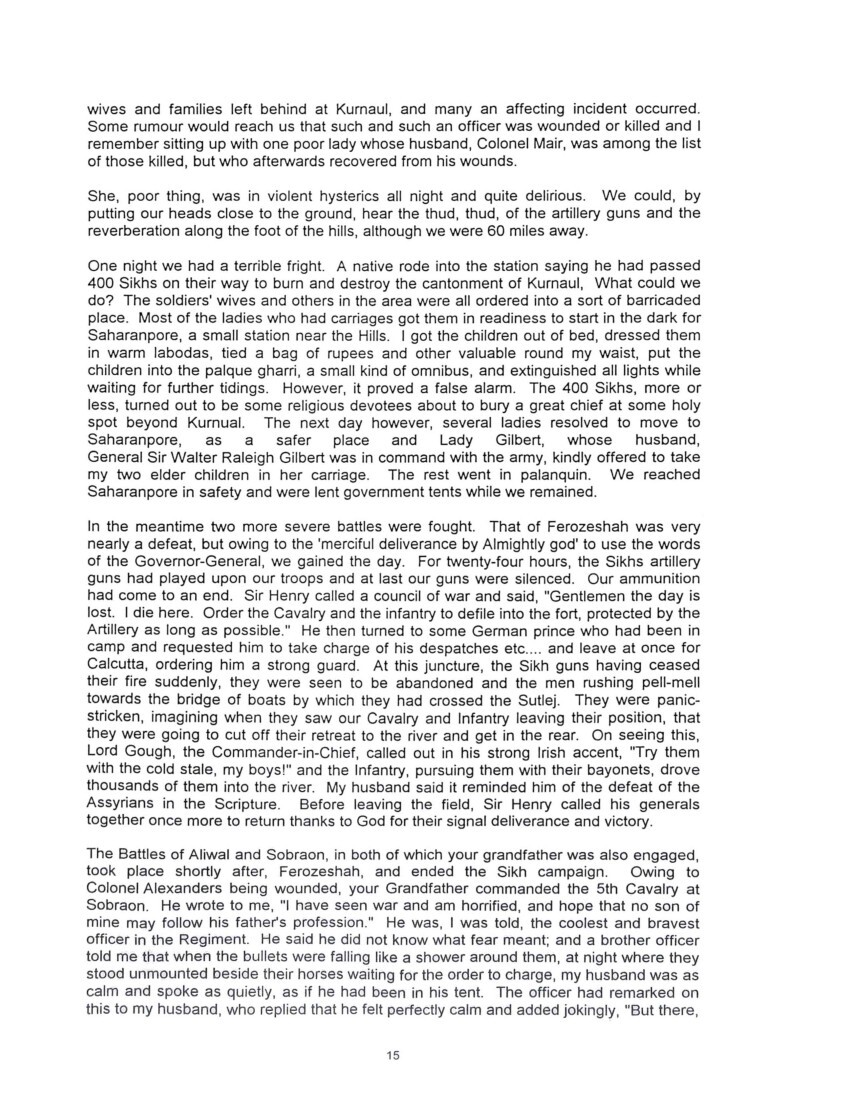
Page 16
I do not present such a target for the bullets as you do”, he being tall and thin, Captain Wrench a very stout man.
Now I must tell you that your grandfather was no ordinary character. He was the most perfect gentleman in manner and appearance generally that I ever knew. As a boy he was his mother’s favourite, and it was a great grief to her that he chose the military profession. He was a scholarly linguist speaking French fluently, Hindu, Ordu, Arabic and Hindustani. He was appointed interpreter to the Regiment. He wrote many pretty pieces of poetry, and from his boyhood had a strongly poetic, chivalrous, imaginative, but unpractical turn of mind. He had peculiar views on most subjects and was inclined to melancholy and withdrawal from general society. The few friendships he formed were deep and lasting, and he was a sincere Christian. His voice, accent and manner had a strange, rather peculiar charm and his reading aloud of Shakespeare and indeed of all poetry, was greatly enjoyed by all who heard him. He was naturally graceful in every action, and courtesy itself to womanhood, whether young or old, rich or poor. It was almost impossible for his wife or his mother to help worshipping him.
But to my resumé my narrative. After the campaign was over, we went again to the hills and my husband, wishing for quiet and rest, chose Lugooghaut, a small military station in the confines of Nepal. But I forgot to mention in the proper place, our visit to Kussowlie, Subathoo, and Simiah, the last and most delightful place in India, The climate resembles that of Nelson in summer and of Dunedin in winter, the scenery lovely beyond all description, the hill are covered with the most luxuriant vegetation – rhododendrons, cherry, walnut, horse chestnut, deodar and other pines and flowering shrubs. The cuds and valleys are covered with wild hyacinths, and most of our English wild flowers, wild strawberries and raspberries and the cape gooseberry in profusion, and beyond all, the Snowy Range, which as I said before, is the highest mountain range in all the world and the same white cold clear horizon all the year round. At Simlah, however, the clouds are often seen below and all around you and the thunder storms are terrifically grand and full of menace. Two bungalows were struck by lightening while I was at the Hills and one lady and her Ayah killed on returning from Kussowlie.
We were ordered to Meerut, another delightful station, where we had a large and commodious bungalow and my husband made me a present of a charming landau and pair. We had many friends there, besides the ladies of the Regiment, to whom I was very attached. The native servants of India were generally most faithful, but the following incident, which occurred when we were in the tents at Saharanpore will show that our prestige had suffered even at this time and that the feeling which ended in the mutiny of ’57, had already begun to manifest itself.
When we wished to return to Kurnaul, I applied to Captain Simpson, the officer commanding the station, for a supply of native carts to transport my servants and baggage. He replied that he would do his best, but that the natives were in such a state of insubordination that he had little authority over them. He contrived to get one cart and my servants quickly began loading it with their goods and chattels. Suddenly an armed man rode up and drawing his sword, commanded them to unload instantly. I was standing at the tent door behind a screen or ‘chick’ of bamboo. I readily understood the native language and coming forward, said “Who are you who dare to order my servants? The cart was sent by the Sahib in command.” He made his sword fly round my head unpleasantly near and abused me in Hindustani. I very quickly stepped inside the tent, but my boy Fred, who was about seven years old, seized his Uncle Archy’s sword, which I always carried in my palanquin, and rushed at the man, until I pulled him inside. The man finally drove off in the cart in triumph.
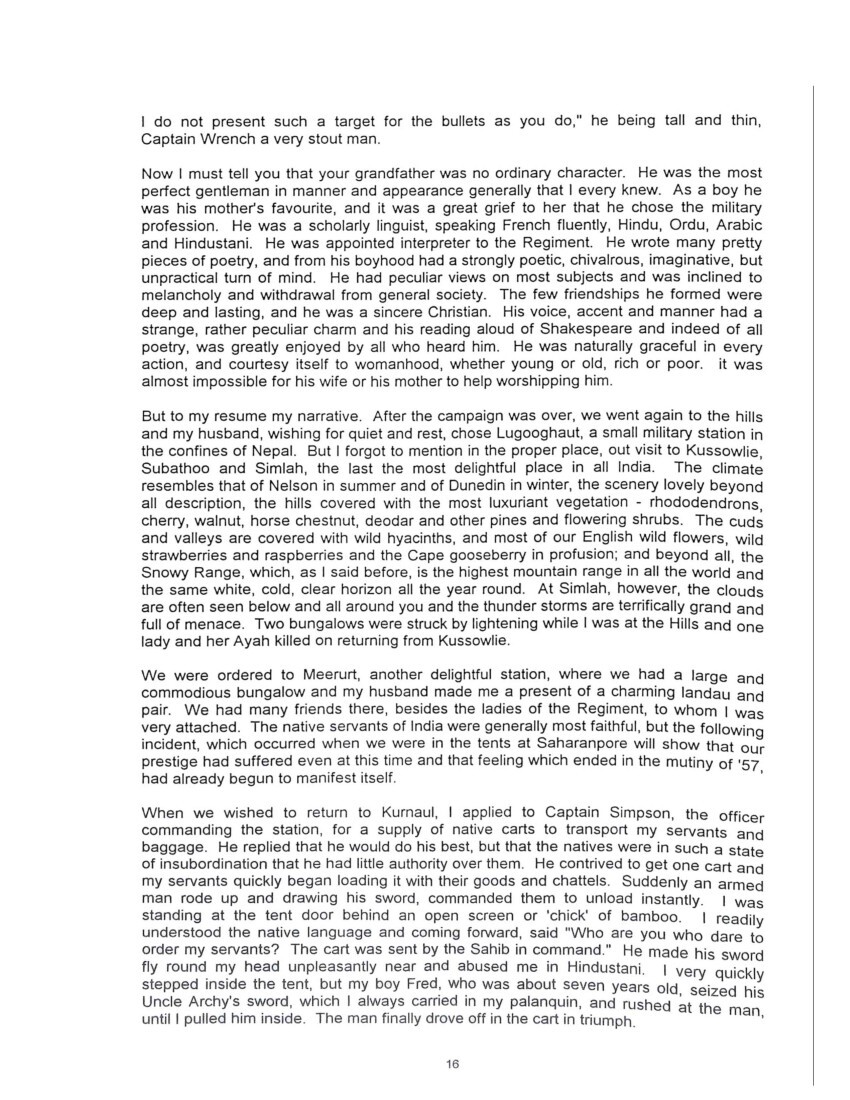
Page 17
Your Aunt Charlotte was born at Meerut, in 1846, but my memory is faulty as to dates. My husband’s health had suffered severely from the Campaign and he resolved to retire from active service and sell his commission; for which he received 30,000 rupees. All my pretty furniture, carriage, horses etc.., were sold for less than a quarter of their value and we migrated to Luhooghaut, where your grandfather purchased a small estate with three bungalows on it. We occupied the best, and lent the other two to young officers who came up for the shooting season, there being an abundance of tigers, bears and other game in the hills round us, also numerous birds, which when stuffed, fetched a high price. Captain Lockett, who was our neighbour was a great sportsman. He and Dr Pierson, who was in medical charge of the district, were our only visitors.
In about 1850, during our stay at Luhooghaut, a very severe earthquake occurred, more severe than any that could be remembered since the English had possessed India. Your grandfather was reading one of Sir Walter Scott’s novels aloud to us in the evening, as was his custom, when about 7 o’clock, the slates on the roof began to rattle. They were large blocks about a yard square and heavy beams of cedar which supported them creaked and groaned most ominously. We all ran outside. The shaking lasted for 60 seconds or so, as far as I can remember. When the panic was over, the servants came rushing in, stating what various damages had been done. One was that the officers’ Mess House had been shaken down, which proved to be true and one unfortunate officer nearly lost his life. It happened thus. He had his right leg amputated some months previously, after it had been shattered by a blow from a tigers’ paw. Captain Auberb had wounded the tiger which, however, had pursued him, and there being no other means of escape, he had climbed a tree and clung to the branches. The tiger lay just below, tired at last. Exhausted, the officer tried to jump clear of the animal, but unfortunately did not succeed, falling just within reach of its front paw, which broke his leg. His attendant had come up, shot the tiger dead and conveyed his master home.
At the time of the earthquake, Captain Auberb was reclining on his charpoy, his wooden leg having been placed in a far corner of the room and his bearer gone on a message. When the officers all ran outside, he, unable to move without his leg, shouted to them, “Here! Someone give me my leg for mercy’s sake!” And he only escaped just in time before the wall of the bungalow fell.
On another occasion we had a snow storm all night and in the morning the ground all round us as far as we could see, was white, a very unaccustomed sight for my children. My husband and I were admiring the scene, when a native servant coming up, my husband said, “What is that huge log of wood doing on the pathway? Move it off”. When the man approached it, what a surprise to see it move with an undulating motion across a little gully and disappear, the native shouting “Samp! Sahab, Sampe hi!” It was a boa constrictor that had been partly paralysed by the cold, we saw small snakes, but not another boa constrictor.
While we were at Luhooghaut, my health, hitherto wonderfully good throughout my residence of twenty years in India, gave way completely, and after my daughter Caroline’s birth I was a helpless invalid for many months. We remained at Luhooghaut for about three and a half years. I was sent latterly to Almorah for a change and to be under the doctor’s care. During my absence, my husband received a copy of Hursthouse’s book, ‘New Zealand’, with which he was greatly impressed, but which I consider one of the most deceiving and mischievous books ever published on this colony. He resolved to take his family and settle in Nelson, where the Blundell family had gone. I was too ill to go with them and it was decided that I should proceed to England with one child, Charlie, and remain there with my mother-in-law, Mrs Gascoyne,
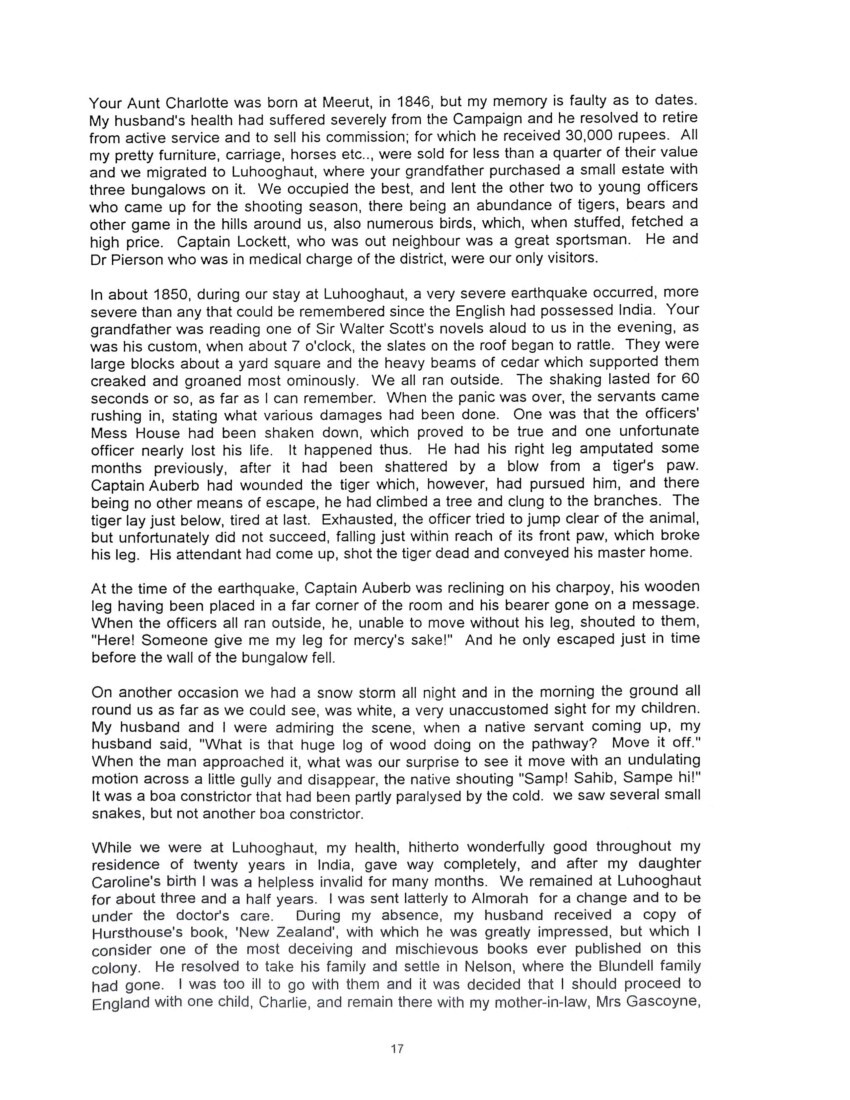
Page 18
until my health improved. Miss Sutherland would accompany the family and take charge of the children.
On our all leaving Luhooghaut and going down the Ganges, we were obliged to leave the Hoogley and go through the Sundarbans, by which the many branches of the River Ganges reach the sea and which wind like so many canals for miles and miles through the jungles around Calcutta. Arrangements were soon made for my journey to England via the Red Sea and Egypt and I went on board the “Hinrooctan”, one of the largest East Indiamen then built. There I said good-bye to my husband who returned on shore about 10 o’clock. It was a lovely moonlight night, everything being still and silent after all the previous bustle, except for the regular tread of the officer on watch on the deck overhead. Mine was the stern cabin and feeling very disconsolate and lonely, and not at all inclined to sleep, I climbed up on the bulkhead before the windows and looked about me. Just below, attached to the rudder chains, was a small boat or dinghy, containing two natives fast asleep. Suddenly the tramp overhead ceased and I heard a plunge, as of someone or something overboard about the middle of the vessel and presently a most extraordinary sound of gurgling or choking and splashing.
Straining my body forward, I caught sight of a white thing floating alongside and the same horrible noise was repeated. I then saw that it was a man wearing a heavy cloak and a white solar toupee I threw over some rope that was beside me and shouted with all my might to awake the men in the small boat. Happily I succeeded and one was overboard in an instant laying hold of and dragging the drowning European into the dingy, the natives paddled round to the side of the vessel and at once all the cabin door burst open. Every lady passenger, in a state of great alarm, appeared, believing it was her husband who, after having wished her good night and gone to enjoy a little extra conviviality with the officers, had stumbled overboard at last. “Oh dear! I’m sure it is my husband”, came from twenty cabin doors; and only upon learning that the individual was a bachelor, was peace restored. I may add that the gentleman was an officer in the Bengal Service, A Captain Bemply Baugh, who for the remainder of the voyage was like a son to me and saw me safe to Clifton, where I remained for sixteen months with Mrs Gascoyne, my mother-in-law. From there after visiting all my Scottish relatives, I too sailed for New Zealand in December 1853.
My husband had purchased eight hundred acres of land on the outskirts of the ‘bush’ at Motueka, on the other side of the Bay of Nelson. There I found a new world, in a very painful sense; and there we were buried alive for twenty years. Our capital was partly invested in sheep, the rest in land. We finally lost both, and all our savings in India vanished. I must add, however, that I can certainly say, “Goodness and mercy have followed me all my days from childhood to old age”, and now I’m ready to depart and join those loved ones gone before. God’s promises are sure even to the end. I have written this narrative straight off without a copy, and if there are errors please excuse them, as I’m now 78 years”.
Before I go on to relate what befell this family, here in New Zealand, I shall include an extract from the memoirs of little Isabelle, or Isa, as she was called, eldest daughter of Charles and Isabelle.
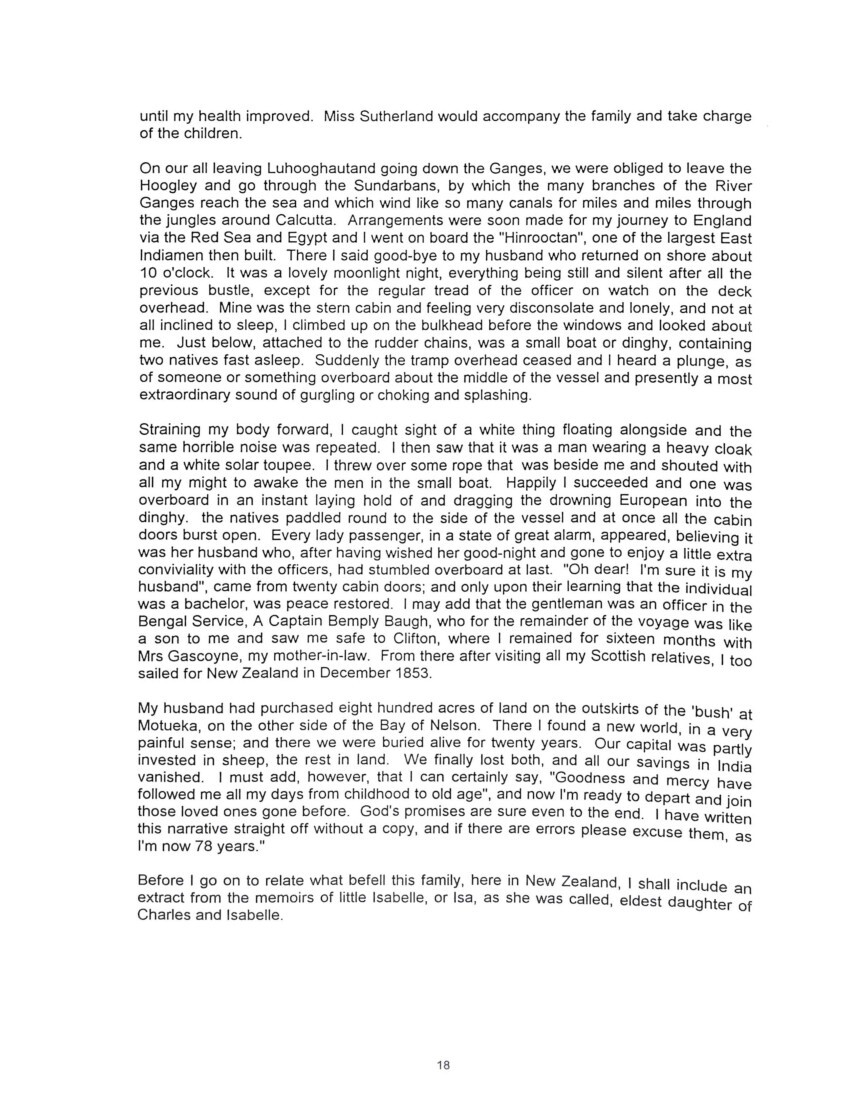
Page 19
CHAPTER II
CHILDHOOD MEMORIES
From the childhood memories of Isabelle Greenwood, eldest daughter of Charles and Isabelle Gascoyne.
The earliest thing I can clearly recollect is standing on the banks of the Hooghly River in India, holding my father’s hand and watching an English coming in. I had been born in Cawnpore, East India and was at this time four years old. The only white people I had seen besides my parents, were officers and their wives and children, so these strong ‘sailor men’ looked very interesting to me. I was a very timid child and would have been alarmed if I had not had hold of Papa’s hand. Very soon I was lifted into the boat and all our native servants were left behind. It was a great grief to me to part with Sudda, who had looked after me and used to carry me about and take me for walks; but everything was so new and strange that I soon forgot my sorrow in the excitement at what was taking place at the moment, and only knew that I must keep near my father. We boarded the great ship, an East Indiaman, amid what seemed to me much confusion. The loud shouts and orders to the men, the bustle and excitement, all combined to overwhelm and frighten me. The doctor had ordered that I should have a glass of Port wine every forenoon and when we had been some days at sea, my dear father gave it to me, thinking that I needed it; but my mother said that he was just spoiling me.
Next came the life in England at my grandmother’s home in Clifton. Grandfather, Captain Gascoyne, had been in the Royal Navy. Fred, Mary and I were put in charge of upper and under nurses, in two nurseries, a day and a night one, and confined there whenever we were indoors. It was so different from the freedom of our life in India and the large bungalow we were used to, with its deep verandah all round and the many servants all so willing to help and anxious to please. We were taken out for drives every day in England. I remember we all disliked the upper nurse who was sour and disagreeable and ugly, but Marianne, the younger one, was bright and pleasant and used to take us on the ‘downs’ and let us have donkey rides. When we returned to the house, we had to toil up the many steep stairs from the ‘hall’ to the nursery and I wondered why the English people had stairs. We had none in India. One day, just as we were brought in from a walk, I saw my father and his mother coming down arm in arm from the dining-room. I have a very vivid recollection of this, for I thought they looked most loving and beautiful, almost like angels. I cannot remember any time when I was not passionately fond of my father and did not admire him immensely. He was the handsomest of men. Grandmamma was beautiful too, her expression making her most lovable and father was like her. Mother and son were always devoted to each other. Grandmamma was French, her maiden name being De Coetlogan and she was very charming in her manner both in her own house and in society; and her goodness and kindness to those less fortunate than herself made her beloved by everyone. My childish ambition was to be like her.
We children did not care much for grandfather though he was never in the least unkind, but he struck us as tiresome as he complained of the noise our feet made running about overhead; for the nursery was over the drawing-room. He used to go out walking every day. One day I tried to help him on with his overcoat. I was only five years old and failed utterly, to my great mortification. It was also whispered among the servants- and we heard it from our nurse – that he was very fond of nice things to eat. We thought that it was greediness and were told by the nurse that it was downright wicked. So Fred and I felt doubtful as to his being a fine character. Grown-up people, we were
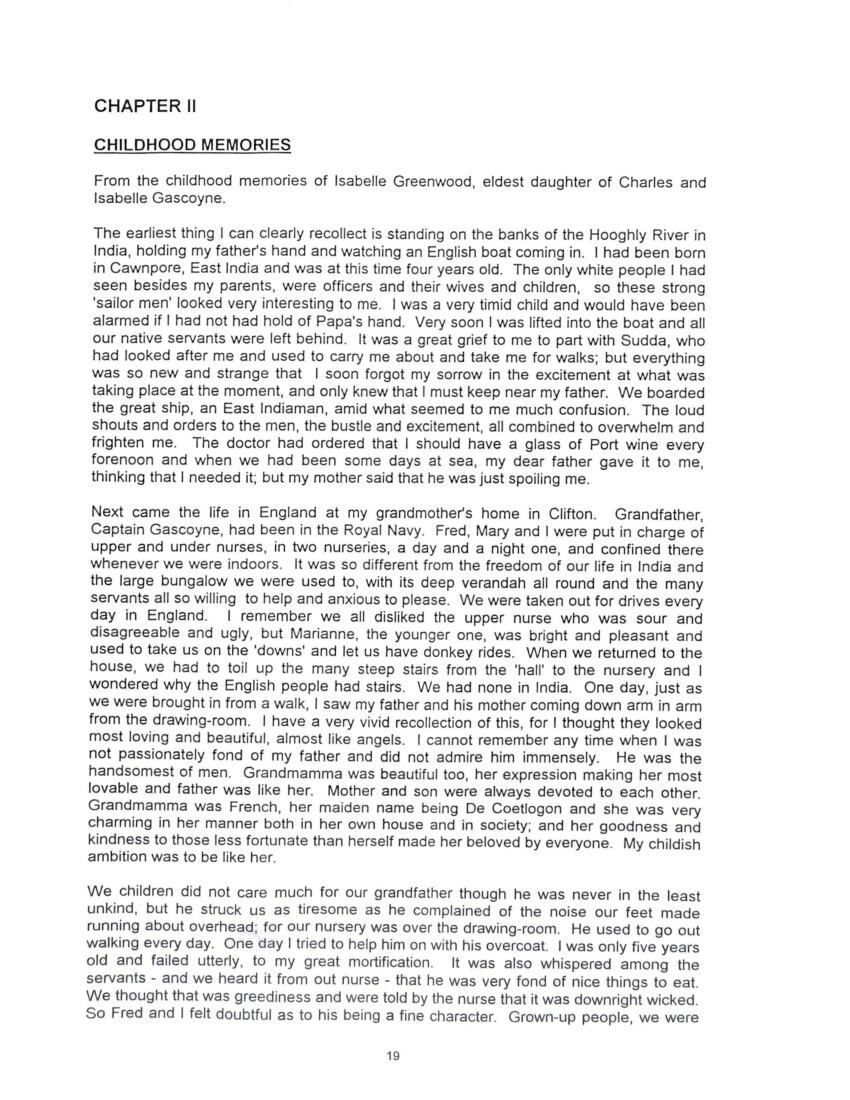
Page 20
told, always did what was right and proper. And it was the height of impertinence for children to do other than admire their elders. Aunt Mary Gascoyne, my father’s sister, was a foreign looking lady, who wore caps trimmed with pink ribbons. She was much older than my father. Another sister, Sophie Williams, lived somewhere near us and had several children, but we did not take to them as much as to our other cousins, the children of Uncle John Gascoyne, who had married a daughter of Admiral Cumberland, Julia Cumberland, and who also lived at Clifton. The eldest girl and I were sent to the same dancing school and were rivals in that art. We played together and were good friends.
During 1841 we all went up to live in Elgin, Scotland for a time, and there my sister Emily was born in the house of the Forsyths; my mother’s friends were almost all in Scotland. The Forsyth family consisted of father and two daughters who at that time must have been in their thirties. They had travelled on the Continent and were good, clever and well bred. The elder, Kate, was my godmother, the younger Isabella, was quite blind – the result of an accident in a carriage, when a parasol was opened for her by her fiancé who was sitting opposite her. There was a sudden jolt and the end of the parasol was driven into her eye. Complete blindness followed, the engagement was broken off and dear Aunt Isabella, as we called her, remained single until her death. She used to amuse herself by knitting in coloured wools and it was a mystery to me how she distinguished between the colours. When I asked her about it, she said each colour felt different to touch.
Just before we left Elgin to return to England, Amelia Sutherland came to us. She was tall, slender and good looking, with lovely auburn hair. A quiet, unselfish, tactful woman with plenty of good sense, she very soon had unbounded influence over all of us and was our friend, helper and teacher. She came to India with us and later to New Zealand and remained with us until her death in 1868. All the book- learning she had was gained at one of those good old Scottish schools where boys and girls were taught together. The boys frequently went to Edinburgh, passed stiff examinations, and became Ministers. Amelia’s taste in books was excellent and she and our father taught us all we ever learned.
I remember hardly anything of our return to Clifton except that Fred and Mary and I had our portraits painted by an artist named Fisher. They were beautifully done, as Fisher was a well-known artist and painted for the Royal family. Then came the news of a dreadful massacre at Kabul in India, which nearly broke my father’s heart. All the officers in his regiment except two were killed. It was the first great sorrow I remember. We all went then to London to prepare for our return to India. A great deal of shopping was done. We brought many books, both for grown-ups and for us children. We were taken to the zoo and various places of entertainment for children and also to pay visits to say goodbye to relatives and friends. One of these was to Misses Gascoyne, cousins of my father and I was impressed with the grandeur of the house with its purple velvet curtains lined with white satin, the powered [powdered?] footman and the Butler waiting upon us at the table. These cousins were the daughters of Colonel Isaac Gascoyne, my father’s uncle.
The voyage out to India was pleasant and very interesting to us all. We arrived at Calcutta and as my father was anxious to rejoin his regiment, which was then at Muttra, a boat was hired and up the Ganges we went partly by towing, sometimes even being rowed. It was a delightful way of travelling; every evening the boat was moored to the shore and we were allowed to go for walks – such walks; so full of interest and pleasure, with our father to point out and explain everything. He was an excellent linguist and could speak really easily to the natives, who always responded readily to his courteous remarks and inquiries and with a politeness equal to his own. Sometimes we would go to
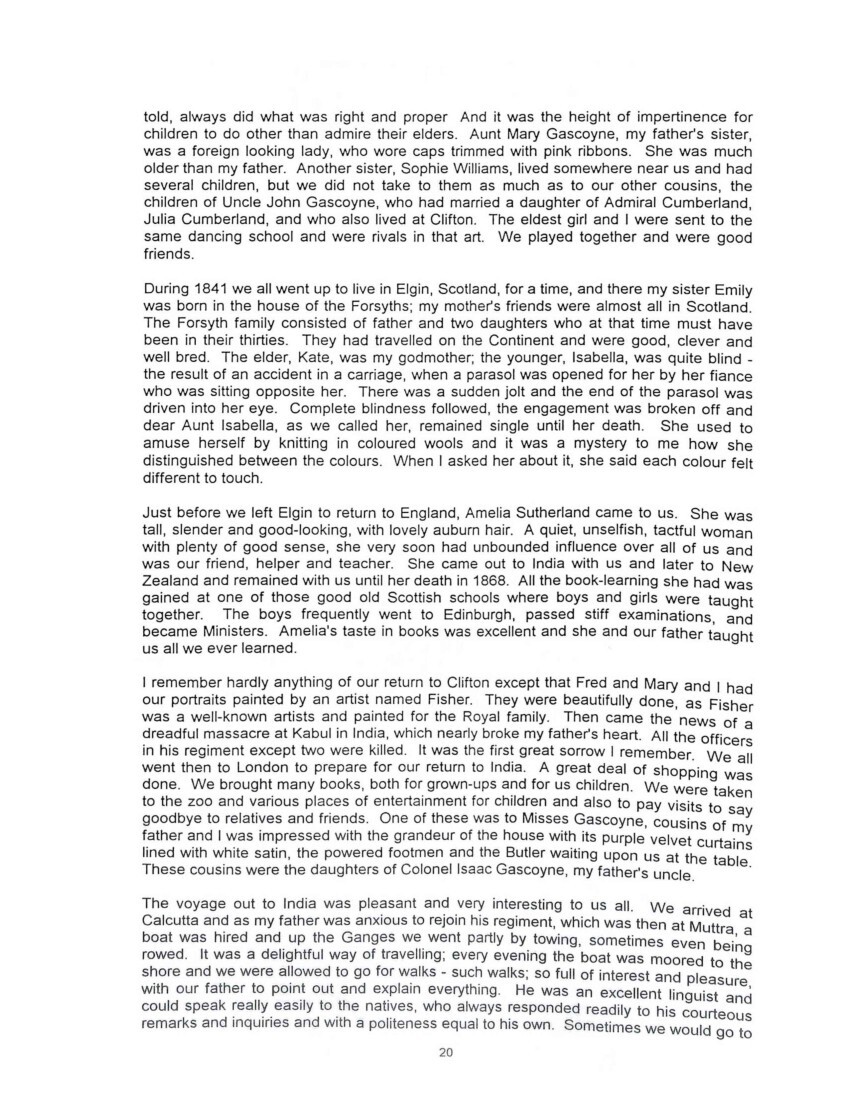
Page 21
the sugar-cane fields where the first process of making sugar is carried out. First the cane is put into a rough kind of mill and ground until all the juice is extracted and then it goes into great boilers and is boiled until it is a brown sticky mess. The Indian children enjoy it greatly. On other occasions we were taken to a celebrated temple or mosque, or to some deserted old palace that belonged to bygone days, but which we could easily see must have been a magnificent building, its great rooms all of pure marble. Once I wondered off alone through one of these palaces and on a window seat found an old book. It had lain there so long that the damp of heavy dews at night had destroyed most of the pages inside. It was a story of a nunnery, and I felt it was a treasure. A rare treat for us in those days was to be taken to a bazaar and to go through it to see all the shops. Always before we entered, the head man of the bazaar was ordered to see that all the objectionable sights were removed while we passed through. This really was a fact and the order was strictly obeyed. Such was the esteem in which the East India Company Raj was held and all his officers too. As we returned we would see the servants and boatmen scattered in groups on the bank of the river, all busy over their little fires, preparing their evening meals- a pretty sight.
We had 2 years at Muttra. Our brother Charles was born there and then we all went to Manooli, a military station in the Himalayas. There we had a fine stone house, good servants, and perfect liberty to play out of doors within certain boundaries. The scenery was magnificent, the varying beauty of the mountains always a fascination and we spent many happy days with our governess Miss Sutherland. Then we were told we were all to go to Mamall Ambala where our father was stationed with his regiment. It was a few weeks before the Sikh war, when there was no anticipation of such an event and in complete ignorance of what was going on on the Plains a few hundred miles away, we packed up, dismissed most of the servants and set off, pleased to be on our travels again. By the time the news of the State of Affairs could have reached us, with a warning not to start out but to stay where we were, we were already on our way. When we arrived at Ambala, we found our father was away in Camp and that an action was likely to take place any day. My mother took refuge with a friend, who accepted us all with the utmost hospitality, my parents of course insisting on sharing equally with the household expenses. Captain Benson whose house it was, was away with his regiment, the 4th Cavalry, in the same camp as my father.
There came days of fearful anxiety and waiting and constant rumours of danger. The natives were in a state of great excitement and unrest and hoped the English would be beaten. Now and then, a mounted messenger would bring letters from officers to their wives, and oh how eagerly they were read and treasured! One day I was standing on the verandah, listening to the big guns and knowing that a great battle was being fought- the battle of Moodkee. Then came tidings that the English had lost the day and that a detachment of Sikhs would be on us in a few hours, to loot, murder, pillage and burn. There would be only just time to escape to Sahranpore if we got a carriage and good horses at once. You can imagine the fright, hurry and bustle. We children were hastily dressed with blue quilted dressing-gowns over our clothes to keep us warm and then there was the question of how to carry our money, jewels and other valuables. Mother decided that she and Miss Sutherland should be laden with a bag of rupees, while Fred, Mary and I were entrusted with packets of jewels and family miniatures, which were carefully tied to our backs. The three carriages or landaus, containing both families, started out. We left the bungalow with all its furniture and its contents to the care of the servants, thinking we would never see it again. However, after two months, we returned to find everything was the same and intact. The detachment of Sikhs had gone somewhere else that night. Our journey had begun by our trying to cross a bridge a few miles from Ambala, but the enemy, having taken possession of it, refused to let us pass, in spite of our pleading that we were in a hurry and must cross. One of the men on
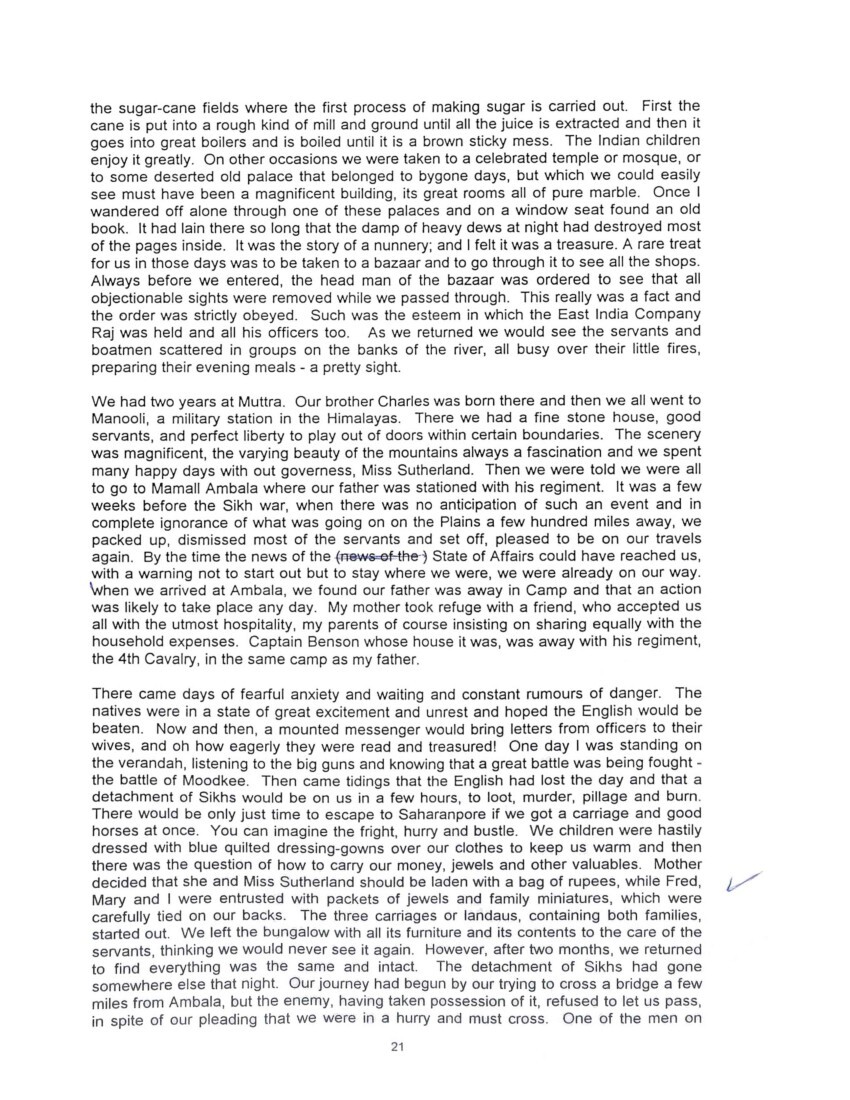
Page 22
guard, actually drew his sword and threatened to cut us to bits, so we drove further down the river to the next bridge and got over. It was a weary time but when we arrived at our destination we were none the worse for our adventure; however, unavoidable hindrances in getting fresh horses and food had caused much frustration.
We found Saharanpore a pleasant place, the bungalow being close to very beautiful gardens. At the end of two months our father came home on furlough and took us to a pretty Hill Station on the road to Simla. We all enjoyed our stay there and then went on to join the Regiment at Meerut. We stayed there for three years, spending six months of the cooler weather on the plains and the hot weather on the hills; but my father remained at his duties all the year round, till he became dangerously ill from being too much in the sun and was given sick leave. We all went up to Luhooghaut, one of the loveliest of all hill stations. There Caroline was born. I always look back to our time there with pleasure; for our compound – the enclosures of the house and garden, the servants’ quarters and the stables – was unusually large and there was a most beautiful avenue of huge apricot trees from the entrance gate to the house, which was a large bungalow with deep verandahs all round it. The garden was a delight, with many plantains, bananas, pomegranates, dates and coconut palms and quite a forest of mango trees.
Three of these grew beside the road and all who chose were free to pick the fruit. At no other hill station in India is the scenery as grand and soul-inspiring, or the climate as good as Luhooghaut. Here we spent three happy years and learnt a great deal.
At the end of that time, my father had an extension of leave and decided to go to New Zealand for a visit. He owned three houses which he sold; and we all came down to the plains, passing through the Terai, a belt of great jungle trees inhabited by tigers, leopards, cobras, hyenas and many other wild creatures. It was an exciting and unforgettable journey. Mother did not accompany us to New Zealand, as she was too ill, but left for England on her doctor’s advice, taking our little brother Charles with her. She joined us just over a year later in Nelson and there the whole family – father, mother, two sons and five daughters – settled down to make a new life on the land. Lord Salisbury had offered my father a commission for each of his sons, which he declined to accept as he did not consider that life in the Army was the kind of life he wanted for his sons. My brothers were greatly disappointed when they heard later of Father’s refusal. Fred, the eldest, some years later enlisted and fought in the Maori wars, gaining the rank of Major.
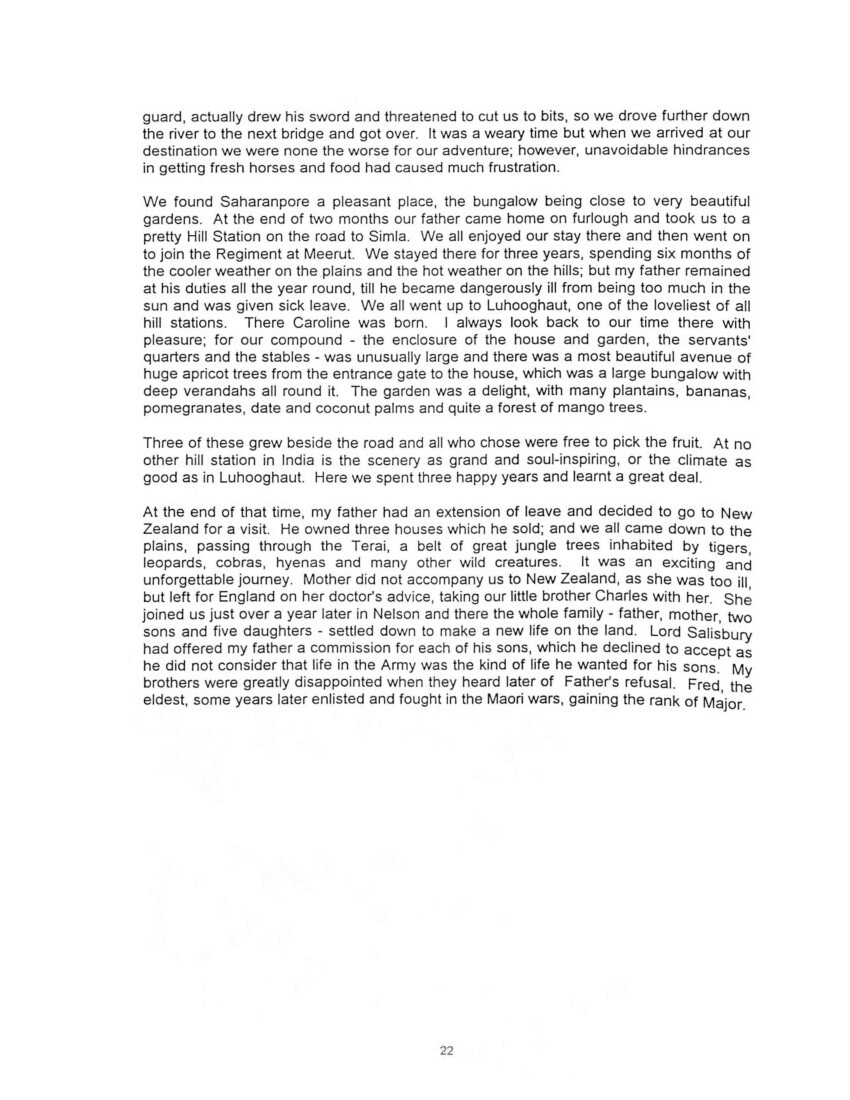
Page 23
CHAPTER III
PIONEERS
John Gascoyne, father of Charles and John, held the rank of Captain in the Royal Navy until his retirement in Swansea, when he went with his family to settle in Clifton near Bristol. During his sea voyage he had contracted yellow fever and had recurring attacks of the illness till his death in 1845. It was no doubt this illness which caused him to be regarded as an invalid by his wife and children and to be so pampered by them. There was no record of his ever having gone to Australia, but Sir George Grey records during his exploratory voyages in Western Australia, that he named the Gascoyne River after his friend Captain John Gascoyne, brother of Bamber Gascoyne. It seems rather a strange friendship to me, the one man so brave and tough and the other ailing and spoilt. But of course Grey may have known him in his sea-faring days.
It is Captain John’s two sons, John and Charles, in whom I, the writer, am chiefly interested, for they became my great-grandfathers, the son, Henry of one marrying the daughter, Emily of the other and establishing the second and third generation of pioneers in New Zealand. Charles Gascoyne lived a more active and useful life than his elder brother John. As Isabelle has told us in her memoirs, all their children were born in India, or Scotland and travelled back and forth. Life had been very colourful for them and so the complete change to so different an environment in a newly colonised country must have been a traumatic experience for them. It was probably not till the third generation that the New Zealand way of life was fully accepted as the only one known. Not that Charles and Isabelle and their children did not work hard and bravely, but there would be a constant looking back and secret yearnings. There were adventures of a new kind, some excitement and sometimes stark tragedy. But what could those early colonists have known of breaking in new land and farming it, after the life so many of the had led?
Charles Gascoyne, after farewelling his wife and their small son Charles, on their journey back to England, booked a passage for himself and the other children on the ‘Marlborough’, a sailing ship of 1,600 tons bound for Melbourne. They arrived at Williamstown the port of Melbourne, at the time of the great gold fever. Nothing else was being talked about and the town was full of eager prospectors and businessmen, all out to make a fortune. Here Charles met Mr Tinline from New Zealand, who was about to return to Nelson on the ‘Belle Creole’. Taking Mr Tinline’s advice, Charles and his family secured a passage, and in three weeks, set sail. They landed in Nelson, crossed Blind Bay to Motueka and lived there for six months in a house belonging to a Mr Dashwood. During that time, a prefabricated two-storied house was put on Charles’ own property in the Paengatotara Valley, on the right bank of the Motueka River and they moved into their new home.
Early in 1854, Isabelle, now complete recovered and her son Charlie, joined the family and all set about making a new home for themselves. There was much hard work breaking in the land, ploughing, fending and sowing crops.
Charles was no longer a young man. He was 48 years old and Isabelle was 44, Frederick was 15 and his brother Charles was only eight. Both boys however assisted their father in the unaccustomed work and by the time Charles was 12, he could do as much work as an average man and was very skillful with the axe. As more immigrants came to the country, labour was readily available and no doubt Charles employed men to help him. Isabelle of course had her five daughters and their dear
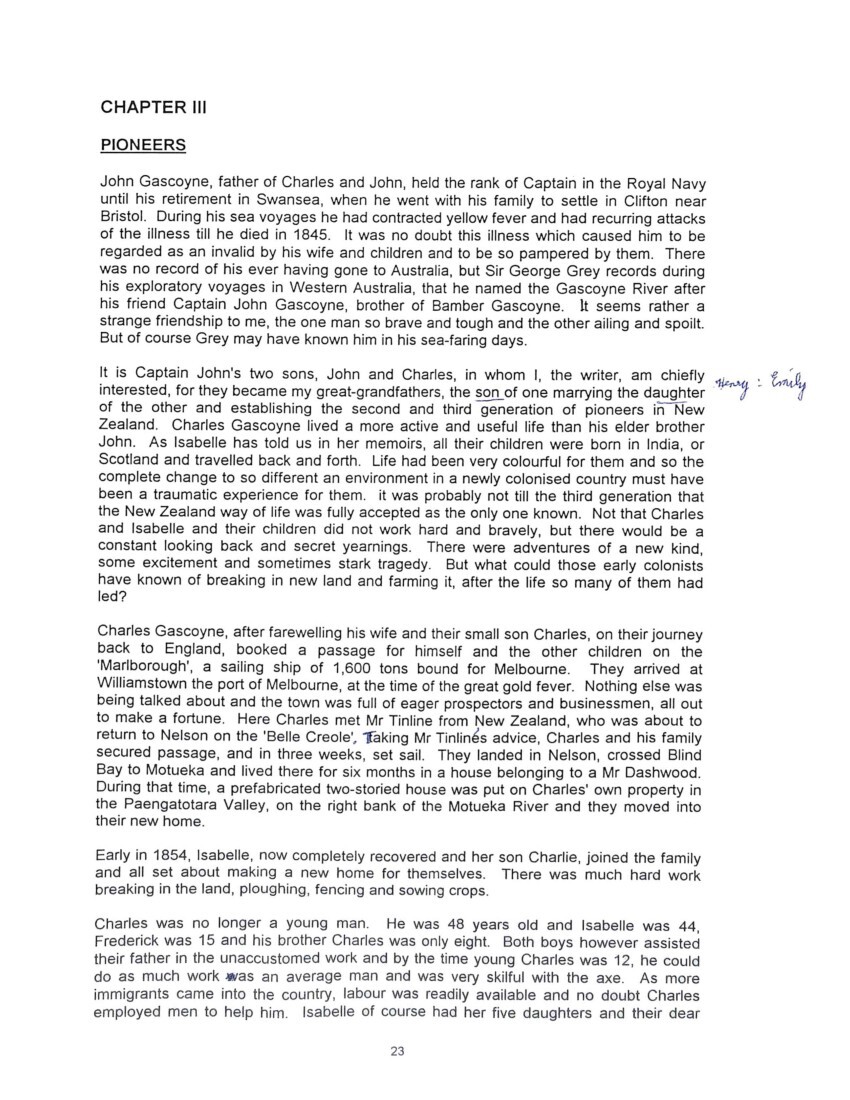
Page 24
Miss Sutherland to assist her with the household duties. In the evenings, despite the fatigue of a hard day’s work, Charles continued to read aloud to his family, and this no doubt helped to instil in them all, that love of literature, art and music, which never left them.
In 1855, Frederick left home to find his way to Hawke’s Bay, where his mother’s kinsman, Sir Donald Maclean [McLean], had a sheep run. Frederick wished to be employed on the run as a cadet, in order to learn something about sheep-farming. First he stayed with Sir Donald Maclean’s father-in-law, Mr Strang, in Wellington for a week or so and then set out to walk the 200 miles to Hawke’s Bay. The journey took him a fortnight as much of the walking was along the beaches on soft sand which blistered his feet and forced him to rest for a few days at ‘Akitio’; and then he had also to sleep out on the track on two occasions and wait for the low tide before he could cross the rivers.
Sir Donald’s brother, Alex Maclean, was managing the station at this time, and he met Fred at Clive, lent him a horse, and together they rode out to Maraekakaho. Fred remained for three years on the station, breaking in horses and draught bullocks, ploughing, shearing, fencing, carting wool and in fact trying his hand at anything he could. After three years, about 1858 he returned to Nelson. During this year, Isabelle Gascoyne, his eldest sister, married John Greenwood, who owned a saw-mill in Nelson. Frederick worked for nine months for his brother-in-law and then went to Wairau to assist Jim Hodson to drive a huge mob of cattle down to Otago. This took several months and Fred was able to gain considerable knowledge of the east side of the South Island and part of the lake district. Next he and his cousin tried their hand at gold-digging about Collingwood and the Upper Motueka River. This was hard and unprofitable work and after two years, when they were considering changing their occupation, suddenly and most unexpectedly, Fred received an official letter offering him a Lieutenant’s Commission in the newly formed Colonial Defence Force. Fred had no hesitation in accepting the commission. It was now 1863 and he set out for the squadron’s headquarters in Hawke’s Bay. His cousin at the same time had been offered an ensigncy in the 3rd Regiment of Waikato Militia. The story of Frederick Gascoyne’s military career has been told in his book ’Soldiering in New Zealand’, from which I shall quote details of his activities during those years. But first I shall relate two incidents which may serve to throw some light on his character.
In 1850, when the family left Meerut on long furlough, to settle in the hill station of Luhooghaut, in the Kumoan district, Charles decided that his 12 year old son should go to school. He knew that they could be among the foothills of the Himalayas for about 3 years.
Indeed he was thinking of starting a tea plantation, as the district was suitable for the industry. But the matter of his son’s education had begun to concern him, so one day, accompanied by young Frederick, he set out in the Landau to visit a school further South that had been recommended to him. When they arrived at the school, Charles went in to the Principal’s office to discuss the matter, while Fred remained in the hall or grounds, where he met some of the boys. When Charles joined his son and they went on their way, there was a long silence save for the clop, clop of the horses’ hooves. Then a small voice said “Father, do you know that they flog boys in that school?” – “Yes, son”. Clop, clop went the hooves on the road for some distance. Then, “Father, I think if anyone laid his hands on me I would knife him”. Clop, clop went the hooves. Then, “Yes son, I think you would. We won’t go to that school”.
But of course Frederick was no coward. It was simply that the idea of corporal punishment was repulsive to him. Eventually he was sent to the Kumoan school where he remained while they were in the district – only two years as it happened, for Charles
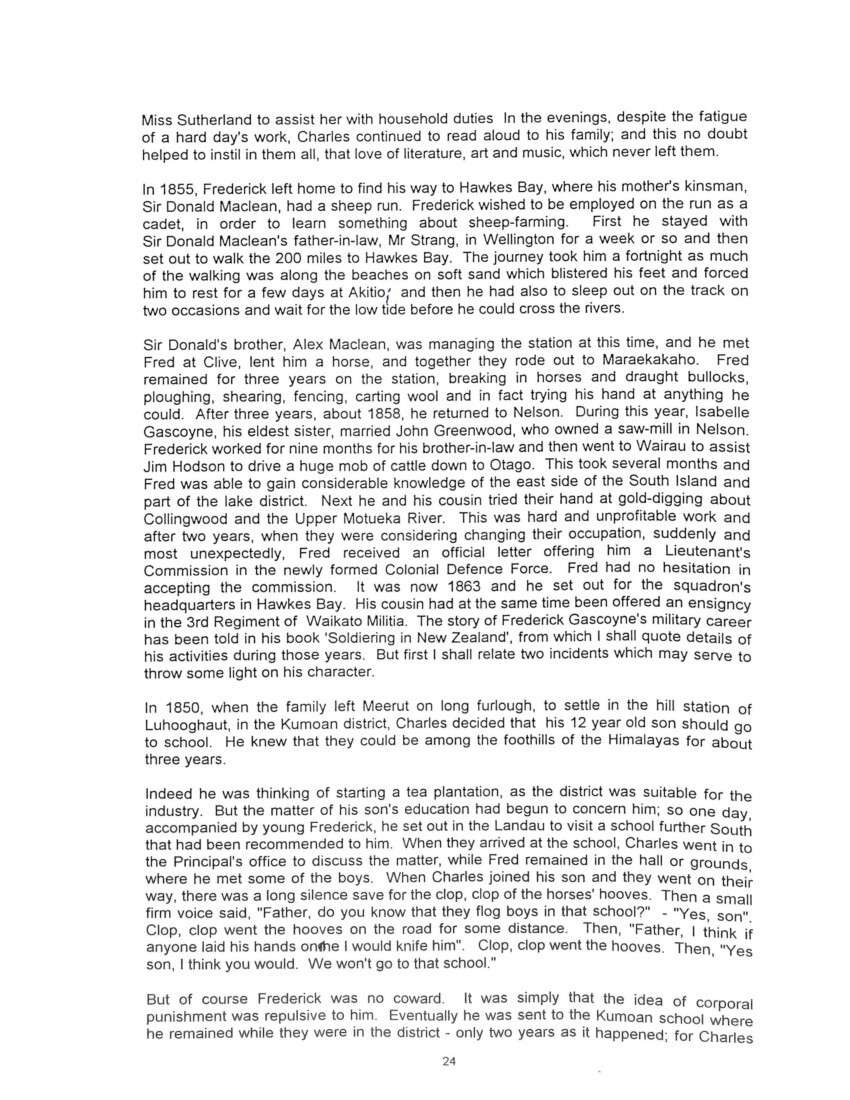
Page 25
decided in 1852 to go to New Zealand. On the voyage Frederick fought what he describes as “his first duel”. How many others he was involved in, if any, is not known; but on this occasion his antagonist was a midshipman named Quirll and their weapons two of the Captain’s swords that had been taken forward to be cleaned. The condition was that the first man wounded would be declared vanquished. Fred had received lessons in swordmanship from some of the troopers in his father’s regiment and he was easily able to lock his opponent’s blade and slightly wound his sword-hand. They managed to keep the affair secret, only the sailmakers and two of the other middies being witness to the encounter.
Frederick served in the Colonial Defense Force at first under Major Whitmore, mainly in the East Cape, along with Major Fraser, Lieutenant R Biggs and Ensign A Tuke. Later they were reinforced by a party of 45 forest rangers under the command of Captain Westrupp and Lieutenant Rose. After the East Cape Maori had been subdued, Lieutenant Gascoyne went with the rest of the Force to Gisborne for protection of the Poverty Bay Settlers, for the Hau-haus there had built a strong pa at Waerengaahika and declared war. Eventually all the Hau-hau strongholds were destroyed and the entire forces under Major Fraser went by the Government steamer “Sturt” to Wairoa. There the pa at Mangaruke near Waikaremoana was taken. But the sporadic fighting on both sides of the North Island continued until 1866. Then in October of the same year, the Hau-haus came down towards Napier taking possession of the pa at Omaranui [Omarunui], near Puketapu. Reports came that they were reinforced by rebels from Taupo and Upper Wairoa.
Duncan Maclean called out all Hawke’s Bay Militia and sent orders to Major Fraser to bring forty military settlers and thirty men from Wairoa with all speed. The Hau-hau reinforcements coming down the river now known as the Esk, were interrupted and driven back. After several more skirmishes, the company of military settlers at Wairoa was disbanded and each man who had been enrolled for three years received fifty acres of land, as had been promised.
It was now that the Government raised a force of about 600 armed constabulary, under officers who were called ‘inspectors’ with the relative rank of Major and ‘Sub-Inspectors’ ranking as Captain. Lieutenant Gascoyne’s name was omitted from the new appointments much to his surprise and disappointment. He put the omission down to the private animosity of two men of influence and position. But in 1867, when it was learned that Te Kooti had escaped with 200 of his followers from the Chatham Islands and had forced the Master of the ‘Rifleman’ to land them at Whareonaunga, [Whareongaonga] near Nick’s Head on Poverty Bay, every soldier was needed and Gascoyne reported immediately to Major Biggs, who was in command of the district. From then on he was in active service, carrying dispatches often through dangerous enemy territory, acting as a guide, reconnoitering enemy strongholds. Frederick Gascoyne had inherited from his father that feeling of locality and a prescience that governed many of his actions. Colonel Whitmore frequently insisted on his service as a guide, even on one occasion when he was unable to walk having severely injured his knee in dropping into a deep gully to escape from the Hau-haus. However he was still able to ride his little horse; but his injury was to prevent him for the rest of his life from such activities as fast running, jumping, dancing or playing cricket.
Shortly after the escape of Te Kooti, it became known that he was threatening to exact revenge from the Poverty Bay settlers who had fought against him. Gascoyne was placed, under the authority of Major Biggs, in charge of nine scouts who were in watch for the approach or armed natives along the tracks from the Urewera country. He fixed his chief camp, with the concurrence of Major Biggs, about 20 miles from Gisborne
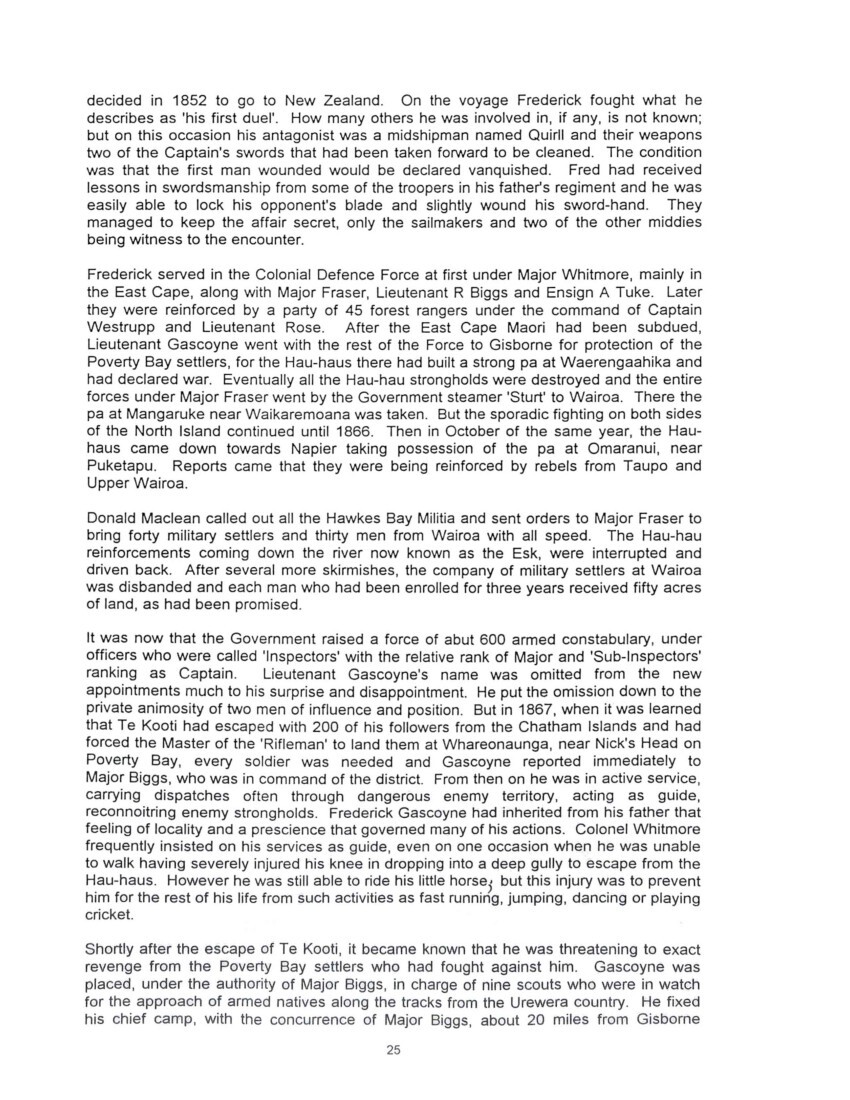
Page 26
where the main track to Wairoa descends to the Hungaroa Stream. At night the horses were concealed in the surrounding bush, but still saddled in readiness for swift mounting. The men slept in the open in the shelter of thick scrub. Six men were on guard each night and remained fully dressed and armed. Gascoyne always remained awake from midnight till daylight and during the day kept a look-out through binoculars over the surrounding land. They often saw the smoke of fires in the Urewera country, indicating a camp, or cultivation carried out by the rebels. Patrols were sent out daily and Gascoyne himself rode many miles every day.
The reconnoitring went on for some months. Then a very old friendly native told Gascoyne that he believed that Te Kooti, if he made an attack on the Bay, would use an ancient track a long way to the right of the camp. After a careful search, Gascoyne found the old track, deeply worn and overgrown with manuka, in a valley some eight or 10 miles away. There was no sign of life except for wild pigs, but about six miles further on, smoke was seen rising out of the timber.
Gascoyne rode into Makareka [Makaraka] to report what he had learned, to Major Biggs, he asked permission to keep three men watching the valley where the old track was found, for he felt sure that it would be used by the Hau-haus. But Major refused, saying the men could not be spared, and believing that Te Kooti would use the track already being watched and not, he believed, to be impassable.
If he had agreed to do what Gascoyne had suggested, the Poverty Bay massacre would never have taken place. That very night, a party of Hau-haus, after following the old track, was guided by the natives of the district to the house of Major Biggs and there the entire household were murdered. The same atrocities were committed at the home of Captain Wilson about a mile and a half away. Then followed the burning and plundering of the township of Makareka.
By the time Gascoyne had received news of what had happened and had started out for the Bay with his men, they found themselves cut off by the enemy and surrounded by hostile natives. They had to abandon their horses, seize a boat and pull across the Bay to Turanganui. There they found a scene of terror and confusion. All the people from the more distant parts of the settlement, having escaped the first dreadful attack, had crossed to the left bank of the river to seek safety in the old redoubt and to place the river between them and the Hau-haus. Biggs and Wilson now being dead, Gascoyne found himself the only officer at the Bay and set about to restore order and the safety of women and children. It was learned that the settlers on the South side of the Bay had made good their escape along the Coast to Wairoa. Some days later, Major Westrupp and Captain Tuke arrived with a large force of friendly natives from Napier and some of the volunteers of Captain Tanner’s troop. Lieutenant Gascoyne had the melancholy duty of identifying the bodies of those slain and arranging for their burial. Gascoyne never blamed Biggs for what happened, declaring that there was no braver, more prudent or energetic officer in the Colony; but he blamed the ‘niggard policy’ as he called it, which gave Biggs far too few men despite his strong representations of danger, to guard so great an extent of country.
The struggle against the Hau-haus went on and Gascoyne was involved in many skirmishes and pitched battles. Early in 1868, he went to Gisborne by Government Steamer, round to Wanganui to join Colonel Whitmores forces in the struggle against Titokowaru. This took them to Patea, Otautu, through bush country at the back of Mount Egmont, along the same line of country that had been followed by General Chute in his famous march round the back of Mount Egmont to New Plymouth. Here they learned that trouble had again broken out on the East Coast and the government had decided to
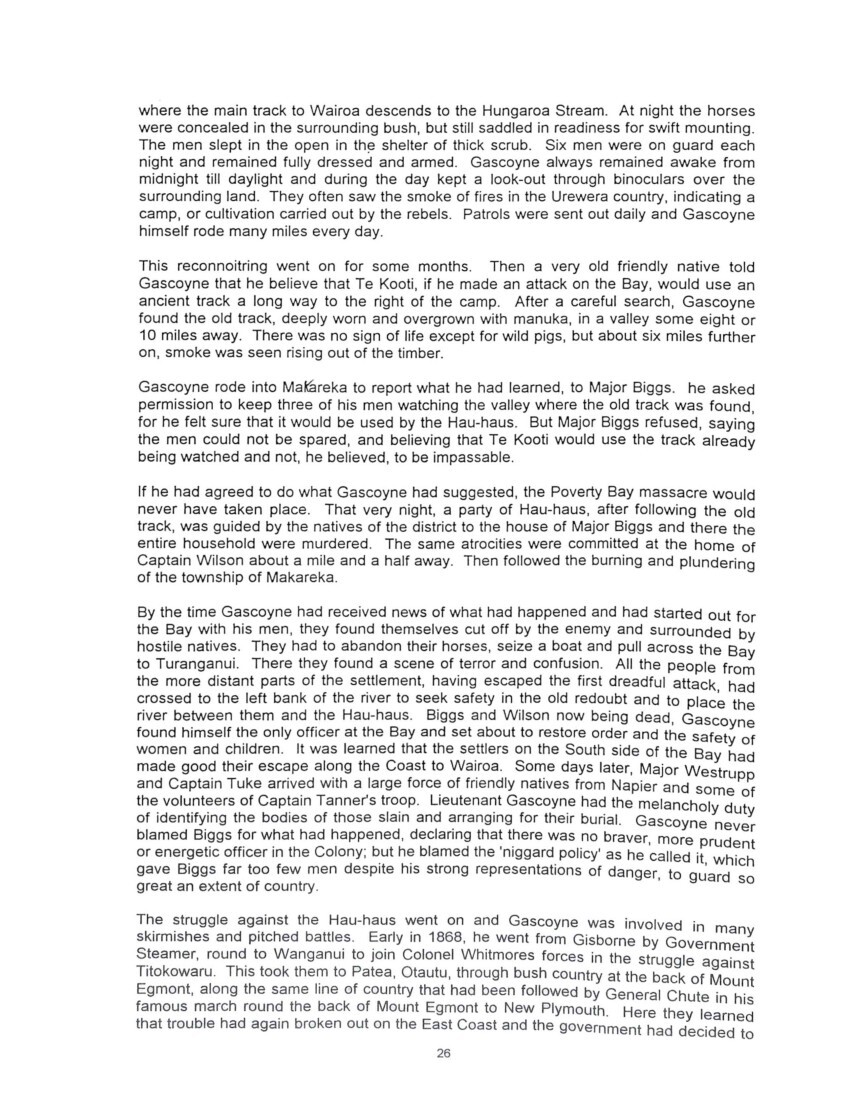
Page 27
send a strong column into Urewera country. Gascoyne’s division was sent from New Plymouth to Auckland and thence to Whakatane and into the heart of Urewera country. From here the column debouched into open country on the Taupo side of the Tahua Ranges and set up camp on the left bank of the Rangitaiki River. It was while they were camped here that Te Kooti, passing Opepe on his way to the Kaimanawa hills, surprised a small party of Bay of Plenty volunteers and killed 11 out of 14 of them, three men only, escaping into the thick bush around them. Nearly all the young men who were killed at Opepe belonged to Tauranga families and their death cast a sad gloom over the district. They had been completely unprepared for an attack.
The division returned to Whakatane and later moved to Rotorua. Gascoyne was sent to Taupo, where they built a redoubt close to the outlet of the Waikato River from the lake. For two years the chief employment of the Armed Constabulary was road making and the officers and sergeants became experts at grading and forming roads, building bridges and culverts. Gascoyne’s men built the first bridge over the Huka Falls and the original AC Bath-house. The experience and knowledge gained by Gascoyne in this field was to prove of great value to him during his years as Resident Magistrate and factotum at the Chatham Islands.
The Maori wars ended in 1870 and in 1872 Gascoyne’s father having died at Paengatotora, he took leave in order to attend to family affairs and later to be married to Marion Carr in Napier. He then took his wife to Taupo, where they lived in the redoubt. Marion Gascoyne had plenty of inner resources and despite the lack of female companionship, was very happy in her surroundings. Participating in the varying interests and mild excitements of a soldier’s wife and enjoying the beautiful natural surroundings and good climate. They saw many tourists and travellers and made delightful excursions on horseback to places of romantic beauty and magnificent scenery.
By 1875, matters affecting the military services of the country were very unsettled, officers were continually transferred from one post to another without apparent reason. Gascoyne was sent to Opepe and then to Tauranga where he and his wife lived close to Ohinemuri. There the Gascoynes remained for a year enjoying the comfort of a two-roomed cottage with a verandah, which they had built and finding it a luxury after having lived in a tent for many months. In 1877, they were once more transferred, this time to Tarawera in the Taupo district. Gascoyne bought a cottage there thinking that he was likely to remain for 12 months at least. He was again in charge of road works and enjoyed the challenge of getting a coach road through from Te Pohue to the north end of Lake Taupo. Tarawera was the half-way rest house for the night, for the Napier-Taupo mail coach, so they saw plenty of the travelling public and never had a dull moment. Gascoyne declared that the three years they spent there, were the most enjoyable he had while in the service of the Government.
During 1880, the Maori under Te Whiti began to interfere with the settlers’ land in Taranaki. The story of how they ploughed up the fields belonging to the settlers, destroyed fences and put up barriers across the roads is too well known for me to repeat it here. But Gascoyne was ordered to Parihaka and quickly went into active service again, leaving his wife with friends in New Plymouth. In 1881, Mr Bryce, who had a very good understanding of Maori affairs and of Maori, retired from the Ministry of Defence and the Hon. William Rolleston took his place. Although the latter was an authority on educational matters and a good farmer, he did not know much about Maori and their ways, or about military matters. The Government did not want to precipitate war again, so the ridiculous business of knocking down the fences erected by the Maori and seizing their ploughs and bullocks when they broke into the settlers’ paddock went on for eight or nine months. Then Mr Bryce took charge again and eventually peace was restored.
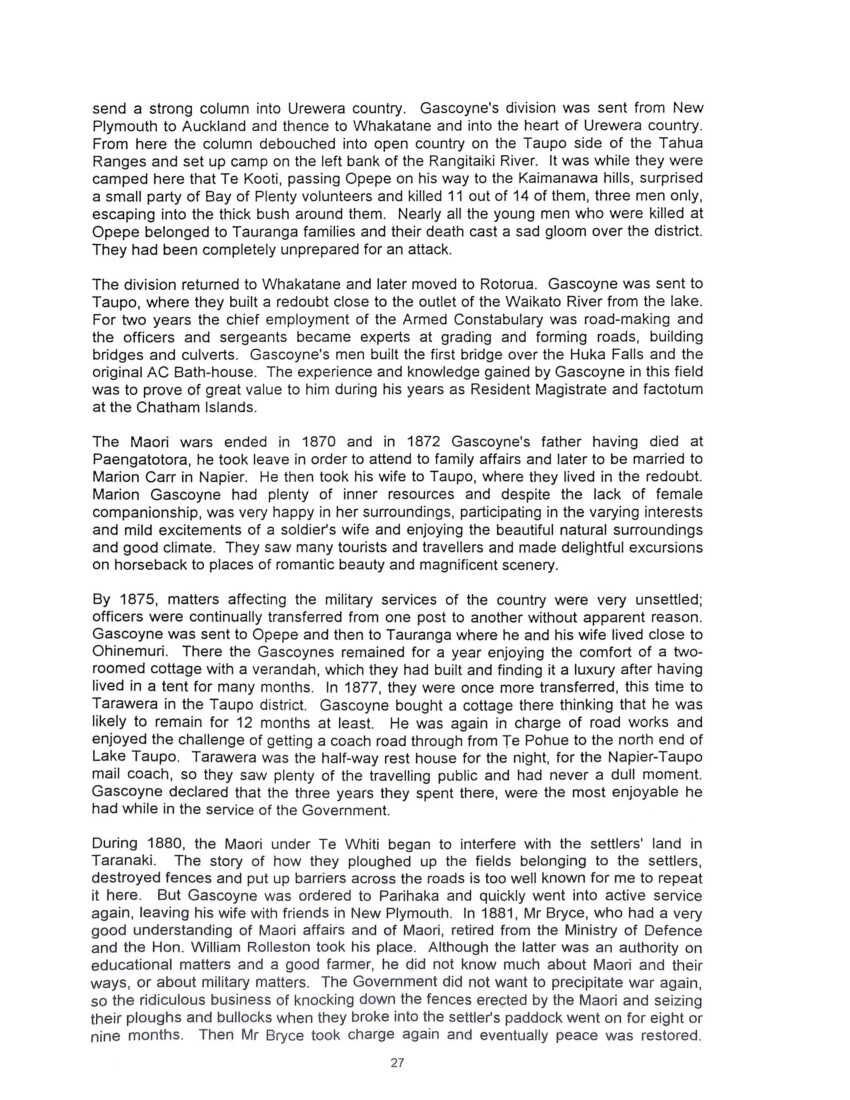
Page 28
Gascoyne was now stationed at Parihake [Parihaka] to keep the natives in good behaviour, and there he built a whare for himself.
The last years of Lieutenant Gascoyne’s service with the Armed Constabulary were spent at Pounake. There he and his wife lived in the quarters on the cliff overlooking the little bay. It was a windy place and flax was the only shelter they could grow for protection of the garden. Even such tough trees as poplar and willow could not withstand the cold winds that blew from the sea. But behind the shelter of flax, Mrs Gascoyne grew beautiful geraniums and pelargoniums. There was a change of government at this time and Mr Balance became Premier. Many changes were made with regard to the military forces of the colony. Peace had been assured with the Maori, but attention was now being focused on defending the Chief ports of the country should there be the threat of an invasion by a foreign enemy. The authorities decided to select the men required for the field and Garrison Artillery from the Armed Constabulary. In 1885, Lieutenant Gascoyne was promoted to the rank of Major and later in the year he was left in command at Opunake, Colonel Roberts, N.Z.C. Having been ordered to take command of the Auckland district.
He rented and later bought a house in Adelaide Road but lived mostly at the Heads, as Point Halswell was usually called. Early in 1887, Major Gascoyne was ordered to Wellington to take charge of the artillery stationed in the forts at Point Halswell near the entrance to the harbour. The men stationed there were employed in building forts, gun pits and bomb-proof chambers, under the General Supervision of Lieutenant-Colonel Boddem of the Royal Engineers. Gascoyne enjoyed this period as it was a complete change of employment for him; but he had at this time great anxiety on account of his wife’s health. He knew he was unpopular in certain quarters, that he was known to be an aggressive member of the Conservative Party and he was not over surprised when he learnt that his services and those of Colonel Roberts, Major Tuke, Major Scannel and five other senior officers were to be dispensed with. Most of these officers were posted to other lesser positions, Gascoyne being appointed Sheriff of Auckland. The remuneration was so small however that he rented a large apple orchard in the hope of making a profit by the sale of fruit. But the orchard did not pay expenses. This failure made Gascoyne and his wife decide to shift into Auckland, and at the end of the year he was placed in charge of the Government arms store and magazines at a slightly better salary.
The general election of December 1890, returned the Balance Government to office and Mr R J Seddon became Defence Minister. After a brief and rather unfriendly tour of inspection by the Minister and his staff, Gascoyne was not surprised to receive notice that he was ‘retrenched’. His billet was duly bestowed on a man more in sympathy with the Government.
Before telling the story of Fred Gascoyne’s years at the Chatham Islands, and of his niece Caroline’s life there during her three years with them, I shall go back to relate what happened to the rest of the family after the death of their father.
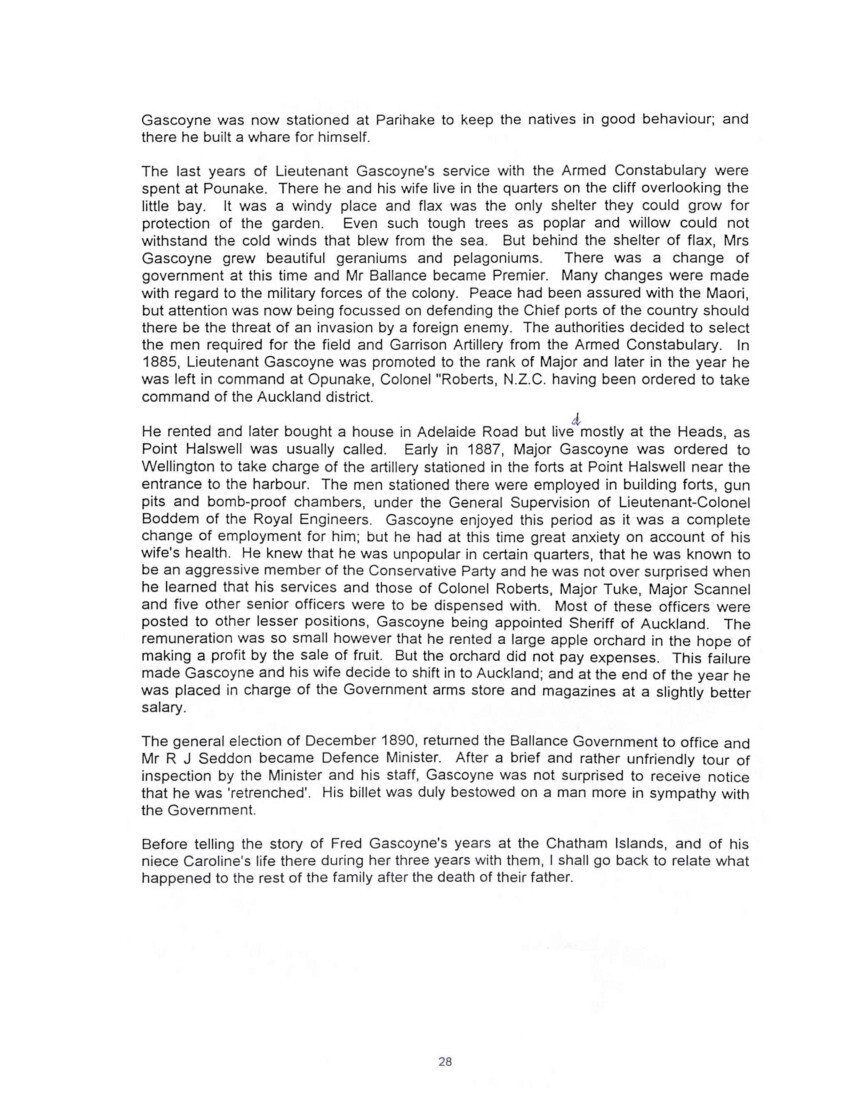
Page 29
CHAPTER IV
THE FAMILY SCATTERS
After young Isabelle’s marriage to her John Greenwood in 1858, there remained four daughters and one son at home. Of the girls, Mary the eldest was still only 18 and Caroline the youngest, was eight. The parents and Miss Sutherland continued to instruct the children in both cultural and practical pursuits and no doubt they received what in those days was considered a good education. They spoke their own language beautifully and were fluent in French and Hindustani too. There must have been a great bond between these early settlers and an eagerness to help one another whenever the opportunity arose. Charles and Isabelle knew many of the elderly colonists including the Wakefields. Edward Gibbon Wakefield who had retired in Wellington must have visited them earlier on several occasions. Indeed as little Emily blossomed into a very attractive 17 year old, Edward was fascinated by her and paid her many attentions. Emily was an intelligent and highly imaginative girl, well able to converse with a man much older than herself and Edward Gibbon and his past escapades, as well as his ability, no doubt fired her imagination. Emily had a secret craving to be an actress; but this of course her family would never have countenanced. When she was an old lady she gave me a little silver thimble that Edward had given her. I could not resist the temptation to ask her about the donor. But she only smiled sweetly with a far-away look in her eyes and said, “Poor Edward! He was charming but a very frail man and in his latter years always wore a back-brace.” I learnt nothing more about this sentimental friendship, but I still use the little thimble.
Young Charles suffered most from the lack of a formal education, for he had an inventive mind and a flair for design, which could have taken him far. He must have been a great help to his father. I doubt if the farm was ever very lucrative and eventually they lost it and all their savings. I can only explain how this happened, from what my mother told me. Charles Gascoyne’s health had begun to fail in the early 1870’s and while he was very ill, he was attended by a doctor who persuaded him to take him into partnership. Thinking that the responsibility would be shared by so doing and his family might be more secure, Charles had agreed. And when he died at the ‘Bungalow’, Totara, Motueka, in 1872 aged 66, it was found that the new partner was an insolvent debtor. The property had to be sold and most of the Gascoyne money went to pay the debts. How long Isabelle and her children remained in Motueka I do not know, but it was 31 years later that Isabelle died in Nelson at the age of 93 I can find no record of her life there, but her children all married except Mary, Charlotte and Caroline.
After the collapse of their fortune it was necessary for the family to find some way of existing. Mary had a very strong character, a good intellect and great determination. She accepted a post as head mistress of a primary state school for girls, the Toi Toi Valley Girls’ School, and earned the respect and affection of the community and the pupils, who called her “Gassy”, behind her back of course. Never having been to a school herself, they had always had a Governess – it was surprising that she was a strict disciplinarian and a good teacher and administrator.
She enjoyed her work greatly. The school was pulled down after her time and moved to a warmer place. Mary spent her last years in Hastings, looking after her brother Fred Gascoyne, after the death of his wife and keeping house for him. She died in 1928 aged 90 years.
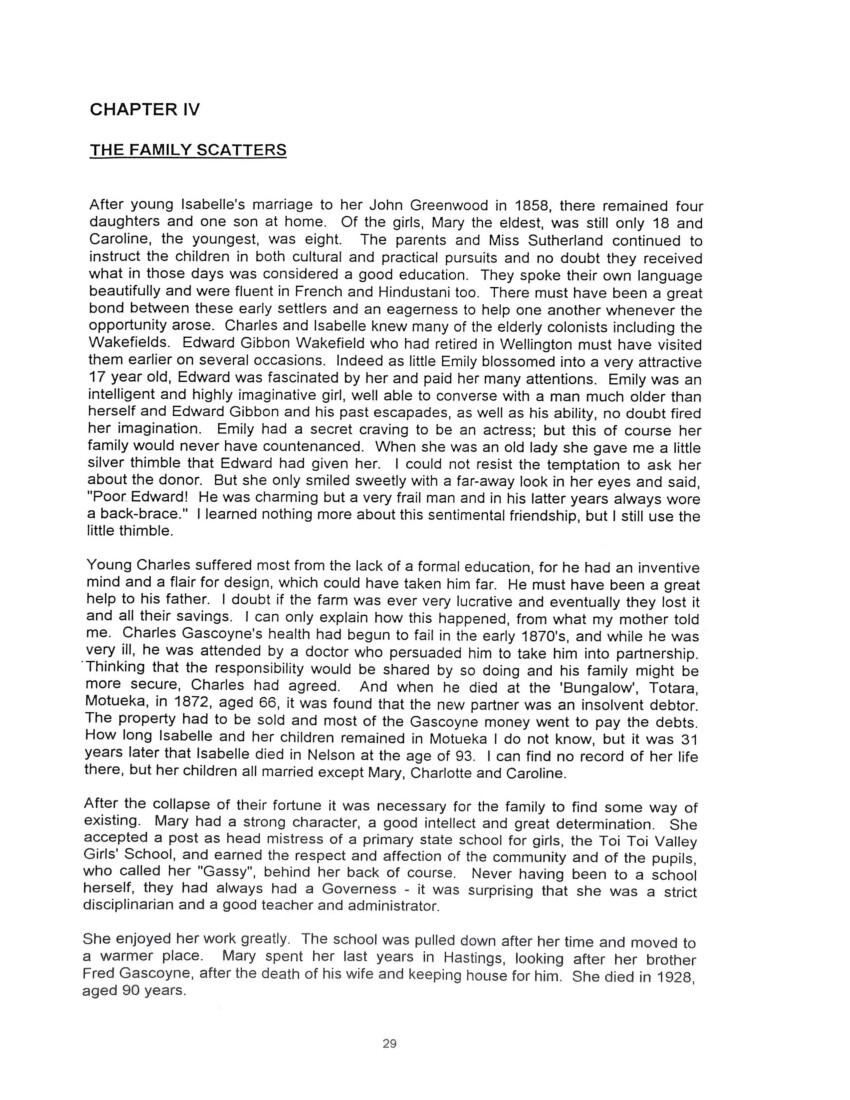
Page 30
Charlotte and Caroline, the youngest daughters of Charles and Isabelle, lived at home till after the death of their parents and of Miss Sutherland, when they went to live in a two-storied house in Milton Street, opposite the South-west corner of the Nelson Botanical Gardens. They became well- known personalities and were quite eccentric. A letter from an old resident, Mr Gough Rankin, says, “Each sister kept a wonderful garden. One had a vegetable garden and the other grew flowers. One sister used the kitchen in the morning, the other in the afternoon. One arranged the flowers in the vases daily, the other left vegetables sufficient for her sister each day, on the kitchen table. One sister worshipped at the Baptist Church, the other at the Presbyterian. One used the front of the house and entertained her friends there, while the other used the back entrance. They did not have the same friends, so their lives were completely divided. As a young lad I used to take horse and cow manure to their gardens, about a mile from my home, in my little cart, for three pence a load. Yes, I knew them well. When I was 14, I left home, and was away from Nelson close on 20 years. On returning I learned that Miss Carrie was still living. She met my wife and became very friendly with her. Indeed on hearing that my wife had lost a brooch, Miss Gascoyne took to a jeweller a sterling silver spoon and asked him to melt it down and make a replacement brooch. This I still have”.
It is sad to think that the sisters, were so incompatible and that they had no pleasure in each other’s company. They were very independent and each had her own opinions, very decided ones; neither would give way to the other and no doubt they preferred to live quite apart rather than be constantly quarrelling. The residents of Nelson were well aware of the fact that the old ladies did not get on together and kept very much to themselves, but they respected them and found their eccentricities rather endearing. Caroline sold her cut flowers and gave all the money to charity. She loved children and would hurry to her gate to talk to a child or to make a little gift, enquiring after its family and always requiring a correctly spoken answer. Chattie used to ride a bicycle with wooden mudguards and take her garden produce to friends or sick neighbours. Long after the old ladies had died, the house, having fallen into decrepitude, was pulled down and it was interesting to discover that the piles were perfectly intact and firm. They had been made of stones used for ballast in the early sailing ships that came to New Zealand.
Charlie, the younger of the two Gascoyne brothers left home in 1871 the year before his father died, to become a wheelwright in Marton. When he was 25, he married Mary Wright and they had two children. Later they moved back to Motueka Valley and then to Nelson, where they remained for the rest of their lives. Charles died in 1923, some years after his mother Isabelle. By this time he had made quite a name for himself as an inventor, but it is doubtful if this hobby ever reaped much financial reward for him. He invented the signal-arm for use in the railway and sold the patent for $25. It found international use. His wool-press was particularly acceptable to sheep farmers and many of the original models are still in operation in this country. The swingletree he designed enabled horse-drawn vehicles to be manoeuvred with ease. Some of the beautiful pieces of woodwork he created are still in existence today, among his descendants.
I must say a word here about Charlie’s only son, Archibald Braeburn Cecil Gascoyne. Though Archie’s ancestors were giants in history, for he was the second cousin of the Marquess of Salisbury and the Duke of Argyll, he was a man of very small stature. Everyone called him ‘little Archie’. He could not have been a midget, but he just did not grow. He was educated in Motueka but because of his size he was limited in what he could take up as a career. He was not academic, but like his father enjoyed using his hands. For some years he worked as a mechanic for a cycle manufacturer and dealer, and he repaired cars of three Nelson doctors who were among the first in town to own cars. After his father’s death, Archie was able to live on the interest of the money
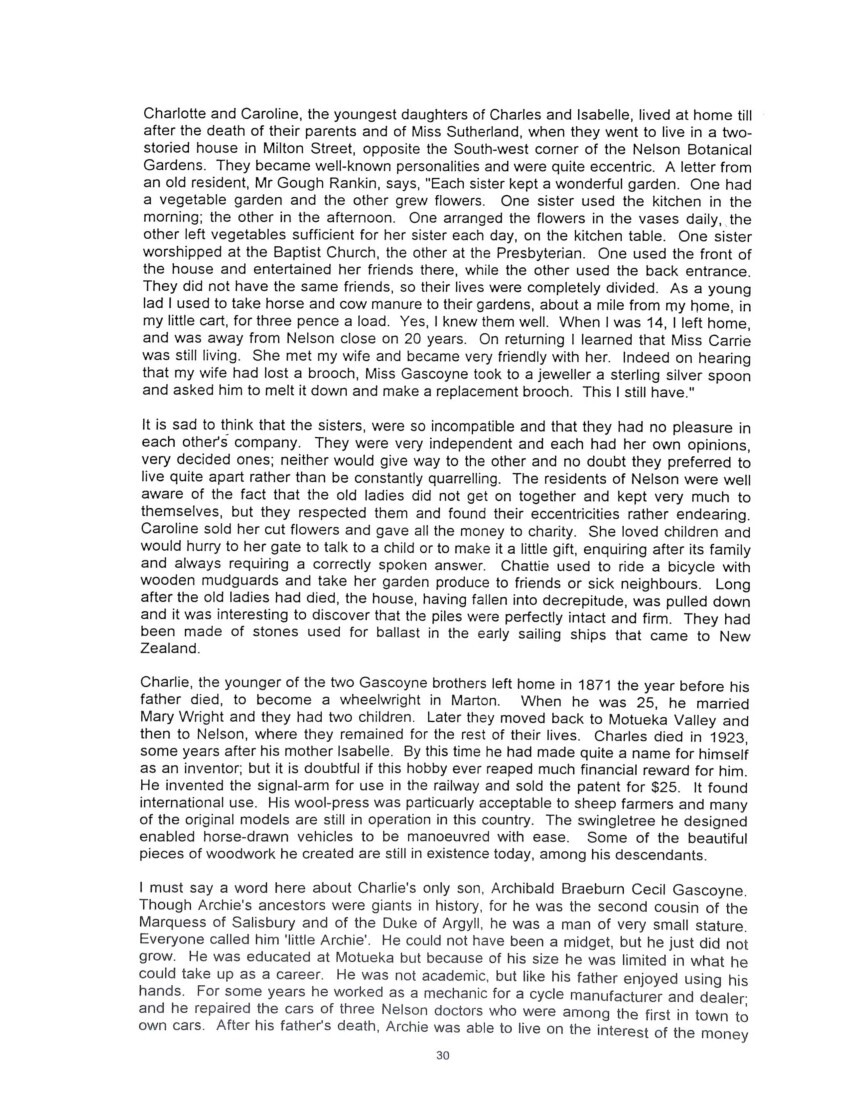
Page 31
left to him; and he devoted himself to helping others less fortunate than he. He was a self-taught musician and played the piano and sang with some ability. He became very much in demand as an entertainer, soon learning to play other musical instruments. He joined the Nelson Garrison and City Brass Bands, playing the side drum. Everyone in Nelson knew little Archie! For years he was a familiar sight in the city streets with his small hand-cart and big load of wood which he was either taking to friends and neighbours or giving to the Boy Scouts for sale. Archie lived to be 87 years old. Despite his handicaps he was a happy soul and no one could deny that he had made the most of his little life.
Now I must go back to Emily, the middle member of the family and my grandmother at the time of her marriage, her husband, Henry Morris Gascoyne, her first cousin, had a wine and spirits retail business in Waimate in South Canterbury. He also indented books for sale, and the business promised to be lucrative. On his marriage, Henry bought a small house in town and there his children were born, two boys and three girls. Emily had many friends, attracting to her especially those who had a similar background or academic inclinations. But Emily felt that her husband’s retail business was beneath their social position. She was a proud woman, despite her charm and natural kindness and she was not happy till her husband sold the business and bought a small farm about three miles out of town. Henry knew not much more than his father-in-law uncle Charles, had known about farming when he arrived in New Zealand, but he was not afraid of hard work. Nevertheless it was a long time before he made much profit from the land. Ironically, the wine and spirits business became well-established with its new owners and flourished.
Henry was a quiet, thoughtful man and wisely retained the house in town, realizing that it could be a great asset when he could no longer work the farm. He loved his wife dearly and was willing to indulge her as far as possible. No doubt he was aware of his good fortune in having land of his own in a part of the country where there was little or no strife and life could be lived peaceably among friends. He must often have thought of the dreadful fate that had befallen his eldest brother Bamber, some years before. It was like a hideous dream. Lieutenant Bamber Gascoyne had given up his appointment in Melbourne in the Mounted Police and the gold Escort, to come as a military settler to New Zealand. He had arrived in February 1864 in New Plymouth with his young wife, and received a commission as Ensign, and was stationed with two other settlers at the redoubt at Pukearuhe.
At the time of the incident which I’m about to relate only briefly, because it is a well-known story, the Maori Wars in Taranaki were virtually over and the Imperial and colonial troops had been withdrawn from the Taranaki northern outpost. There were few military settlers left either, for many had been lured away by the fantastic tales of discovery of gold on the Thames Coast. Lieutenant Gascoyne had built a little house with a rough fence of boughs around it, not very far from the redoubt and behind it. There he lived with his young wife and three little children working the land and cultivating his crops, when he was not required for military duties at the redoubt. The military outpost was called ‘Clifton’ and for a long time it kept that name. As Lieutenant Gascoyne had spent many years of his life in Clifton near Bristol in England, he had probably suggested the name, thinking nostalgically of his far-distant home town.
On Saturday, 13 February 1869, when the Taranaki settlers were at last beginning to feel secure, a war party of Ngatimaniapoto, the section of the great Waikato tribe residing at Mokau, excited by the success of Te Kooti and Titokowaru and encouraged by the fact that the Imperial and Colonial troops had been withdrawn, approached Pukearuhe, the British redoubt at the Whitecliffs, 36 miles from New Plymouth. The Taua or war-party
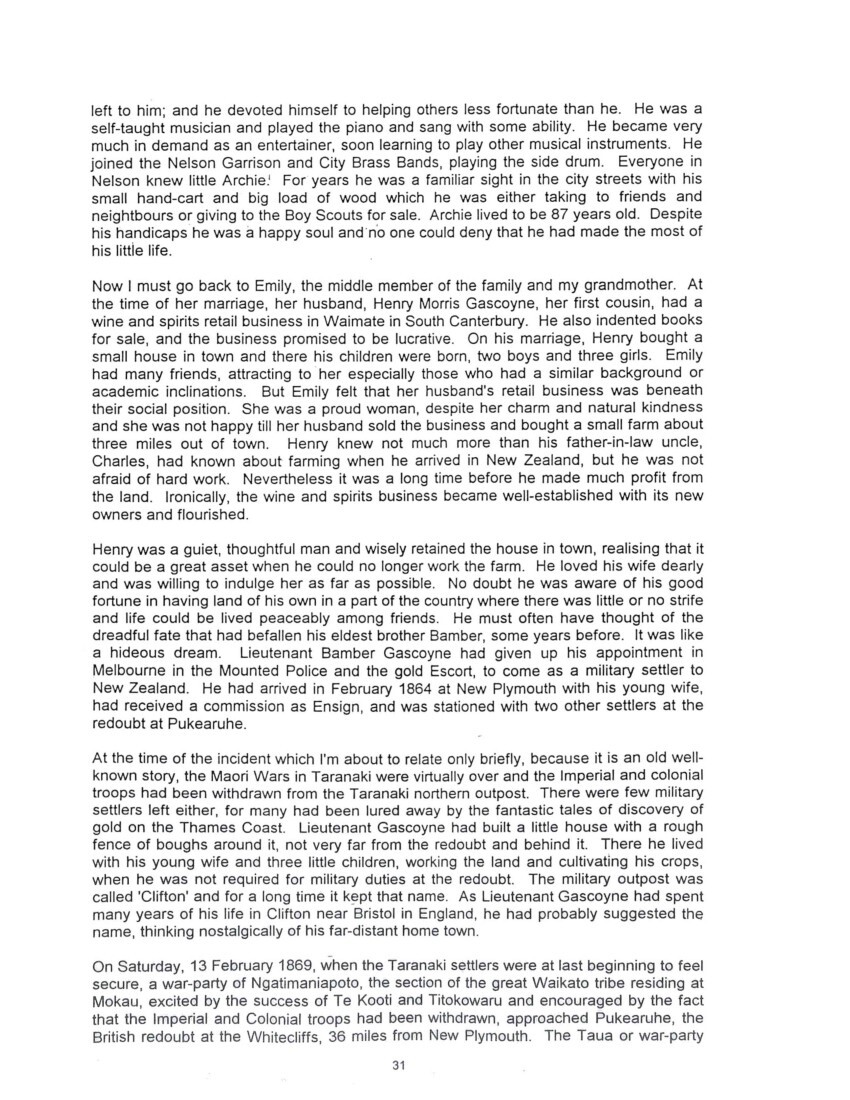
Page 32
approached in broad daylight, forcing four Maori returning from New Plymouth to Waitara to accompany them and take part in the coming tragedy. They found at the blockhouse only two Europeans, Milne and Richards, whom they enticed away by telling them there were pigs for sale on the beach. These two men were ambushed on the track down to the beach and tomahawked. The Taua then rushed up to the redoubt, only to find that Lieutenant Gascoyne and his family were away working in their fields of corn and potatoes, However Gascoyne had seen the Maori entering the blockhouse and calling his wife to his side, he took the baby in his arms and they all proceeded towards the group. When they reached the little stream at the base of the hill on which the blockhouse stood, Gascoyne gave the child to his wife and went forward to meet the Maori. He greeted them and was about to enter his house when he was struck down from behind. His wife and children were then brutally murdered, the blockhouse and huts plundered and burnt. Back in New Plymouth, the Reverend Whiteley, hearing that there was trouble brewing at the Whitecliffs, had set out on horseback, hoping to prevent bloodshed. Although he had been warned that his life would be in great danger and urged by those he met on the way to turn back, he refused, saying, “My duty is forward.” About 30 yards from the blockhouse, as he came up over the side of the gully, he was seen by the Maori, and he and his horse were at once shot down.
The event aroused a widespread feeling of horror, not only among the European population, but also among the Maori, who now only wanted peace and could not understand how any of their race could have brought themselves to murder their beloved pastor. The atrocity was discovered on the following Monday by a young man named Macdonald, who immediately took the news to New Plymouth the next day an armed party proceeded to the Cliffs in the SS Wellington to recover the bodies. They were brought in a dreadful state of mutilation to New Plymouth and interred with military honours in the Te Hunui Cemetery, where an obelisk has since been erected in their memory.
There one can read the names of those massacred:
Bamber Gascoyne 38 years
Annie Gascoyne 27 years
Laura Gascoyne 5 years
Cecil John Gascoyne 3 years
Louise Annie Gascoyne 1 year
John Milne 40 years
Edward Richards 35 years
John Whitely, Pioneer Methodist Minister
The Maori of Taranaki mourned deeply for John Whitely who had been so good a friend and mediator for them for 37 years. The war in Taranaki ended with this isolated though terrible act. The Government was unable to punish the murderers and consequently they were never brought to justice.
Henry Gascoyne had further reason to make him a thoughtful and rather silent man. In February 1869, only two months earlier than the events I have just described, he had received news of the death of a cousin in equally tragic circumstances. George Wilcox Gascoyne has served in the Royal Navy and was at the time stationed in Melbourne. Driven by the spirit of adventure and the desire to make his fortune, Captain Will decided to sail his little cutter, the “Sperweer’, right up the east coast of Australia and round the tip of Cape York, in search of Pearl-shell and Beche de Mer, the sea-slug so popular then among the gourmets of the world. He had heard that this marine treasure
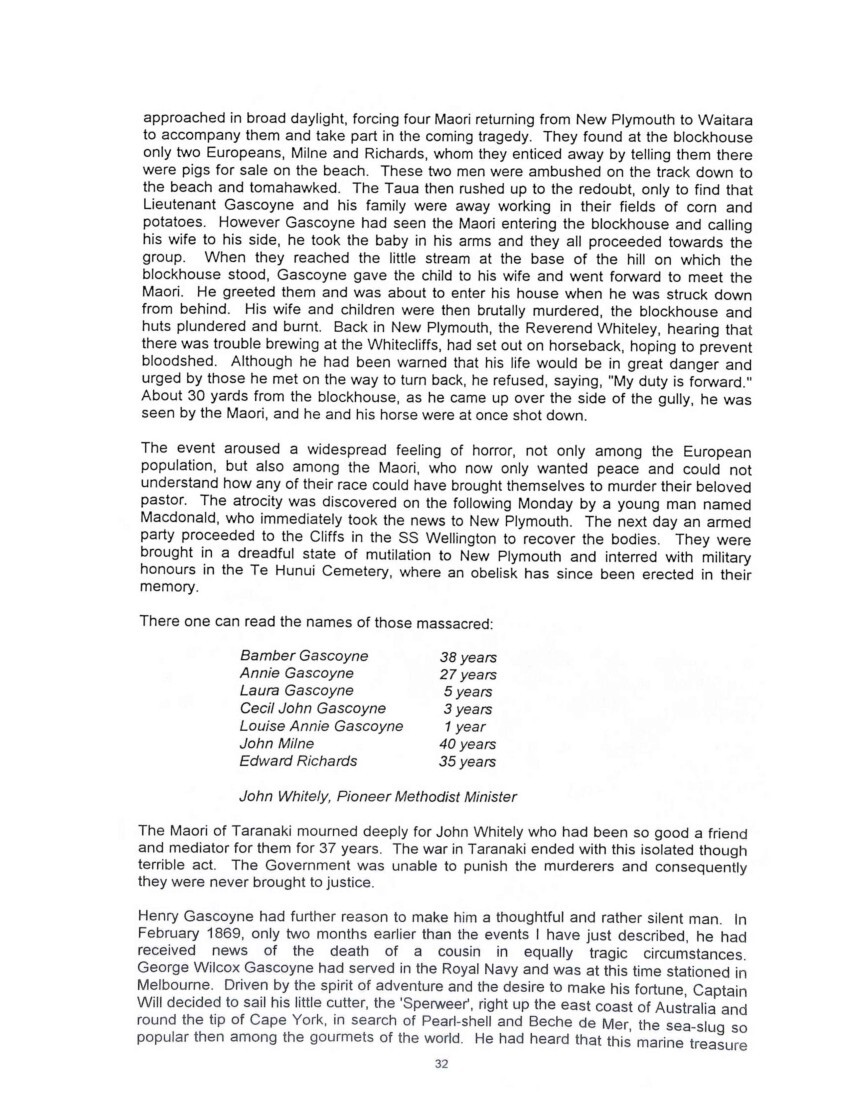
Page 33
was plentiful in the Torres Strait. He surely could not have been aware of the terrible dangers that lay ahead on the long journey, or he would not have persuaded his wife and 12 year old son to go with him. The natives were very hostile in the North and Captain Jardine, the resident magistrate in the small settlement of Somerset was at that very time anxiously awaiting the arrival of a schooner to take him to Brisbane, where he intended laying out recommendations to the Colonial Secretary concerning the development of Somerset and the much needed protection of ships on the high seas.
Captain Will knew nothing of this. He Had on board besides his wife and son, a crew of 17 men, mostly Asiatics. They succeeded in navigating the 1000 mile dangers of the Great Barrier Reef and passed seaward of Albany Island, unaware of the sheltered haven of Somerset lying to the West. Had Captain Will remained there, he would certainly have been warned to proceed no further. As it was, he continued to sail North for another 30 miles, rounded the Cape and entered Torres Strait. He dropped anchor off Friday Island, a few miles from Prince of Wales Island, where 20 years before, Barbara Thompson, castaway from a wreck, had been rescued after seven years of captivity. Captain Will seems to have been ignorant of the savage hostility of the natives living there, or perhaps he had heard the stories and considered they were exaggerated. There must have been no thought of danger, for the crew went ashore to cut wood, while Captain Will, took advantage of the quiet anchorage, went down to his little cabin to write up his log. No doubt his wife and son remained on deck to enjoy the beauty and peace of the tropical night.
What followed was as terrible as it was unexpected. Suddenly a horde of black savages, their naked bodies smeared with grease and their heads adorned with feathers, swarmed onto the deck of the defenceless vessel, brandishing clubs and spears, shrieking and chanting their warsongs. They had crowded into their war canoes at Prince of Wales Island, paddled across to Friday Island, made their way through the bush to the small beach on the other side, and then swum silently out to the little ship lying so still and quiet on the calm sea. The attack was soon over. The Captain’s body was pierced with spears hurled through the skylight. The ship was looted and then set on fire; and Mrs Gascoyne and her son were taken as captives. The rest of the story is shrouded in mystery. The crew gathering wood on Friday Island must have been in hiding and seen what had happened for one who escaped slaughter told later how he saw the ship burning and the white woman and her son on the beach, surrounded by gesticulating natives and gazing in horror at that dreadful pyre.
It was many weeks later that the news reached Somerset. A canoe had been found off Prince of Wales Island, containing various articles of ship’s property, fairly new, and the ‘Sperweer’s’ log, with the last pathetic entries of the dying Captain. A punitive expedition set out and the natives were attacked, a terrible slaughter ensuing. Mrs Gascoyne’s body was found at the top of a hill where a corroboree had been taking place. She had been dead only a very short time, her death due no doubt to privation and shock. There the searchers buried her overlooking Endeavour Strait. No trace of the son was found, but it was later rumoured that he had been passed round from Island to Island. When questioned as to the fate of Mrs Gascoyne and her son, the natives maintained an uneasy silence or stubbornly denied any knowledge of the event, but if course they knew.
The successor to Captain Jardin, Lieutenant H M Chester, on hearing further stories about a massacre by blacks, of a ship that had been burned and of white captives and failing to find sufficient detail in the official records, sent out the gunboat ‘Blanche’, just arrived with stores, to find Mrs Gascoyne and to exact more punishment. Although the first expedition had returned a week or two before, Lieutenant Chester could not have
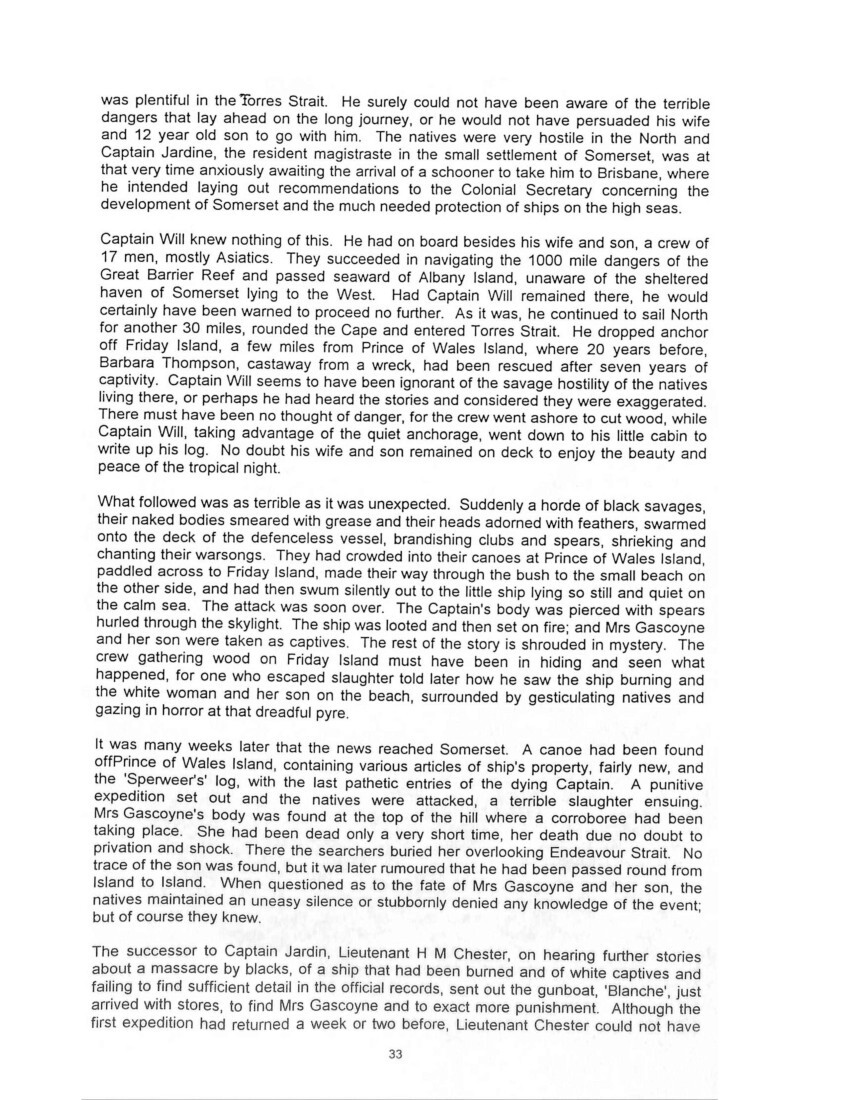
Page 34
known that Mrs Gascoyne was dead. This seems strange, as one would have expected Captain Jardine to have recorded the fact. The crew found the big island completely deserted, so they sailed on to Wednesday Island. There they found canoes on the beach and a number of natives sitting round fires and feasting. It was later learned that these were mostly visitors from other islands who had come to join their friends in a ceremonial feast. The men of the ‘Blanche’ were not to know this, and the chiefs were brought forward and summarily shot. The tragedy of the ‘Sperweer’ had been more than amply, if not justly, avenged.
The memory of these events must still have been fresh in the minds of Henry and Emily Gascoyne, when the second tragedy – the Whitecliffs massacre in Taranaki, New Zealand, took place.
Of the five children of Henry and Emily Gascoyne, Harry and Arthur left home to make a life of their own when they were of age to do so. Harry became manager of Sir Douglas McLean’s sheep station at Maraekakaho in Hawke’s Bay where his Uncle Fred had worked as a young man. On Sir Douglas’s death the estate was divided up and, Harry was able to buy a part of the land himself. He had married a Scottish girl, Elsie McLean and they had only one son who predeceased them both, thus ending the line of Gascoynes on the male side. Arthur became a builder, married twice but had no children by either marriage.
Laura remained single and continued to live at home – later in the town house in Waimate. Emie spent years of her life helping her father on the farm and her mother in the house. She became governess and music teacher to the children of her mother’s friends – the Orbells, the Studholmes, the Napiers, the Milners, the Norton-Francis family and other well-known South Canterbury families. Emie was so sweet-tempered and sensible, delightful with children, whom she could manage so well, and very much loved. She used to cycle about 20 miles a day on rough, badly formed roads in the course of her visits to her music pupils, and no-one ever heard her complain.
Later in life, Emie married a widower, Mr Walter Taine, a retired industrial chemist, and lived very happily for many years at Karitane. Her husband had set up a radio station there and during the 1st World War years, it was used by the Government for its own purpose; but Emie and her husband took a great interest in it themselves. She declined to have help in the house and preferred to do her own cooking. When Walter Taine died, Emie went to live with her sister in Waimate, in the small town house. There she devoted herself to nursing her ailing sister for many years. She never considered herself a good nurse, but did not hesitate to sacrifice any of her own plans or wishes to satisfy the whims of her sister and provide her with every comfort. Emie outlived her husband and was anything but a recluse. She went to the Anglican Church regularly, was a member of the Travel Club and the Senior Citizens’ Club and she tried to keep an interest in the social activities of the community. Every day she walked into town to buy her newspaper and each Thursday she walked to the hospital to have two injections, one for her heart and one for her blood. Usually she managed to walk home again and look after herself despite the physical discomfort occasioned by these visits. Tall and straight as a larch, she wore all her life the styles in which she grew up, refusing like Queen Mary, to follow the dictates of fashion. She was always on good terms with her neighbours, who kept a loving eye on her. Several times it was suggested that she go into an old people’s home where she would be well cared for, but the withering scorn with which such suggestions were received discouraged any further efforts. When she was advised to have ‘meals on wheels’ she refused, saying that she was not old enough for that. She was 95, and enjoyed her own food and had a good appetite. Emie died in her
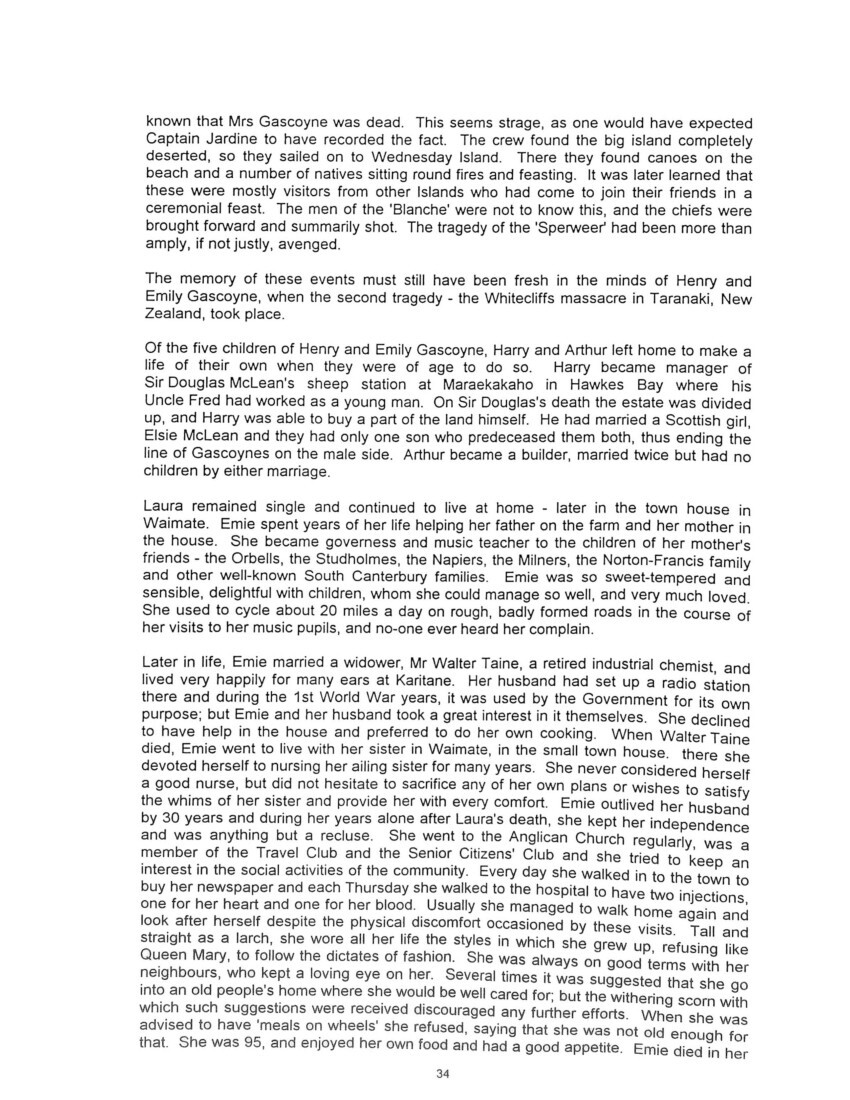
Page 35
96th year, and Waimate lost one of its most colourful personalities and the last of the Gascoynes.
As children, my sister and I used to visit the farm at Hillcrest in Waimate, for we were living in Dunedin from the time I was 11 years old. Our mother Caroline, about whom I shall speak later, could seldom come with us to Waimate as she had my father and our three brothers to look after. We had mixed feelings about these holidays, as we were rather in awe of our aunts. As for the town itself, I can never think of it without remembering that pungent smell of pine-needles in the early morning, the country sounds all round, the huge raspberry field in which I became lost, the patchwork quilt on my little bed where I used to bury my head when I was home-sick and the old dog that was so terrified of thunderstorms that he would paw frantically on the back door, till he was allowed inside to take a humble and inconspicuous place near the warm stove. My own special terror was of cows and my grand-mother’s horse Mollie. She was indeed a spiteful creature, with a wildeye; and grandmother declared that Mollie had more than once tried to kill her. When she was out driving in the Phaeton, Mollie had backed towards a cliff till one wheel had actually gone over the edge and grandmother had had to jump out. I never let Mollie come near me, as I so distrusted her tossing head and long teeth.
Then there was Nellie, the red cow who terrifies everyone and from whom many a time we had to run for the fence. She would begin to act in a sneaky way as soon as she spotted a human being in her paddock, and she had a nasty temper. These two beasts made us wary of all the animals on the farm and spoiled our relationship with them. However, we bravely tried our hands at milking a gentle cow and enjoyed drinking the warm sweet milk, which tasted so different from town milk. We also enjoyed collecting the eggs from the nests in the poultry run, or picking the sun-warmed raspberries, or gathering the little wild flowers that seemed to grow everywhere. The great stretch of grass in front of the homestead was always tawny and dry when we were there and the sun was burning hot. But the mountain stream in which we bathed sometimes was icy cold and once I caught a chill after a bathe and my young sister thought I was going to die. In the evenings we used to listen to our pretty little grandmother’s talking. Grandfather seemed very tired at the end of the day and though he liked being there, he seemed remote and spoke very little. No one in the house ever gossiped and my grandmother never allowed anyone to talk gossip to her over the telephone. If they began to so do, she would immediately burst into French, talking very dramatically and fast and the conversation soon ended, leaving a bewildered listener on the end of the line. But Grandmother was lively and most interested in world affairs. Although she was a staunch Anglican, and rather anti-Catholic, the priests in Waimate used to visit her just for the pleasure of talking to her and exchanging ideas on philosophy and current affairs; and she was always very charming and courteous to them. We were sorry when the farm was sold, and the family went to live in town.
Now I must go back to Caroline, the eldest of Henry and Emily’s daughters and the only one to have children of her own. She was my mother so I know more about her than I ever did about my uncles, aunts or grandparents. Caroline was a little less practical than her sisters, but she had the same independent spirit as Emie, together with a very quick, delightful sense of humour and she could always laugh at herself. As she reached her teens, she became painfully shy and clung to her family, feeling unhappy and ill at ease in the company of strangers. She was gentle and kind and never thought ill of anyone. She told me once that when she was out driving in the phaeton with her mother, they passed a group of people standing on the pavement chatting. As they drove on, she heard a woman say, ‘There goes that Miss Gascoyne. Stook up little thing! Just like her mother.’ Caroline was deeply hurt, she could never have been called proud. How few
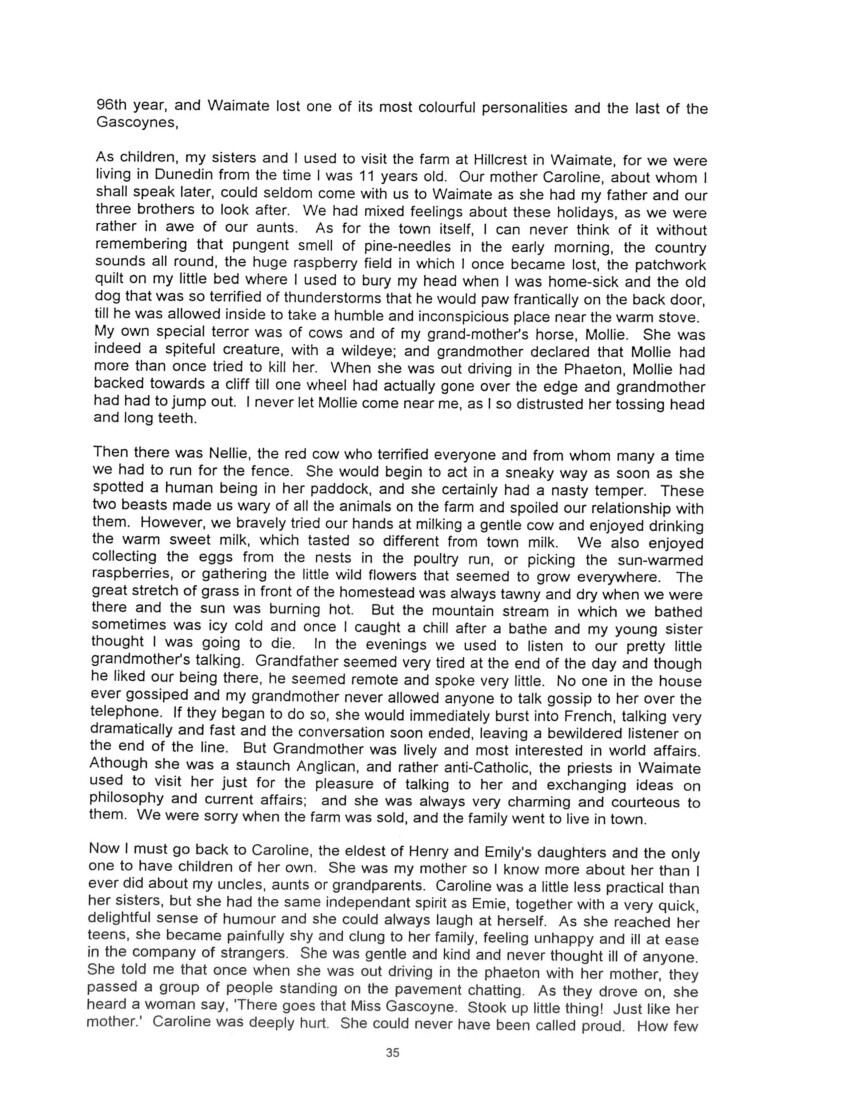
Page 36
people really understood the pain of growing up. In later years, Caroline entirely lost her shyness, and would talk on friendly terms with anyone, no matter what their station in life and was the first to speak, always being able to put people at their ease and at ease herself. I never heard her say an unkind word to anyone, not even when an injustice had been done her.

Page 37
CHAPTER V
THE CHATHAM ISLAND YEARS
In 1891, shortly after Major Gascoyne’s retirement from the position of sheriff of Auckland, news came of an outbreak of disturbances among the Maori at the Chatham Islands; and the Premier, Mr Balance, remembering Gascoyne’s skill in dealing with the natives, asked him if he would go to the Islands and relieve Mr Deighton, the Resident Magistrate at that time. As he was without work, Gascoyne accepted the post, despite the poor salary. He knew he would have a house and was assured that he would not be asked to remain there for three or four years, when peace having been restored, he would be given a better district in the North Island of New Zealand, with an adequate salary.
I do not think that Gascoyne or his wife realized how primitive the islands were at that time. Great cliffs rose straight up from wild pounding seas and there were dangerous reefs and hidden rocks to be negotiated by any ship approaching. There were no roads on the Islands, not even on Chatham, the biggest of the group and no means of transport except on horseback or on foot. The two small villages were both on the West Coast looking over Petre Bay and within a short distance of each other. At Te One were the local school, a church and a small library; and at Waitangi, a decrepit store-cum-accommodation house, the post-office and lock up. The Residency, as it was called, was on a bit of table-land overlooking the Bay from the West. In front, on a look-out hill near the edge of the cliff, a pole had been erected.
There were about 500 inhabitants in the Islands, half of them Europeans and half Maori. The latter were of the Taranaki tribes, followers of Te Whiti with a few of the surviving aboriginal tribes of Moriori. They were generally aloof and rather surly in manner. The Pa, a cluster of rough huts with children and dogs running everywhere, was below the cliff, across the tidal river. Out from the mainland were several uninhabited islands rising steeply from the sea. The Maori used to scale them in order to catch nesting albatross before they could get to the edge of the cliff to take flight. It was a dangerous occupation but the Maori delighted in it. The albatross made good food and the feathers were used for bedding or for ornament, while the feet were made into tobacco pouches or purses. The birds were then boiled and sent to feed the Taranaki Maori. Of course there was a lot of fishing done too especially for cod and hapuka which were plentiful, as were the crayfish.
Having farewelled Mr Deighton, the retiring Magistrate and Captain Fairchild of the ‘Hinemoa’ the Government steamer which had brought them to the Islands, the Gascoynes settled into their new home. They had brought with them their carpets, furniture, silver and even a piano, little dreaming of the ravages that the damp, windy climate would wreck on them. It was not long before moth and mould had got into the carpets, the silver had turned black and the notes on the piano began to be muffled or even silent.
Major Gascoyne became a victim of a kind of influenza peculiar to the Island and it took a very long time for him to become acclimatized. Mrs Gascoyne, however, who had been suffering from what the doctors in New Zealand had diagnosed as Addison’s Disease and had given her no hope of recovery, seemed to gain in strength, enjoying the quiet life and spending much time in the open air, busy with the interests of farmyard and garden, or riding about in the Island.
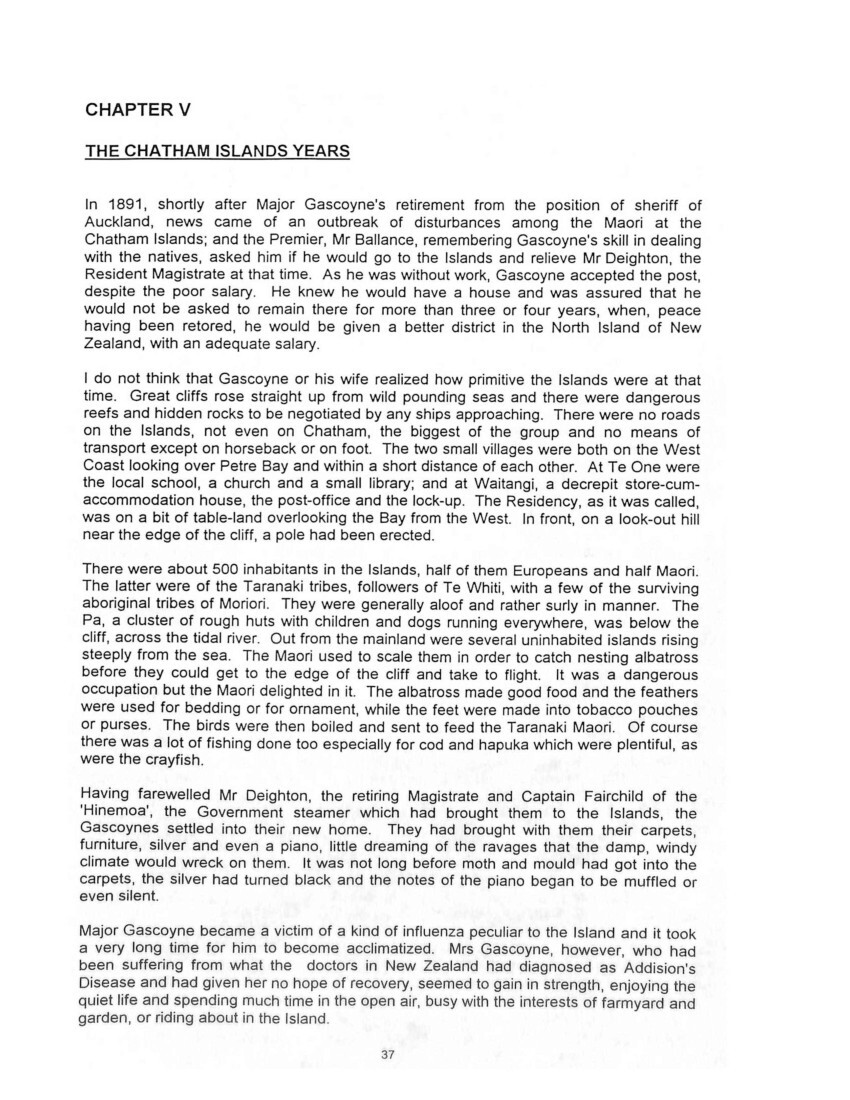
Page 38
One night, shortly after he had taken up his duties as Resident Magistrate, Gascoyne and his wife were awakened by a very strange sound. This proved to be the shuffling of many bare feet around the house. Bidding the members of his household remain where they were, Gascoyne donned his dressing gown and went quietly to the door. When he opened it, he found himself looking into the serious faces of many Maori. He asked what the matter was and why were they there. They replied that they had come to ask him if he would treat the Maori justly, both in Court and outside, in the same way they would treat the Pakeha. Gascoyne was deeply moved and replied that he would be their friend, and that as far as he was concerned, the Maori and Pakeha were equal. After a little more quiet speech, the Maori appeared to be satisfied and disappeared into the night as silently as they had come. Gascoyne kept his word. He learned the Maori language and as much as he could of their customs and they became good friends. He had a true respect for them as people, and the Maori trusted him absolutely, willingly accepting his judgements.
Before he had left Auckland, Gascoyne had been handed a list of appointments and commissions; but he found that, besides being Resident Magistrate, he was to be postmaster, collector of customs, registrar of births, deaths and marriages, receiver of wrecks, licensing officer and paymaster. He had not been many months in the Islands before he was the principal doctor, engineer of wharfs, bridges and roads and referee of all connubial disputes and quarrels, Despite the workload, he came to enjoy it greatly, putting his whole heart into it and gaining a very good understanding of the Maori and of the other Islanders too.
By 1982 [1882] the Gascoynes were beginning to pine for some young company, so having no children of their won [own]; the wrote to Emily and Henry Gascoyne in Waimate, begging them to let Caroline, the eldest daughter go over to them. The ‘Kahu’ was making trips between the Islands and Lyttleton in that year and it was on one of these trips that Caroline set forth to join her uncle and aunt. She was accompanied by Miss Shaw, who was to be companion-help to Mrs Gascoyne and to supervise Caroline’s studies.
My mother was only 17 years of age and as she had seldom been away from her home this was a great adventure for her. The little ship rolled in heavy seas all night and next day, and confined in their stuffy cabin, with clattering noises all around and strange smells, both Caroline and Miss Shaw were very sick. When they reached the wide open port of Waitangi, the ship anchored and the passengers were bundled with their luggage into small boats and taken ashore. Wool bales and other cargo were piled on the beach, surrounded by people shouting, and laughing and gesticulating. As the visitors disembarked, strange faces stared at them and there were many surprised tones and giggles among the inhabitants as they crowded curiously around. Caroline felt as if she were taking part in a strange drama. The Islands looked forbidding, the great cliffs so red and steep and crowned with trees all leaning from the prevailing wind. Caroline knew know to manage a horse, so would not have been dismayed if she found that she must ride to the Residency. Her uncle was there however, to accompany her and Miss Shaw on foot. Those visitors who had some distance to go and could not ride, were nevertheless forced to mount and had to do the best they could. It was inevitable that there were some amusing scenes and a great deal of laughter.
Now a strange life began for Caroline. Shy though she was, she had the eagerness of youth for young company and adventure, but her uncle and aunt tended to be over-protective. Social gatherings were few and far between, but everyone turned out for them. Communication being very clumsy, when there was to be a dance or any other social function, word had to be passed around somehow, so Mrs Gascoyne would take someone with her and ride round the Island to out-of-the-way farms and houses, to
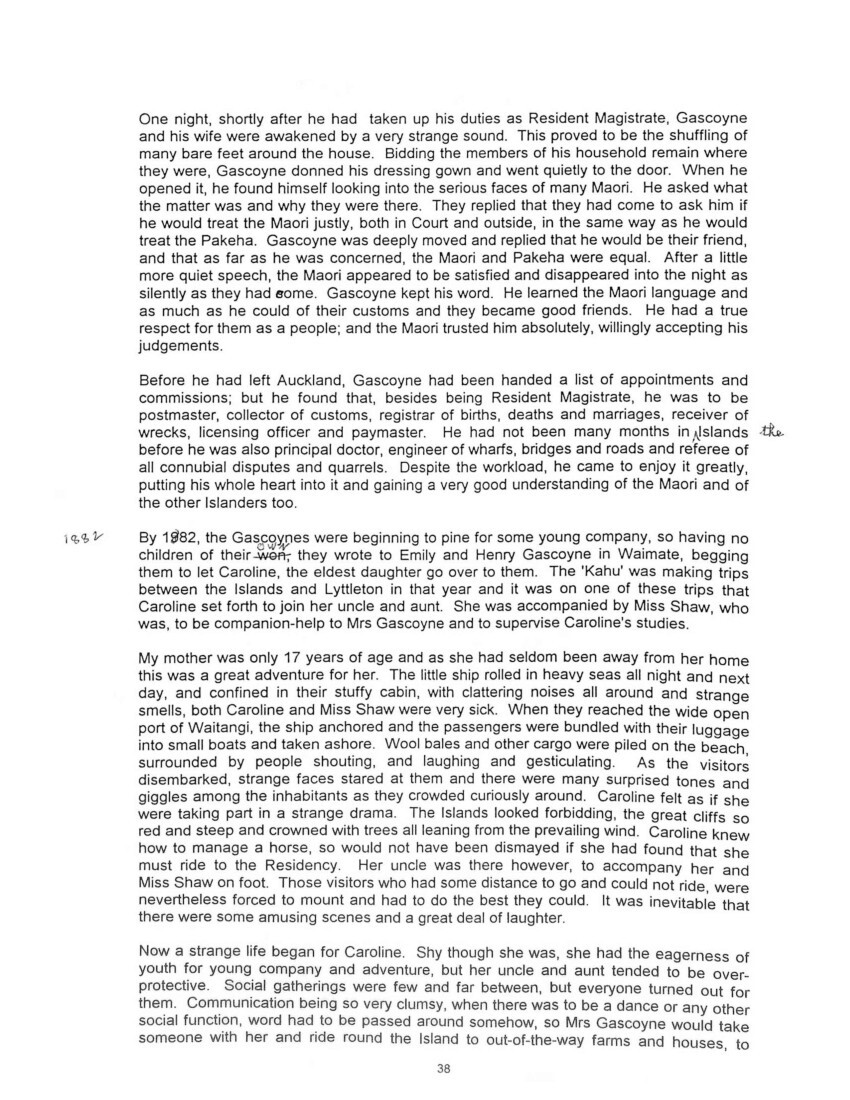
Page 39
announce the coming event. She was not only a good horsewoman, she liked to organize people, and when the Islanders joked among themselves about the ‘Major’ it was often Mrs Gascoyne to whom they were referring.
Although Caroline attended most social functions, she was not allowed to dance. Her uncle explained that if she did, she could not refuse a request, as it would give offence and he did not wish her to find herself with a rough or otherwise unsuitable partner, a situation which could well have occurred. So Caroline had to be content with being a spectator only. However her riding was not restricted, as long as she was accompanied by the Maori boy who helped around the house and garden. The Gascoynes and Miss Shaw always had a siesta in the afternoon and Caroline would wait till they had settled down and then make her escape. She would saddle her horse, Dick Deadeye, call the boy to join her and then they would ride out in search of adventure or merely to enjoy the exercise and breathe the fresh cool air.
The largest of the Islands, Chatham, is only about 30 miles long, narrowing considerably in the middle and approximately one third of the area is taken up by two huge, shallow lagoons, full of wild life. There were rough tracks over the land, which Caroline and her companion followed; but care had to be taken as there were hidden dangers such as burning peat holes, quicksands and bogs. Once, as they let their horses pick their way through a dangerous area, Caroline’s horse suddenly shied violently for no obvious reason and side-stepped into one of the slimy green patches. It struggled to get out, but only sank deeper. Caroline screamed in terror and the startled boy, who was a little ahead, wheeled his horse around and drew level with her. Then, urging her to hold tight, he fell back and gave the animal a strong cut with his whip. The poor creature lunged desperately and managed to get on to firm land; but it was never the same again as its heart was strained in the effort. The boy declared it had shied on seeing a ghost.
On another occasion, venturing along a less worn track, they came out into a little clearing in the thick scrub and found on the ground, the complete skeleton of a human being, the bone bleached to a shining whiteness. The superstitious boy remained at a respectful distance, but Caroline dismounted and examined the skeleton. Around the neck and shoulder bones lay strewn on the ground some rough blue and green glass beads, the string having long since rotted away. Caroline gathered them up carefully and tied them in her handkerchief. Then she gently raised the skull. As she did so, a small round object fell from it. Great was her surprise on discovering that it was a bullet. She put out it with the beads and the two young people returned to the house to tell the Major what they had found. The skeleton was recovered and became a valuable aid to Gascoyne in his study of anatomy. Whether it was that of a Moriori or a Maori I have never heard. The traders’ beads, as they obviously were, were kept by Caroline, and during our childhood they hung, rethreaded, on the wall of our family room among Maori pictures and tools and other small things my mother had collected during her years at the Chathams – stones and shells, skeletons of sea-horses, Maori crafts, weapons, a Chieftain’s cloak and so on. But we were never allowed to put the beads around our necks, lest this be unlucky.
The days must often have seemed long and dreary to Caroline, Europeans did not go bathing as the sea was dangerous and shark infested and of course there were no outdoor sports except fishing and riding, the latter a necessity if one wanted to go any distance. Caroline was devoted to her horse, Dick Deadeye, and it was a great grief to her when he lost him. She had lent him to the wife of the school teacher, who, knowing little about horses, had ridden him into a lather, and on returning home neglected to put his cover on. The poor animal caught pneumonia and died. There were other horses for Caroline to ride, but none took the place of her first companion, old Dick.
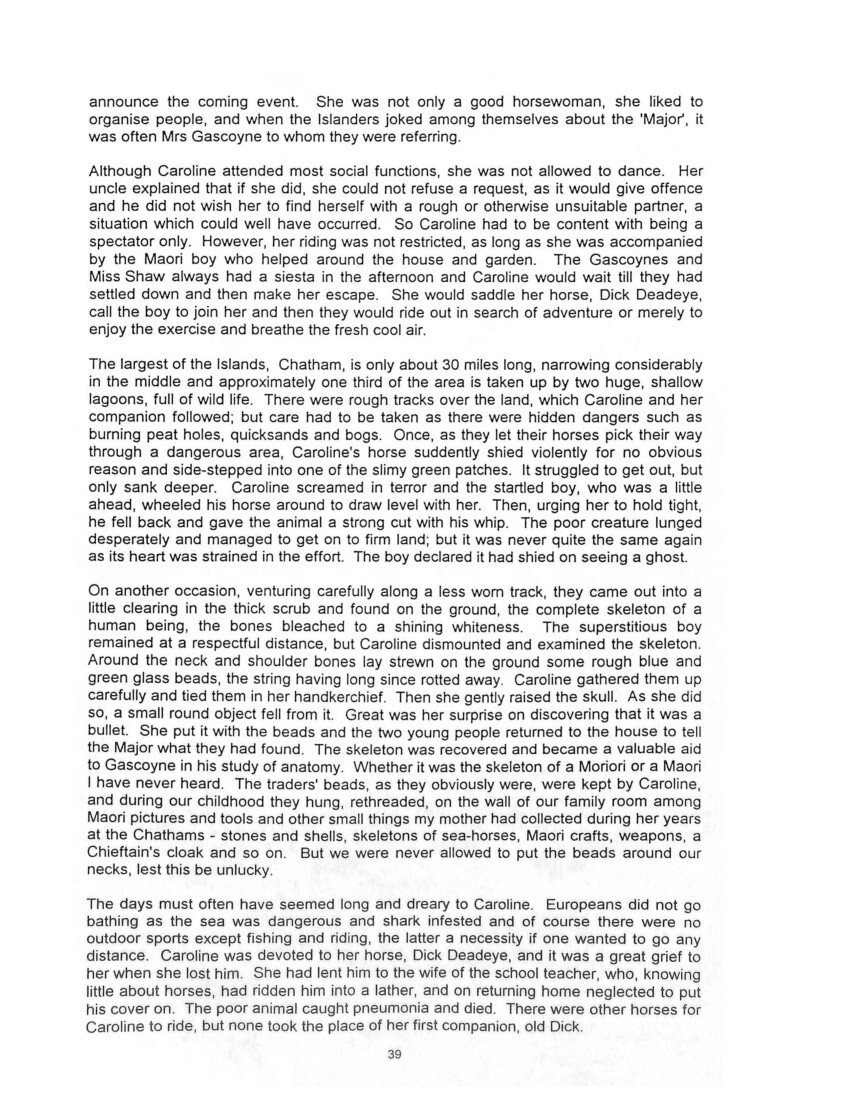
Page 40
Caroline loved birds and insects and all animals. She had a tame seagull with which she spent many hours and she was never afraid to pick up spiders or bees and examine them closely. She often worked in the garden with her aunt, or sat sketching or painting anything in which she was interested. She played the piano, sewed and read and accompanied her aunt and uncle on trips around the Island. The beautiful Chatham Island lily with its vivid blue flowers like large forget-me-nots, flourished everywhere and Caroline determined that she would have it growing in her garden in New Zealand when she returned. After her marriage she lived in eight different homes from Auckland to Invercargill, before, on returning to Hastings she found the place and the climate where she was successful in growing the lily or forget-me-not, as it is usually called.
The great problem of the Islands was their distance from New Zealand and the very rough seas. The needs of the people were different too, for the land not being fully developed, the manner of farming was much more primitive. The Government steamer called regularly only every three months carrying stores, passengers and mail; but in 1892 the S S Kahu and the Ohau made crossings, locally known as wool trips, in quick succession, between Waitangi and Lyttleton and Islanders took the opportunity to go to the Mainland for short visits. It was on one of these return trips that Caroline and Miss Shaw had embarked.
The arrival of the steamer at Waitangi was a great event for the islanders. There were no jetty or wharf so the ship had to anchor in the roadstead, after negotiating the dangers of hidden reefs and heavy swells. Passengers and luggage went ashore in dinghies. The inhabitants gathered around the new arrivals, staring curiously at their clothes and at their luggage being taken from the boats pulled up on the beach. The store suddenly became a great attraction and was full of noisy shoppers both Maori and Pakeha, for days, all examining the latest materials for sewing or foods with which to stock up their shelves. The beach was a scene of activity too, for cargo had to be taken out to the steamer so that she could set out on her return journey without delay.
It was not until 1896 that the first jetty in Waitangi was built by Gascoyne at the foot of the cliff, below the plateau on which the Residency stood. It was a solid structure with ironbark piles and proved to be a great asset to the community, especially to the hard working farmers anxious to get their exports away safely and speedily. Gascoyne made repeated efforts to break the power of the squatters, absentee owners holding vast areas of land and employing no labour to cultivate it; but in this he failed. He had seen so much of exploitation in his life in India that he had not wanted to see the same situation develop in the Chatham Islands.
Quiet though life was for Caroline in those years with her uncle and aunt, there were some events which remained vivid in her memory. Huge icebergs were sometimes seen floating northwards across the ocean and in October 1892 two of these vast islands of glittering ice drifted north across the mouth of Petre Bay, a strange and fascinating sight. On the 29 December 1893 at 4am the ship ‘Jessie Readman’, carrying a cargo of 40,000 pounds worth of wool from Napier to London, went aground in a dense fog just off the coast below Mr Chudleigh’s farm at Wharekauri on the North East side of the Island. Gascoyne was too ill at the time to mount a horse and ride over to the coast, but he sent the clerk of the court and later dispatched a full report to Wellington where he wished the case to be tried. Caroline saw the hopelessly wrecked ship lying half submerged just off the shore below the cliffs and never forgot the sight.
In those days gunboats called at the Chatham Islands for naval exercises and any such visit caused great excitement among the people and was always an important event for the Gascoynes. The flag must be hoisted on the look-out hill in front of the Residency
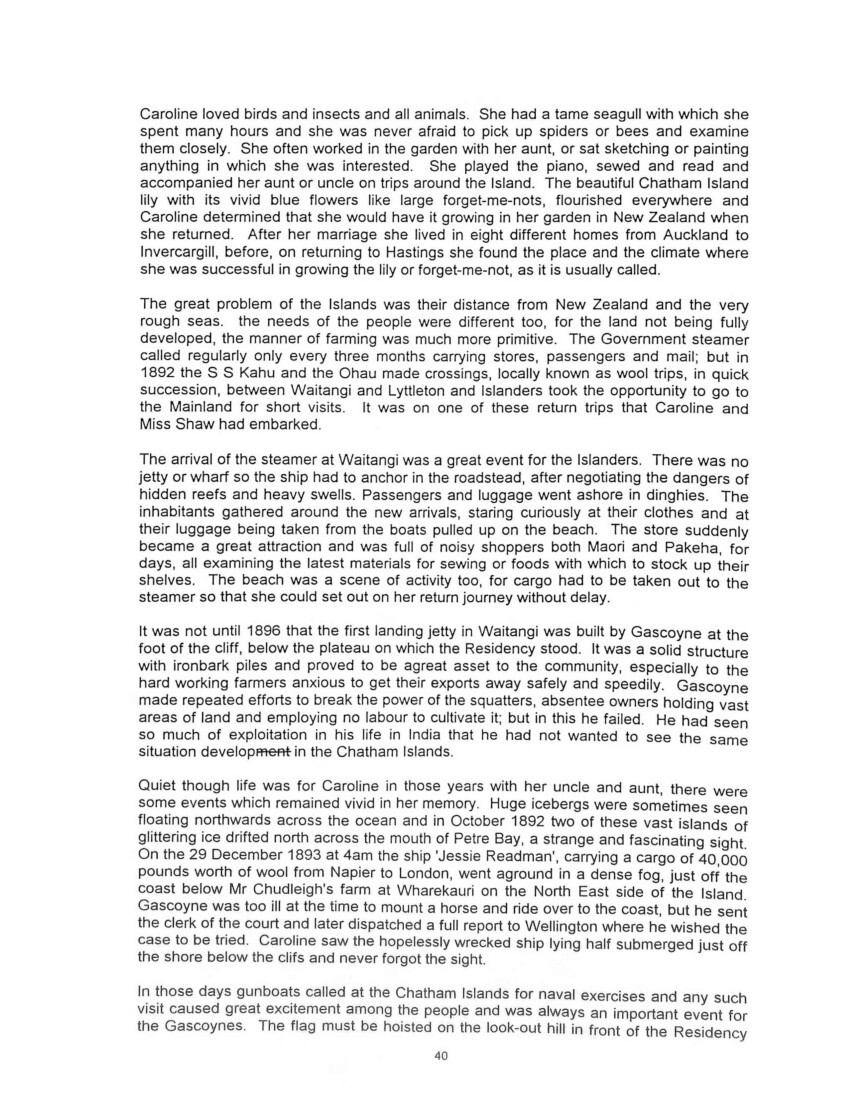
Page 41
and preparations made to welcome the captain and officers. On 28 March 1893, HMS Ringdove anchored five miles off Waitangi, bringing a heavy mail. Two of the officers lunched with the Gascoynes and he accompanied them back to the ship in the afternoon to meet Captain Bain.
The next day, the Gascoynes and their niece lunched on board with the Captain and his wardroom officers, and later were shown round the ship. Captain Bain ordered a cannon to be loaded and invited Caroline to fire it. Standing beside her and putting his hand on hers to encourage her, he ordered that a bottle be thrown into the sea as a target. With the Captain’s help, Caroline pulled the lanyard. The roar that followed was deafening. It went echoing round the cliffs, as if a hundred guns were fired. Caroline was so shaken and bewildered that she was taken to the saloon and given refreshments, leaving on deck a highly amused crew.
On another occasion when a big ship had anchored out in the bay, and all the Islanders had come down to the beach to welcome the important visitor coming ashore in the dinghy, Major Gascoyne, having greeted his guest, was leading him away when the latter said he would like to meet one of the Maori Chiefs. As Paina Te Poki was at that time chief native among the Maori, Gascoyne had already ascertained where he could be found quickly. So it was only a few minutes before the old man was smiling and courteously bowing before them and being introduced to the guest. As they stood talking in a little circle of people everyone began suddenly to look very embarrassed and cast furtive glances around. They had become aware of a dreadful smell about the old chief. He was wearing an extraordinary cap, and trying not to appear discourteous, the guest asked him what it was made of. The man explained it was that it was the skin of a wildcat which he had trapped and killed. He had made it into a cap and, in order to ensure that it would fit well, he had immediately put it on, and there it remained, so that it could not shrink as it dried.
The Gascoynes received many visitors while they were in the Chathams, and one of their favourites was Bishop Julius who came over from Christchurch in the course of his duties, and had to remain a long time with them because the ships called so seldom. It was difficult to know how to keep him happily occupied. He was very interested in clocks and skilful at mending them. So as soon as they had word of his coming, Mrs Gascoyne and Caroline would ride all over the Island collecting the broken down clocks and watches for him to mend. He had a dreadful trip over on the ‘Kahu’ on one occasion. The sea was so rough that for his own safety the Bishop had to be battened down below deck with a cargo of pigs, and he was very ill indeed. After that experience he preferred to make the voyage in the Government steamer.
There were many interesting settlers living in the Islands and Caroline visited their homes with her aunt and uncle, and these visits were returned. There were the Papens at Whangaroa, the Chudleighs at Wharekauri – Mr Chudleigh was a Justice of the Peace and a former army man who was highly respected and whose daughter Effie befriended my mother. Then there was Alex Shand, a recognized authority on Maori traditions and history; and Mr Engst, the last survivor of the two or three German missionaries who were among the first white men to make home on the Chathams. And there was Captain Hood, who after a life of trading between the Islands and New Zealand, had bought a fine property on the Island which he farmed not very successfully, finally landing in the bankruptcy court. Mr Hunt, an Englishman, was the first white farmer in the Islands. He bought land at Pitt Island, cultivated it, grew vegetables and raised sheep and cattle, working incredibly hard in primitive conditions and finally making his fortune. There were others too, and many fine Maori. I have already mentioned the old chief Te Poki who, after initial hostility, came to trust Gascoyne and regard him as a
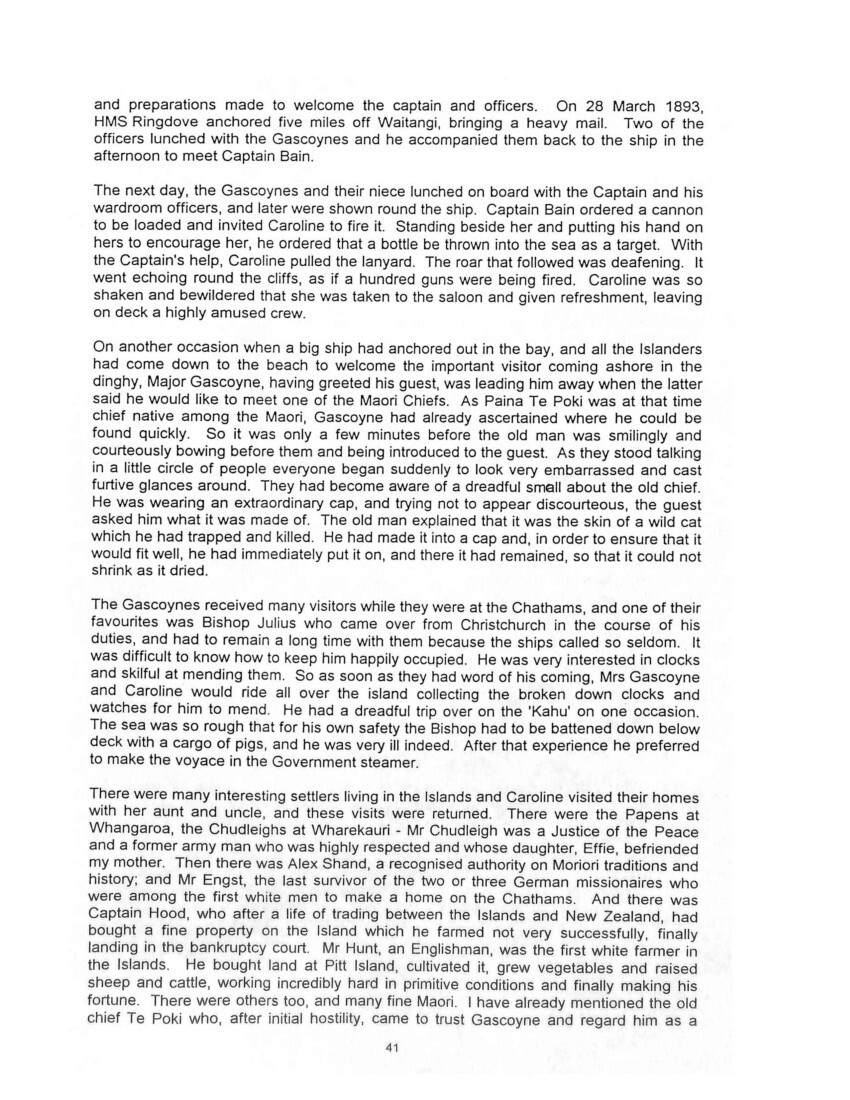
Page 42
friend. I must mention too, Pomare and Solomon, the latter the most progressive of all the Maori farmers and whose son Tommy Solomon was the last of the fine old Moriori race.
At the end of January 1895 news was received that his Excellency the Governor, the Right Hon. The Earl of Glasgow, would visit the Island during February, so Gascoyne called a public meeting to arrange a good reception for him. The Government steamer ‘Hinemoa’, Captain Fairchild, arrived on the 19 February with Lord Glasgow on board and the assembled population gave him a loyal reception with speeches of welcome from both races. After a visit to the residency his Excellency offered to give the Gascoynes a trip to New Zealand. This invitation they accepted joyfully and they began at once to pack. The next day Lord Glasgow and his suite lunched with them to meet the principal settlers, and after seeing the regatta arranged in their honour they and their passengers all went aboard the ‘Hinemoa’. Early in the morning they steamed round to Te Wakaru to call on Mrs Shand, the widow of the first magistrate of the Chathams. It blew so hard during the night that they took shelter under the lee of Waikeri Point. Next morning they steamed round to Owenga on the East Coast and lay to, as his Excellency wanted to see Tapu, the last of the very old men of the Moriori race.
They left the ‘Horns’ for Lyttleton in fine weather but during the night heavy seas were encountered and the ship rolled so much that all three lady passengers were very ill. They arrived in Lyttleton on 24 February at 10am. It had been decided that Caroline would remain in New Zealand as the sea air of the Islands was not agreeing with her. So she returned to her home in Waimate. Major and Mrs Gascoyne spent an enjoyable month visiting relatives and friends and attending to business matters. Gascoyne found his interviews with the Justice Department officials depressing, and felt sure that they meant to keep him at the Chathams as long as possible. On 1 April they returned to the Islands, arriving on the 4th, after a miserable rough passage which made them all weak and ill. They received a warm welcome however, and the old life was resumed.
Gascoyne’s bridge over the Waitangi had been completed in November 1894 before his trip to New Zealand. The men working on it had not previously done any bridge building so Gascoyne had had to be Clerk of Works and superintend every detail and explain the right position of every brace and bolt used in the construction. In July of 1985 there was a severe hurricane and tremendous seas, but though the waves ran up the river as far as the new bridge, it withstood the combined force of wind and sea without damage to it. By the end of the same year Gascoyne had completed the new jetty; but by this time his health was so bad that he knew he must give up his post.
He resigned in 1897 on a very small pension and went to live in Hawke’s Bay. There he had five acres of land he cultivated in an effort to eke out a living. He had accomplished a great deal in his life and it is a pity he was treated so miserable by officialdom.
Meanwhile Caroline was with her family again; but she missed her uncle and aunty so much and felt too that after such a long time away it was difficult to adjust to the different life and that her place in the home having been usurped by her sisters, there was not enough for her to do. She wrote therefore to her uncle and aunt in Hastings, pleading with them to let her live with them again. They were delighted, and when her parents consented somewhat reluctantly to their request, Caroline was welcomed back in their household. Miss Shaw was still with them and Caroline soon settled down happily. She was 26 years old when she married, and after her first child was born, her husband was transferred to Auckland. Her aunt, Marion Gascoyne, died a few years later but the Major lived to be a very old man, despite a heart disease of long standing. His sister,
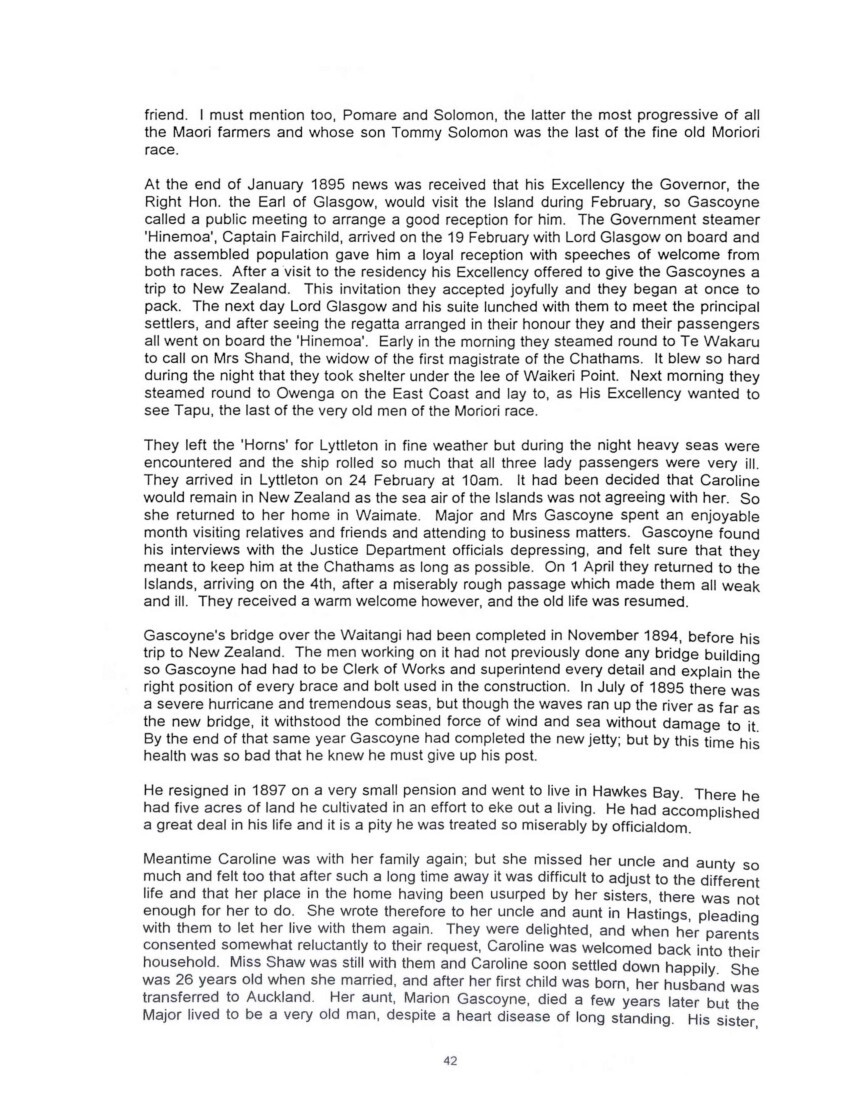
Page 43
Mary Gascoyne, went to take care of him in his last years when he was alone, and outlived him by several years.
There are no longer in New Zealand any of this line of the Gascoyne family to carry on the name but the blood of Isabelle and Charles still runs in the veins of their descendants on the female side, who we hope, will have inherited some of the courage and adventurous spirit of their forebears.

Non-commercial use

This work is licensed under a Attribution-NonCommercial 3.0 New Zealand (CC BY-NC 3.0 NZ).
Commercial Use
Please contact us for information about using this material commercially.Can you help?
The Hawke's Bay Knowledge Bank relies on donations to make this material available. Please consider making a donation towards preserving our local history.
Visit our donations page for more information.
Description
Only the names of people with Hawke’s Bay connections mentioned in “People” list – HBKB
Subjects
Tags
Format of the original
Book paperbackDate published
1992Creator / Author
People
- Arthur Gascoyne
- Caroline Gascoyne
- Emily Gascoyne
- Frederick Gascoyne
- Harry Gascoyne
- Alex McLean
- Sir Donald McLean
- Sir Douglas McLean
- Duncan McLean
- Mr Strang
- Colonel Whitmore
- Majors Briggs, Fraser











Do you know something about this record?
Please note we cannot verify the accuracy of any information posted by the community.